


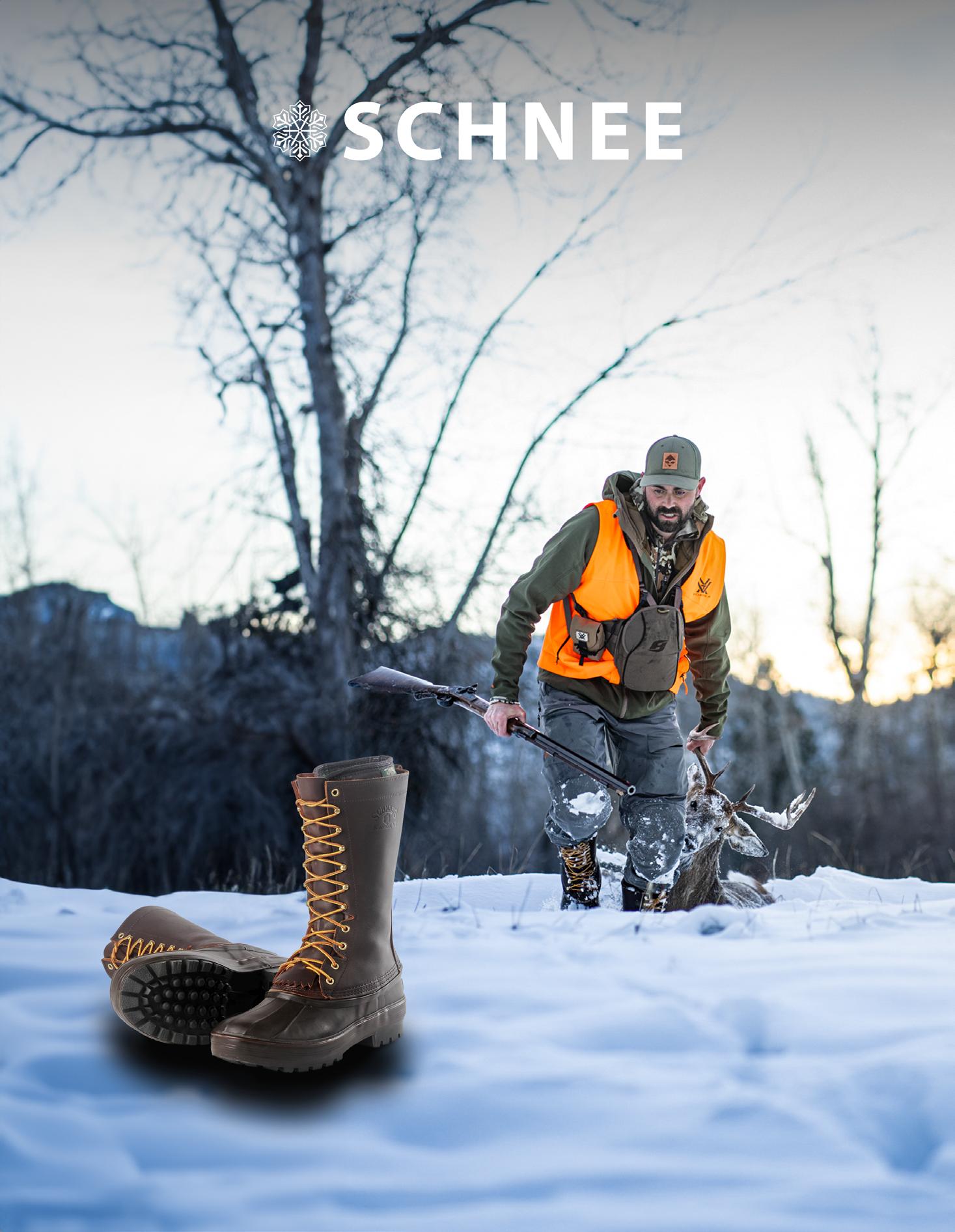



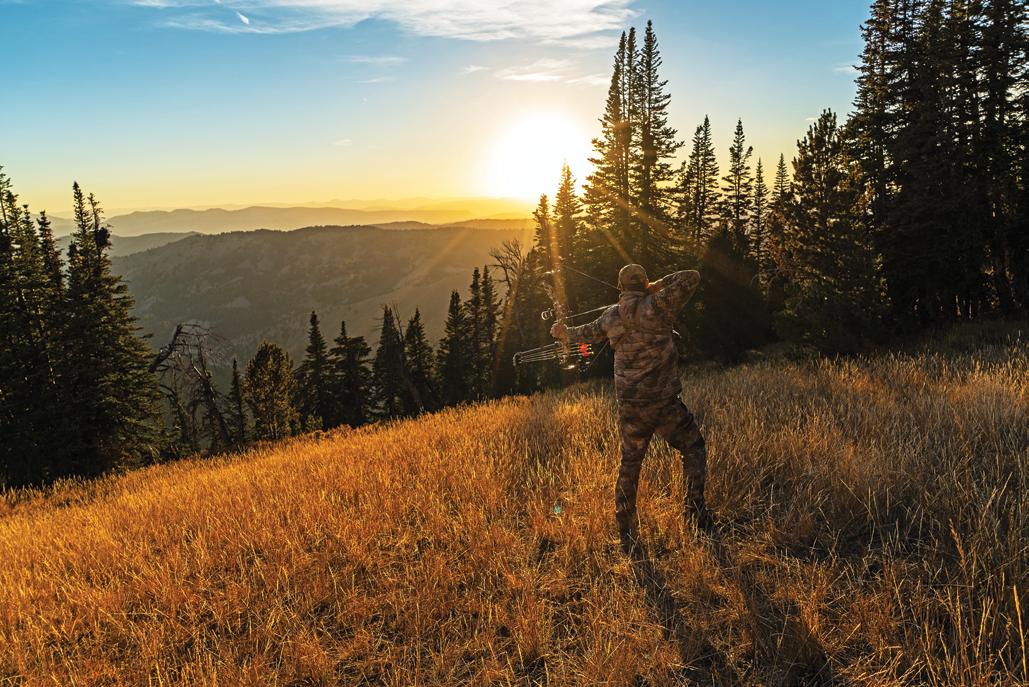
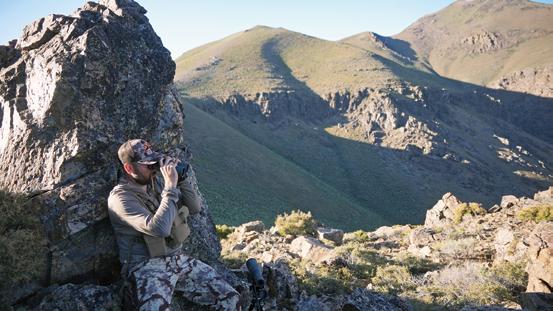






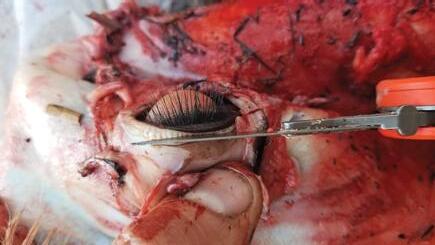

www.westernhunter.net 4 WESTERN HUNTER Sink or Swim Waiting on Wyoming Once-in-a-Lifetime... Again! The Greatest Race Three for One Toe Dragger 22 ADVENTURE WHM Our readers share their best stories VOLUME 23 • ISSUE 2 • MARCH/APRIL 2024 INFORMATION Insights for the Western Hunter GEAR TACTICS INFORMATION ADVENTURE Western Hunter Magazine • 16851 E. Parkview Ave., Fountain Hills, AZ 85268 • 480-993-6972 • Copyright ©2024 Western Optics Hunter • All rights reserved. 6 From the Publisher ~ Chris Denham 44 Gear & Product Highlights: ~ WH Staff 86 Health & Fitness: Hiker’s Hooves ~ Matt Ward WHM DEPARTMENTS More information for your hunting arsenal 90 Health & Fitness: New Year New You ~ Lindsay Persico 94 WHM Featured Artist: Kelsey Rae Morris ~ Pedram Parvin Kifaru Ark Pack Frame ~ James Yates 40 Archery Ballistics: Part 1 54 Who’s Afraid of the Big Bad Wolf? ~ Mike Duplan 62 Tick Aware: Information to Stay Safe ~ Cody Barnes 74 Skinning and Fleshing A-Z – Part 2 ~ Nick Gehring 80 50 Baiting Bears: Extend Your Season ~ Kyle Greene 68 36 North American Super Slam: Muskox ~ Fred Eichler 84 96 The Wild Kitchen ~ Lindsay Persico 98 Dialing It Back ~ Chris Denham




As hunting season slows down, the show season is heating up. As I write this, I have been to multiple hunting shows with just the Western Hunting and Conservation Expo left to attend. I have spoken with hundreds of Western Hunter subscribers, and without exception, they have all been incredibly complimentary. But as I think back on these conversations, I realize that I made the same mistake every single time. I never asked, “What can we do better?” We all appreciate a compliment, but the only way we can get better and continue to ask for your hard-earned dollars is to work on our weaknesses.
If you are subscribed to our email newsletter (it is free, just go to westernhunter.net to sign up), then you should have received a survey from us with a few questions about your experience with the magazine. I am begging you to please be as critical as you can tolerate, we truly need and want your input!
I would say the most common theme from those I have spoken with is the diversity of content in each issue. This issue will not disappoint! If you are looking for a place to start, I would suggest reading Mike Duplan’s article detailing the politics behind the introduction of wolves in Colorado on page 62. Hopefully, it will make you more than just angry. We hope it will inspire you to get involved in the politics of wildlife management!
For the last few years, Nate Simmons and I have been asking ourselves the same question multiple times each year: “Which hunts are we taking for granted right now that are OTC or easy to draw?” The one answer to that question that hasn’t changed is bear hunting. Spring and fall bear hunts are still readily available throughout the West, and most tags are easy to secure. Kyle Green’s opening comments about why to bear hunt and, more specifically, why you should consider baiting, are spot on! You can find Kyle’s article on page 68. Before you
head out to the woods, please read Cody Barnes’s article about ticks (page 74) – it could save you a lifetime of grief.
If you are a bow hunter and you haven’t read every article James Yates has written in Western Hunter, then you are missing out on a master class in archery. As a trained engineer, he is a devil for the details and he nails it again in this installment of Archery Ballistics. You can find this informative article on page 54.
Thank you again for subscribing and reading Western Hunter Magazine. If you have comments or suggestions, please feel free to email me directly at chris@westernhunter.net. I promise you will get a response, and all your comments are appreciated.
Chris Denham, Publisher





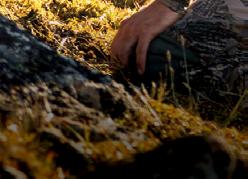

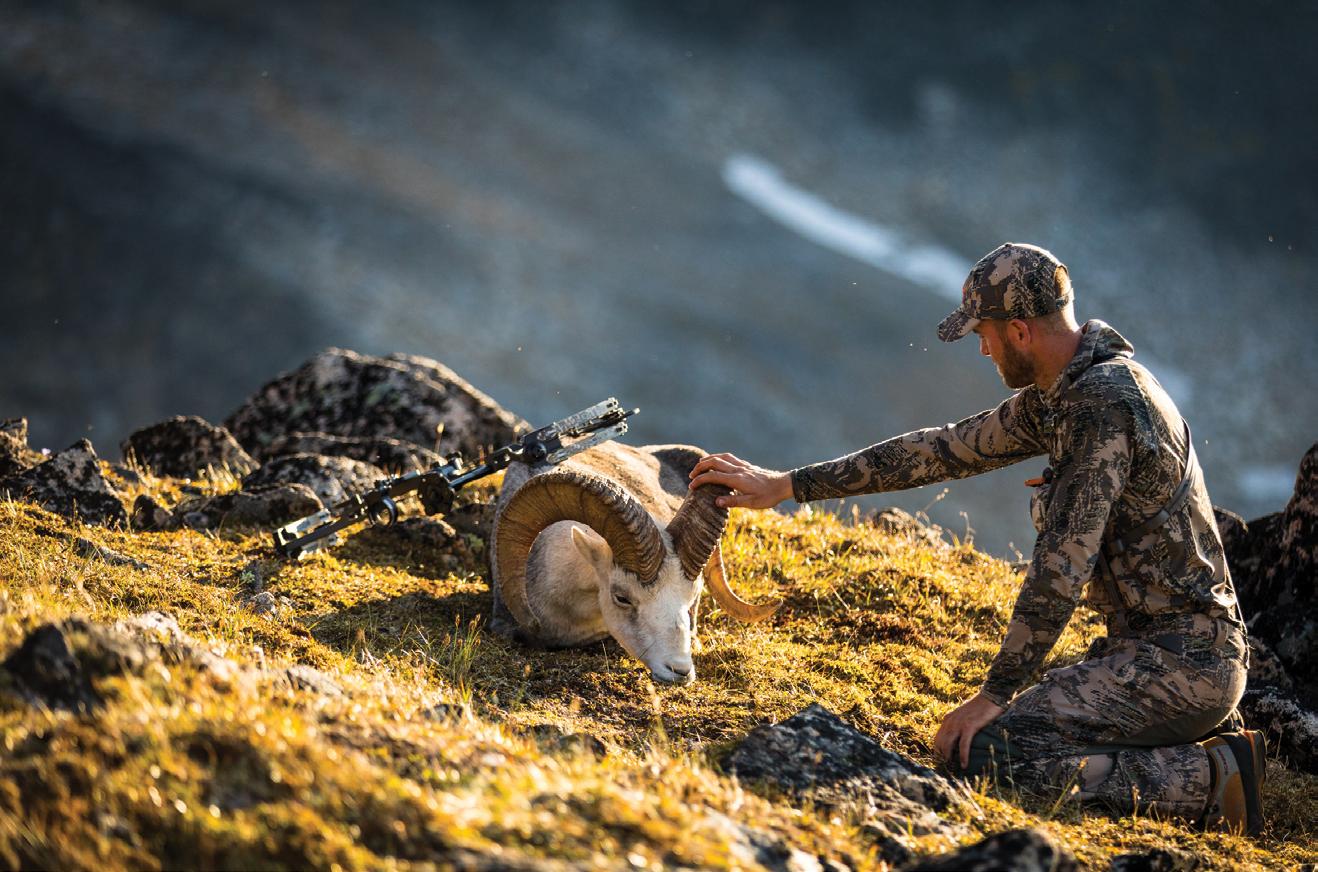
www.westernhunter.net 6 WESTERN HUNTER
MOUNTAIN HUNTING IS WHAT WE DO RAISE AND DIRECT FUNDS FOR WILD SHEEP RESTORATION, CONSERVATION, ADVOCACY AND EDUCATION... WE DO THAT TOO OVER $25.7 MILLION IN THE PAST FIVE YEARS JOIN US! WILDSHEEPFOUNDATION.ORG ANNULI COLLECTIVE | STEVEN DRAKE RESPECT CAN BE HARD TO EXPLAIN, BUT YOU KNOW IT WHEN YOU LIVE IT
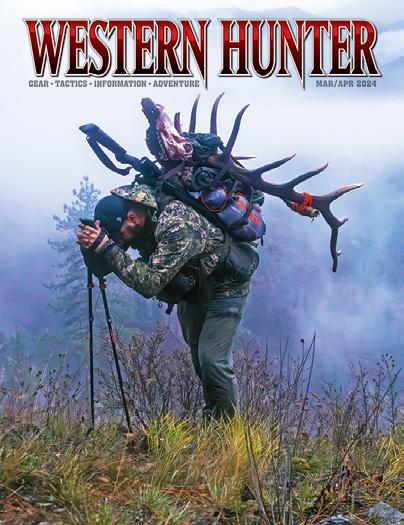
On the Cover: Casey Richmond
PUBLISHERS
Floyd Green, Chris Denham
ASSOCIATE EDITOR/ART DIRECTOR
Randy Stalcup 602-228-4601 randy@westernhunter.net
ASSOCIATE EDITOR
Colton Bagnoli colton@westernhunter.net
MARKETING/ADVERTISING
Chris Denham chris@westernhunter.net
Dave Bond 602-695-8282 dave@westernhunter.net
GRAPHIC DESIGN
Randy Stalcup 602-228-4601 randy@westernhunter.net
EDITORIAL STAFF
Colton Bagnoli – Shooting/Gear/Hunting Editor
Nate Simmons – Backcountry Editor
Remi Warren – Hunting Editor
Mike Duplan – Hunting Editor
George Bettas – Hunting/Conservation Editor
Fred Eichler – Hunting Editor
James Yates – Archery/Hunting Editor
Kyle Greene – Hunting Editor
Nick Gehring – Taxidermy Editor
Lindsay Persico – Health & Fitness Editor
Matt Ward – Health & Fitness Editor
FIELD EDITORS
Cody Barnes, Dave Bond, Ben Britton, Mark Denham, Kevin Guillen, Douglas Morales, Pedram Parvin, Levi Sopeland
CONTRIBUTING WRITERS
Casey Richmond, Scott Bustos, Brian Goble, Talon Tuttle, Vince Castle, Matthew Ritchie
WESTERN HUNTER MAGAZINE
16851 E. Parkview Ave., Fountain Hills, AZ 85268 480-993-6972 info@westernhunter.net www.westernhunter.net
Copyright
Printed in the USA

info@westernhunter.net 7 WESTERN HUNTER
©2024 Western Optics Hunter. All rights reserved.
 The backcountry float hunt of a lifetime
The backcountry float hunt of a lifetime
WHM
Casey Richmond Idaho - 2023
This hunt had everything you’d wish for in a backcountry adventure. Between backcountry
flying, whitewater rafting, and a lot of hiking, it was nonstop action. I was lucky enough to go on this trip with the guys from Limitless Outdoors who I have been looking up to for years. If you’re familiar with Limitless Outdoors then you already know what I’m talking about, but if you haven’t checked out their YouTube channel, you’re in for a treat. Justin Gibbins, Colton Gibbins, and their friend Joshua each had deer tags and I had an elk tag, so we knew there was a good chance we’d be coming out of this trip with some animals.
We started off the trip by flying deep into the Idaho backcountry. Justin is a pilot and he, along with our friend Tim Freeburg, found a small weather window to shuttle us and our gear to an airstrip along the river.
Budget-Friendly Float
Early the next morning we hopped into our economical “Intex Mariner 4” raft purchased from Amazon and set off for a six-mile whitewater adventure to get into the area that we planned on hunting. I had never whitewater rafted, so it was all new to me, and I was excited to try a new way to explore the Idaho backcountry. The water was higher than normal for November, thanks to the three inches of rain the day before.
Shortly after we began, Colton had one of the paddles get caught in some rocks and the paddle snapped off, leaving our raft with just a single pad dle, which made things a little trickier. With two paddles you can slow your raft and steer through the obstacles, but with one paddle, you had to charge faster with hardly any control through the rapids. We had a lot of laughs while we rafted down

Welcome Distraction
Our original plan was for all four of us to leave the river and hike up around 3,000 vertical feet to set up a spike camp, but plans quickly changed after Justin spotted a big group of cow elk with a single good-looking bull right after we had started hiking. Justin and Joshua pushed on up the moun
With the cows beginning to get up to feed, we knew we wouldn’t have much time to get into a different position; we knew this was our only chance.”


info@westernhunter.net
n Casey takes time to admire his backcountry 8x8 bull.

I have made the mistake of ditching my pack many times and ended up miles away without any of my gear. I knew there was a good chance I would regret leaving my pack this time as well, but my focus at the time was trying to get into a position to shoot this bull as quickly as possible. As steep as this country was, I knew my pack and gear would significantly slow me down, so I started to climb up toward the group of elk with just one trekking pole and my rifle.
Over in a Moment
After a grueling 1,300-ft climb, we finally got a good look at the bull, and he was way bigger than I expected; we figured he was a mature 7x7. He was in a tough spot to close the distance, and we took our time getting into the best spot we possibly could, which still left us 685 yards away. With the cows beginning to get up to feed, we knew we wouldn’t have much time to get into a different position; we knew this was our only chance. So, we got settled in and ready for the shot.
The rain and fog had been relentless, which made us realize we had to make something happen before the fog rolled back in. After taking a minute to find a stable shooting position in a less-than-ideal spot on the mountain, I felt ready to take the shot. I was positioned on a steep side hill and used my bipod on top of my pack for a front rest and a glassing pad to help support the back of the gun and right arm. With Colton helping on the spotter, I was able to place a 175-grain bullet from my 7 PRC Seekins Precision Element into the bull.
After the first shot, I had so much steam billowing off the suppressor that I had to take a moment to blow it off to be able to see the bull through the scope. I was quickly able to relocate the bull who was clearly hit well but still standing, so I put another round into him which hit him perfectly behind the shoulder. He started to stumble down the hill but dropped into a draw that was out of sight from us. The suppressed shots had the rest of the herd confused and they couldn’t tell where the shots came from, nor did they know why their big herd bull had fallen. The cows ended up standing around in the same spot for over the next hour. This is one reason why I love hunting with suppressors, especially SilcencerCo’s new Scythe-Ti suppressor.

I couldn’t believe we made it happen on the first day. This was the biggest bull of my life. It took a moment for it to set in that we had actually made it happen. I was ecstatic! The previous month I had struggled a lot on an elk hunt, and I was picturing this hunt would be similar. But there I was, not three hours into the actual hunt, and I already had a giant bull down. Most hunts don’t go as planned, and after many years of experience, you learn to not get too excited until the animal is down. I have never had a hunt go as perfectly to plan as this, and it took a while for it to feel real.
Cold and Heavy
Getting the bull down was relieving, but we still had so much work ahead of us before we could feel relaxed. We headed back down to the river and then a mile upriver to grab our packs, and then we went back downriver one mile and then up 2,000 vertical feet to where the bull was down. When we finally reached the bull, we quickly realized this 7x7 was really an 8x8! This bull also had the largest body any of us had ever seen on a Rocky Mountain bull elk. We nicknamed him the “Horse Bull” because of his horse-sized body. After taking some time to admire the bull and the country he lived in, we realized we had a lot of work ahead of us with some gnarly weather about to roll in.
We spent the next five hours cutting up the bull in some horrendous weather, including a lightning storm with hail and snow! Due to the conditions, we needed a fire because the wind was strong and the temps were dropping.

www.westernhunter.net 10 WESTERN HUNTER
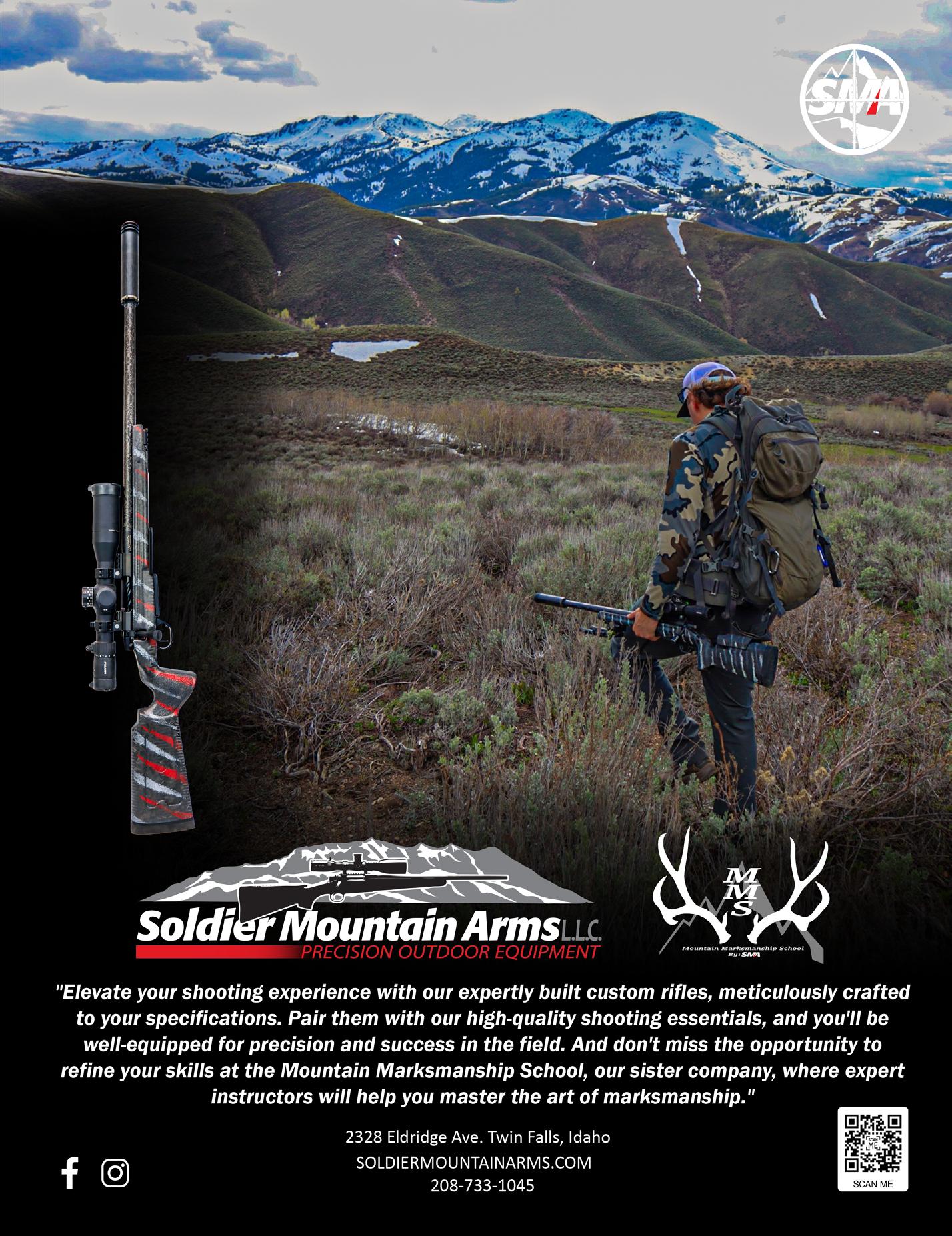
Everything was soaking wet, which made starting a fire nearly impossible. Even with a lot of fire starter, it was one of the most difficult times I’ve ever had trying to start a fire and keep it going. After almost an hour, we were finally able to get a ripping fire and warm our numb hands from time to time while laboring over the bull.
Late that night, we finally made it back down to the river with the first load of meat where we hung the game bags under a tree. We still had a decent hike back to our gear, and we found a place to set up camp and start another fire, which took another 45 minutes. We ate dinner after 1 AM that night and then tucked into our sleeping bags, the only dry piece of kit we still had left. The next day, we had two more grueling trips up the mountain to get the rest of the bull back down to camp.
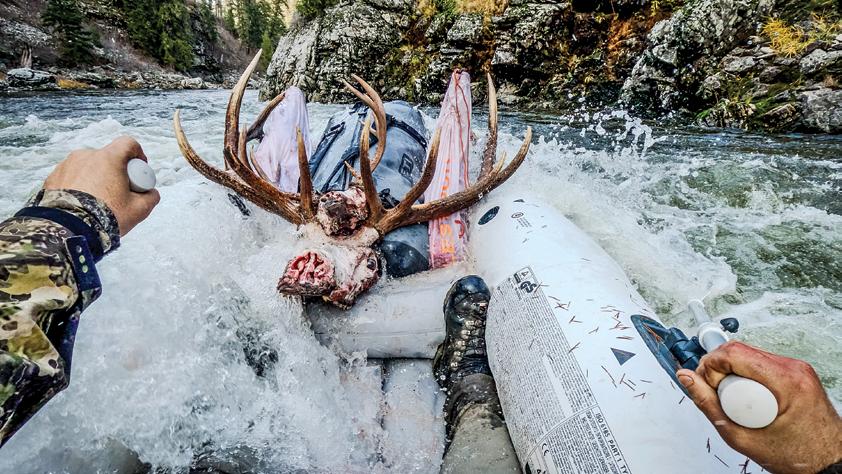
The trip had many elements of success. Around the same time I killed my bull, Joshua ended up killing a nice four-point buck. It was his first ever mule deer buck, and he was happy to get one down. The final day of the hunt, however, was probably the most memorable. The morning started off with Colton killing a monster buck right before we had to head back down to the rafts.
Sink or Swim
While Colton was packing his buck down to the river, Justin had to head to the plane. This meant he had to go down to the river and then make the eightmile hike back upriver to the airstrip where we started the float on day one. He flew his plane to the next airstrip, about ten miles downriver from us. Joshua hiked the ten miles along the river down to where Justin would pick us up. Colton and I were the ones tasked with floating all the gear and animals down to the same airstrip.
We had a huge bull elk, two big muleys, and a whole lot of gear. Saying we were overloaded would be an understatement. Colton and I each got into the rafts, and the first thing we noticed was how much the water level had dropped during the week since we started hunting. There were rapids at almost every bend in the river, and each set of rapids had many exposed rocks. In the area that we were in, the river was full of rocks that were more shale-like and sharp instead of typical, round river rocks.
With shallow water and super heavy rafts, we were ping-ponging and scraping our way down the entire way. For the first couple of hours, we were taking our time to pull off the river and bail out the water after each rapid. Each time we did this, we would both have to unload and load hundreds of pounds of meat and gear, and it was very time-consuming. Eventually, both rafts started tearing bigger and bigger holes, and they were taking on a lot of water even without us in them.
When looking at our maps, we realized we were taking way too much time getting down the river, and if we didn’t pick up the pace we would be floating in the dark. By the halfway point we were both completely soaked head-to-toe and freezing. With darkness setting in, we had to force ourselves to just keep going because we had to make it to the airstrip before sundown. It was mentally exhausting and frustrating navigating the river. With both rafts completely flooded, we had almost zero control to paddle and we were constantly getting high centered in the middle of almost every set of rapids.
There were multiple times when we had to get out of our rafts and dislodge them from a set of rocks while standing in freezing water up to our waists. By the time we reached the airstrip, we were both shaking from being in the water for so many hours. We made it down to the airstrip just in time to grab what we could carry and fly out before it was too dark. Tim and Justin flew us about an hour to a town where we were able to get a hotel and a warm meal. That felt amazing after a freezing and grueling day on the river. Both Colton and I had numbness in our toes even hours after the hot shower, which was pretty telling of how cold we were. The next day, we did multiple flights back in to shuttle out the meat and remaining gear we had left on the river the night before.

CRITICAL GEAR
This hunt turned out to be nothing like I had expected. I still can’t believe how this hunt worked out for us, and I couldn’t thank Justin and Colton enough for inviting me on this hunt. It will truly be a hunt I will never forget.

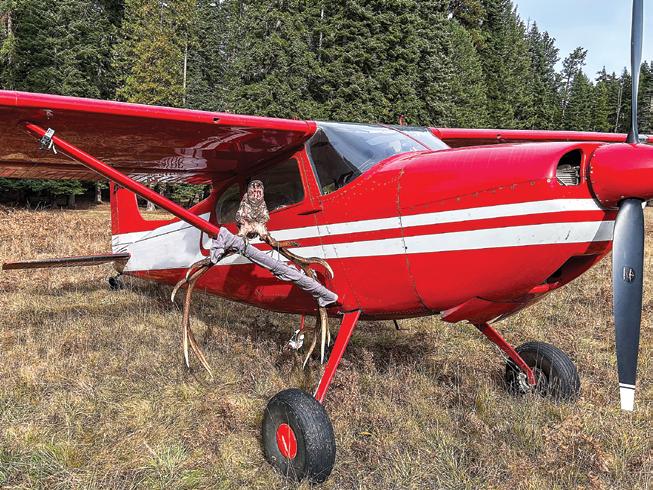
www.westernhunter.net 12 WESTERN HUNTER
Rifle: Seekins Precision Havak Element 7 PRC Suppressor: SilencerCo Synthe-Ti
Clothing: Eberlestock Trinity Peak Jacket 2.0, Eberlestock Pioneer Hoody Pack System: Eberlestock EMOD (Mainframe, Vapor 5000, EMOD Lid and Gamebags)
Bino Harness: Eberlestock Recon Knife: Montana Knife Company Mini Goat
Boots: Crispi Briksdal Pro Headlamp: Peax Equipment Backcountry Duo Supplements: Wilderness Athlete Energy & Focus, Hydrate & Recover
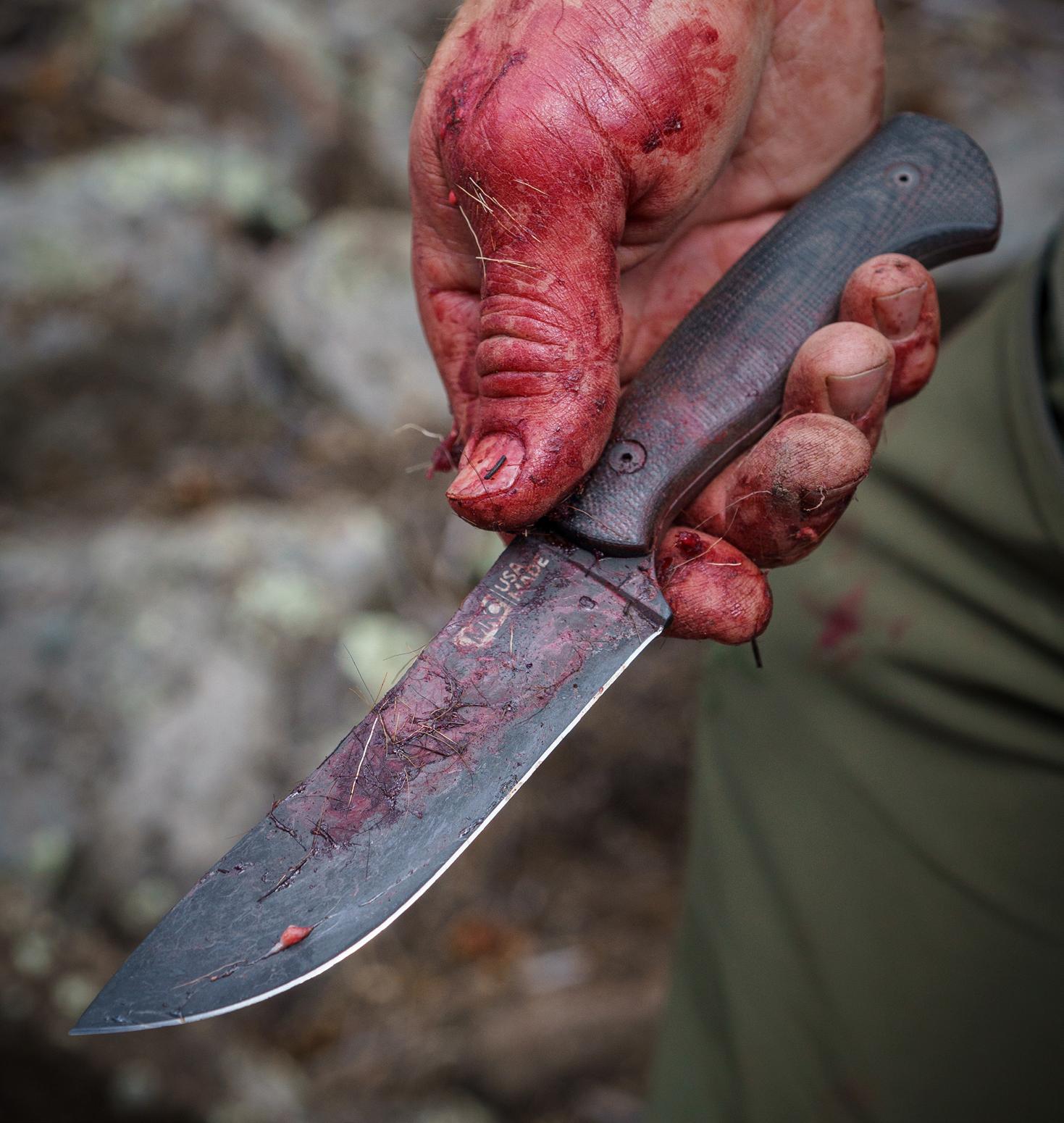


KNIVES DESIGNED BY HUNTERS FOR HUNTERS OWNED BY MASTER BLADESMITH JOSH SMITH WWW.MONTANAKNIFECOMPANY.COM @MONTANAKNIFECOMPANY WARNING: MKC knives are incredibly sharp out of the box and may cause lacerations of the skin if handled improperly. MONTANA KNIFE CO™ KNIFE MODEL: THE STONEWALL SKINNER STEEL: 52100 CARBON STEEL HANDLE: G-10

WAITING ON WYOMING
After years of applying, a couple’s mule deer dreams finally come true
WHM
Scott Bustos Wyoming - 2023
After 17 years of putting in for mule deer in southwest Wyoming, my wife, my friend, and I finally drew our dream mule deer tags. It felt like Christmas on the morning of draw results but we knew that another disappointing morning was most likely ahead. As I waited for the draw results to load, I couldn’t help but stress knowing that we most likely didn’t draw again, but to my surprise, we drew! As soon as I found out, I started telling friends and family members; no one believed me. I’ve always said that if we drew that tag, I would spend all summer trying to learn the area and how

We couldn’t believe how big this one looked. What I thought were big mule deer in the past were nothing compared to this deer. I was trying to get pictures through my spotting scope, and my hands were shaking so badly that I couldn’t find the deer. Finally, I gathered my composure and found him; this was a high-180-class deer. I immediately started making plans to hunt this deer in the upcoming archery season. We found the buck one more time about a week before archery season opened, but we made a mistake; we never sat on the buck to see where he would bed. We neglected the fact that after they strip their velvet, they go nocturnal, and we never saw him again; even with hours of glassing and walking the
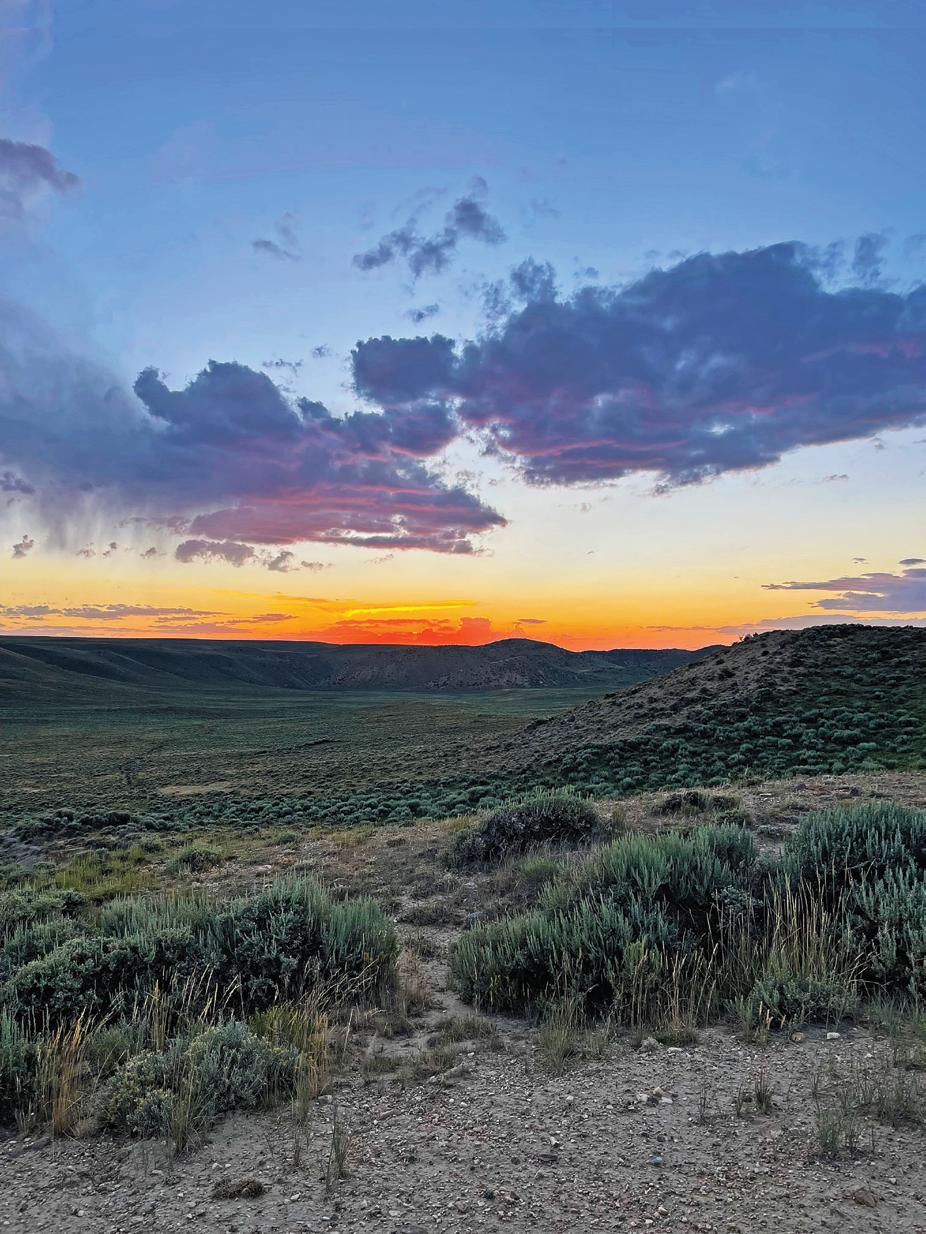
By the time archery season opened it felt like we had been hunting for an eternity. We had a few bucks in mind that we would go after if the big one didn’t work out. It has always been my wife’s dream to get a velvet buck. After glassing multiple entire days, she spotted her buck on a hillside with four other bucks. She made an amazing stalk and closed the distance to 35 yards, drew back, and smoked him! We had our son with us, so we decided to give the deer a few hours before trying to find him. We ran him back to town and picked up my nephew and some flashlights because it was getting dark.
On our way back out to find the deer, we noticed the clouds out in the distance were black and
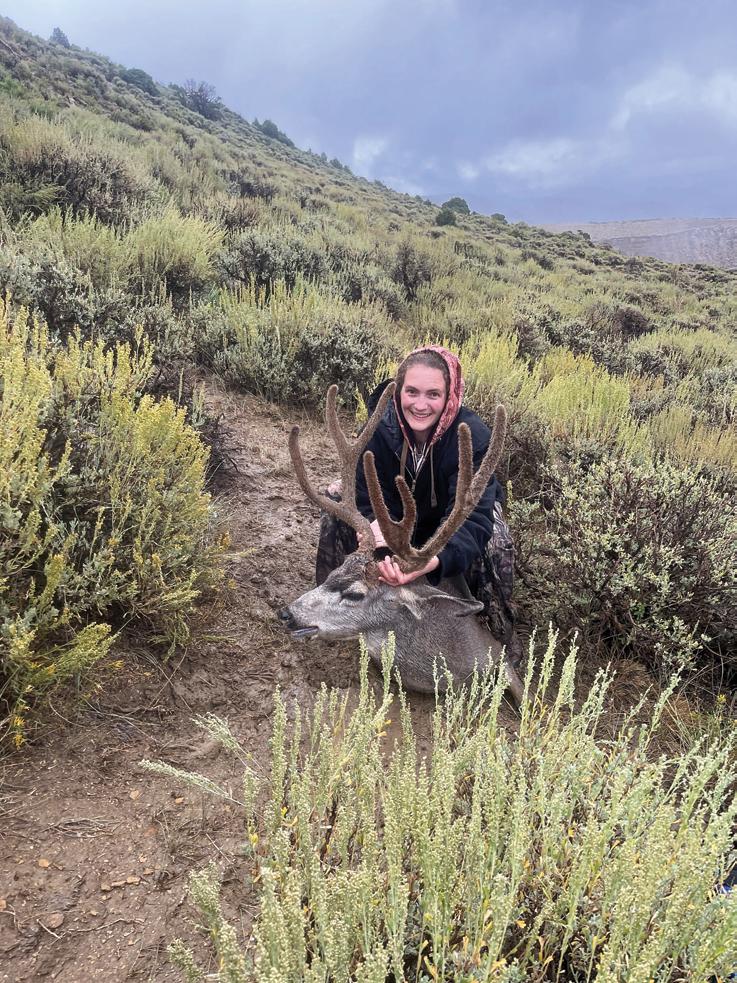 n After finding the buck she wanted, Kaysha made a great stalk and arrowed this great buck.
n After finding the buck she wanted, Kaysha made a great stalk and arrowed this great buck.

and use as traction. My wife walked up the trail and found half of her arrow and a big pile of blood. I was relieved and knew we were getting close. I noticed there were some heavy tracks headed up the hill and decided to stop looking for blood and follow them. About 200 feet later, I called out, “Found him!”
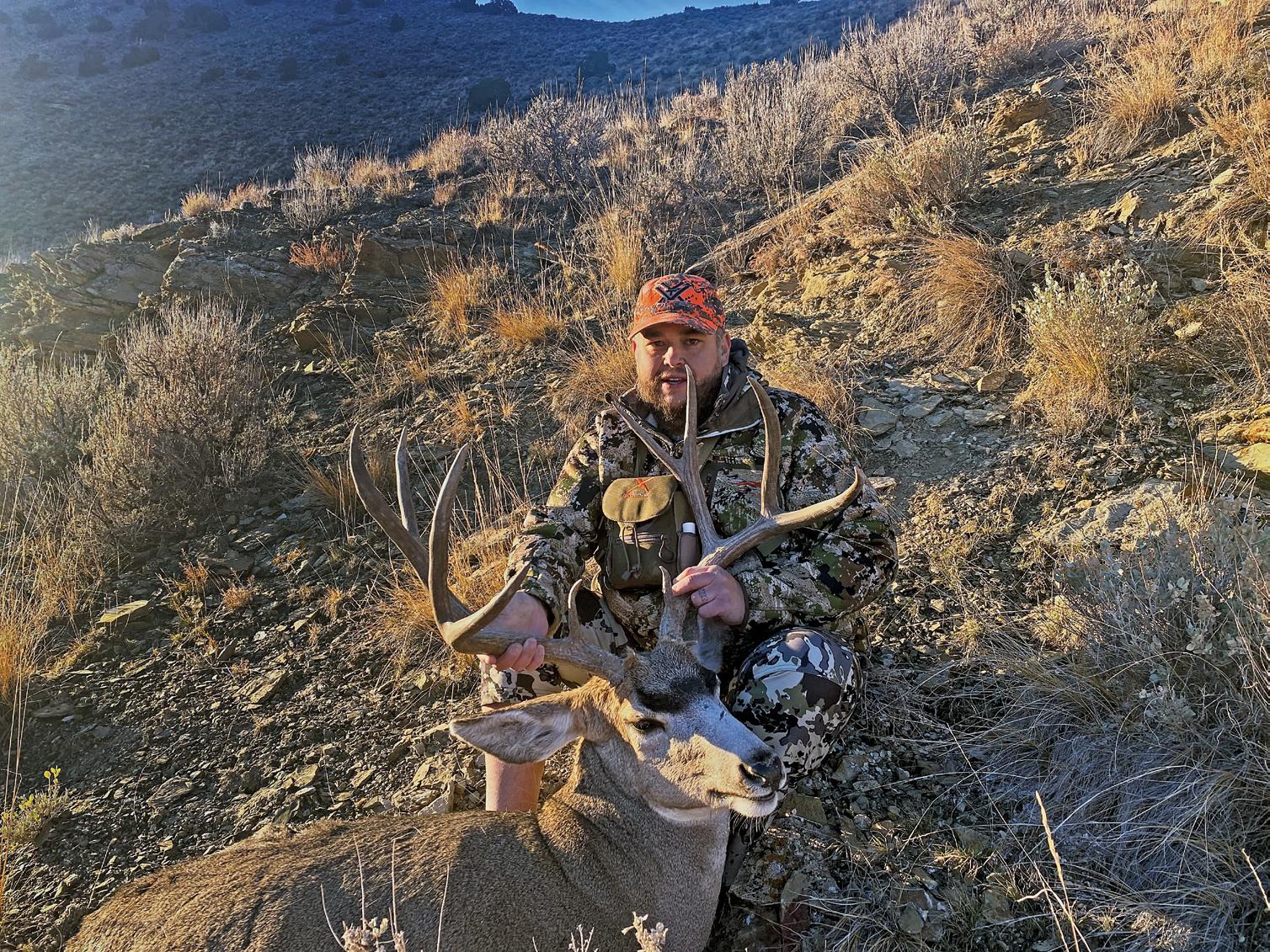
When rifle season opened, we went to a spot where my friend had seen some bigger deer tracks while out scouting. We checked it out and didn’t see anything other than tracks. He picked us up the next morning and said, “We’re going back to that area where we saw those tracks.” I agreed, but I felt like it was a waste of time. We made it to where we saw the tracks without seeing even a doe. As we were coming back out, I spotted three bucks on a hillside
I was trying to field judge him, making sure he was at least a 4x4, but my binoculars were fogging up. It’s amazing how everything tries to go wrong in the moment. My wife got a good look at him and fore they run off.” I got out and shot him at 270 side he was on was very steep, and I had to hold him in my lap and slide down the hill just to get

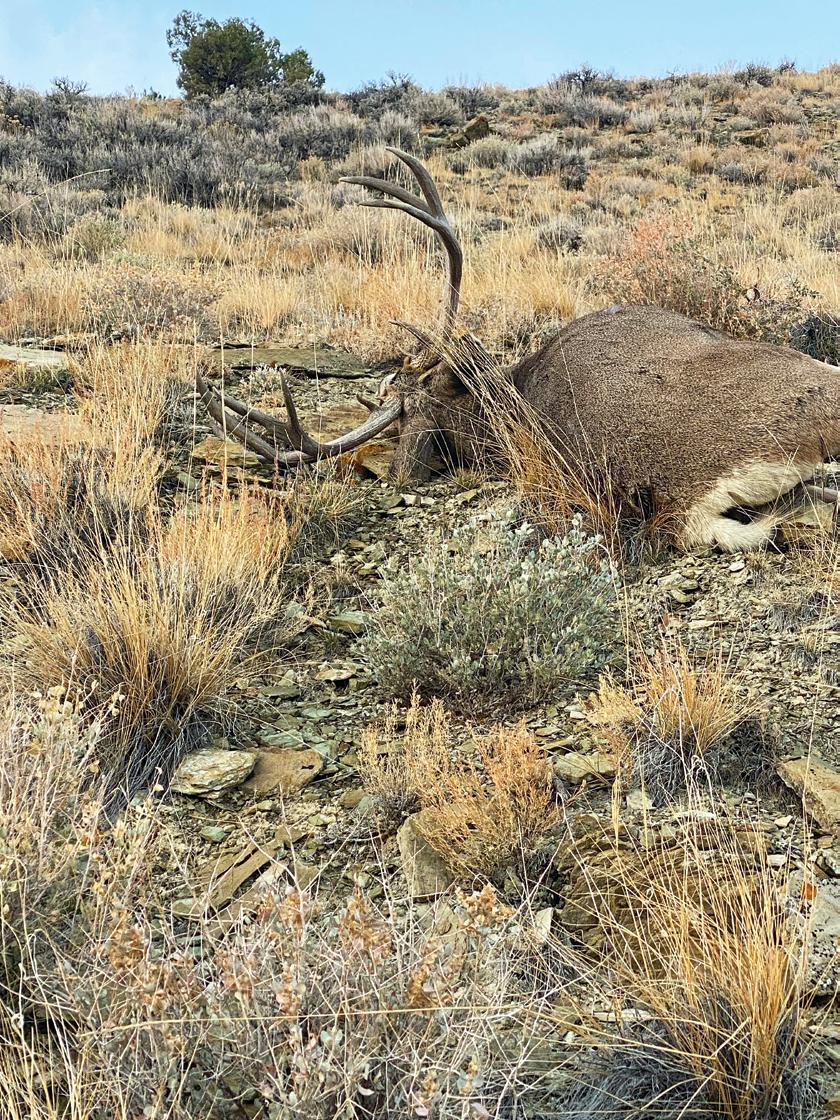
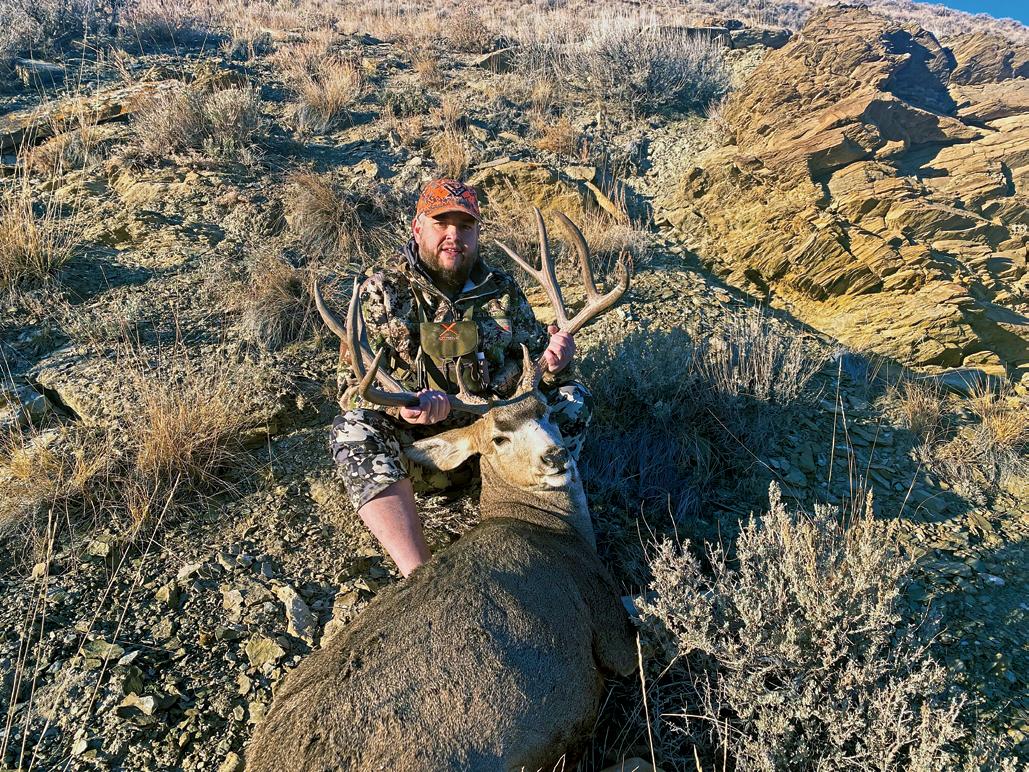
CRITICAL GEAR
Bow: Hoyt Charger Broadhead: Rage Hypodermic
Rifle: Savage 270 Ballistics: Kestrel 5700
Scope: Nightforce SHV 5-20x56MM MOAR Reticle
Rangefinder: SIG Kilo 2000 Bipod: Harris
Spotting Scope: Vortex Razor 20-60x85
Binoculars: Vortex Viper HD 10x42
www.westernhunter.net 16 WESTERN HUNTER
n After waiting 17 years for his mule deer tag, Scott made the most it and took a fantastic buck.
EBERLESTOCK
LAYERING SYSTEM
A SYSTEMATIC APPROACH

The Eberlestock Layering System features fabrics with the best warm-to-weight, waterproofing, and stretch ratings available. Merino Wool base layers, PrimaLoft Gold® insulation layers, and our proprietary HELLBENDER™ tri-layer membrane rain layers all offer supreme performance in their intended conditions.



SCAN TO SHOP OUR LAYERING SYSTEMS
Over nearly 40 years of bowhunting, it came to be that high on my bucket list was the quest for a big lion or bear in my home state of Arizona. In 2016, some friends of mine graciously treated me to a bear hunt with hounds in the ponderosa pine, juniper, and oak country of north-central Arizona, not far from our home.
The first six days of that hunt took place during the August archery season and started off with a bang when the dogs rigged a bear (caught his scent while slowly driving forest two-track roads). We had an exhilarating chase on foot that ended without catching that bear. When the chase ended, I was shocked to check my GPS and find that we were only seven miles from my home. The seventh day of the hunt occurred on opening day of the October general season and resulted in the taking of a beautiful brown color-phased sow. While not a big bear, it was still one that I was delighted to have taken and for which I was grateful to my friends for helping to bring about.
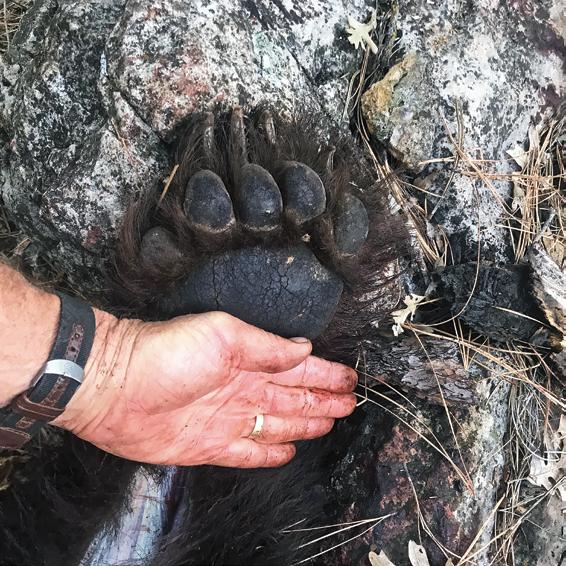
Round Two
As time went by, the desire for a big predator again began to rise within me. In 2018 I pitched a “once-in-a-lifetime” guided lion hunt in southeastern Arizona to my wife Donna and was surprised when her only question was, “When are you going?” Fast forward and that hunt eventually led to 22 days of horseback hunting with my bow behind hounds in the mountainous desert country of southeast Arizona. Many of those days were spent along the rugged boundary of the San Carlos Apache Reservation.
Those long, strenuous days eventually led to the taking of a female lion which, again, although not the big one I’d hoped for, was an animal I was thrilled to harvest with my bow. But... still no big tom or boar. So in 2023, I pitched another once-in-a-lifetime hunt to my wife, this time for a bear, and she was in!
We’re fortunate here in Arizona to have so many great dry ground lion and bear guides and houndsmen. My friend Russ Richardson knew of my desire
WHM
ONCE-IN-A-LIFETIME… AGAIN!

Three exciting attempts to find a trophy predator
www.westernhunter.net 18 WESTERN HUNTER
Brian Goble Arizona - 2023
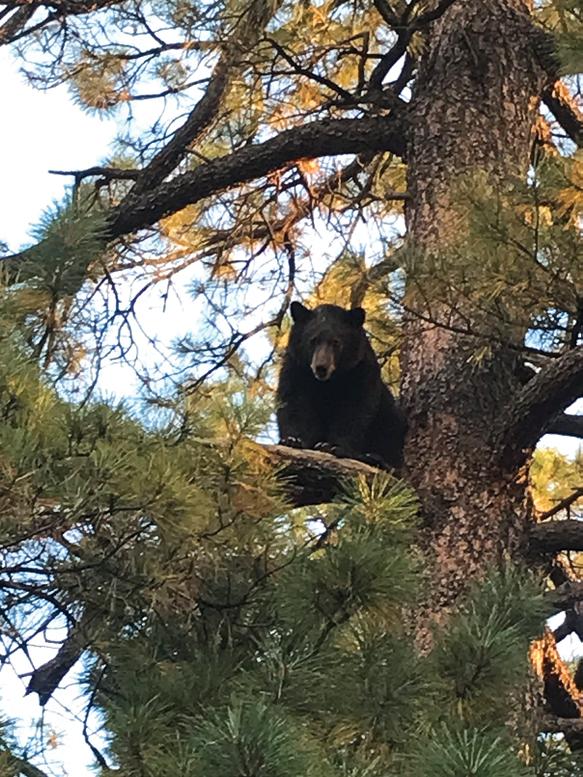
do all they could to help me achieve my goal of taking a big boar with my bow.
Strange Behavior
We began the hunt in the high country of north-central Arizona in early September for two days during the final week of the archery bear sea son. While hunting near the boundary of the White Mountain Apache Reservation, we heard lots of bu gling bulls and saw some nice mule deer, but were without success in our efforts to catch any bears. According to Jim and Donny, the bears at that time of year are still “skinny, long-legged, and hard to catch.” We would resume the hunt once the general season opened in early October. By then, the acorns would be ripe and the bears would be fattening up.

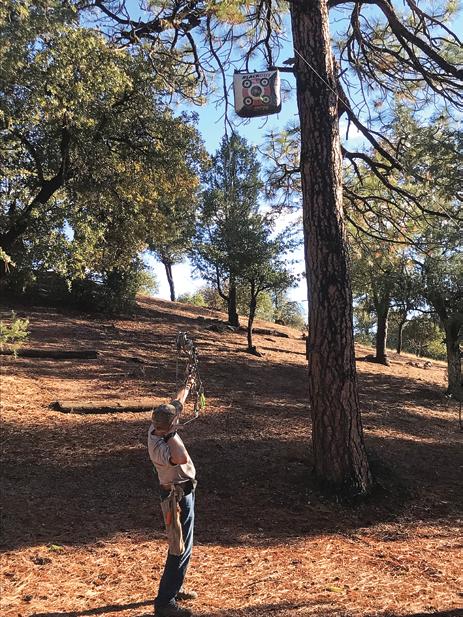
On our first day of hunting the general season, the dogs treed a good-sized boar, but before we could get to the tree, some turkey hunters ran up and shot the bear! Since they had a bear tag and a legal weapon (bears cannot be hunted with shotguns), yes, it was legal. But ethical...? As this appeared to be a boar that would have met the minimum entry requirements for both the Bowhunting in Arizona and Pope and Young records programs, it was disappointing, to say the least. Public land... what can you say? (I do seem to recall that Jim did come up with a few things to say!)
Early the following morning, as we approached a water tank where there was an elk carcass, the dogs rigged and caught the scent of a bear that had recently visited the tank. It took those veteran hounds less than a half-hour to tree a good-sized boar. For 20-30 minutes we scrutinized and discussed whether this bear was the one I was looking for. Ultimately, since we couldn’t be sure, I opted to pass. Later that afternoon, we caught a similarly sized bear and again passed.
50/50
The following morning was the fifth day of our hunt, and we returned to the tank where we had found the tracks of the bear that we had passed on the previous evening. As we walked around the water, we found two fresh sets of tracks made during the night. One set was small, and the other was huge! Unfortunately, due to the rocky and pine-needle-littered forest floor, the direction in which either bear had left the tank could not be determined. As such, when the dogs were turned out, we didn’t know which bear they were trailing or if they were going in the right direction.
Regardless, the morning in the rugged ponderosa forest was cool, and the dogs were able to trail at a fast pace. Coming up out of the canyon where the tank was located, we moved quickly across a ridge and stayed within earshot of the dogs nearly the entire half-mile-plus, 20-minute trail. It was only when the bear and dogs had crossed over the ridge into the next canyon that we lost hearing of the chase, but the bear treed soon thereafter. Donny ran ahead the last 200 yards to be sure all was well with his dogs.
info@westernhunter.net 19 WESTERN HUNTER
n The first of two boars that Brian passed on the day before taking his bear.
n Brian’s Arizona bear measured 29-11/16" following the mandatory 60-day drying period. following
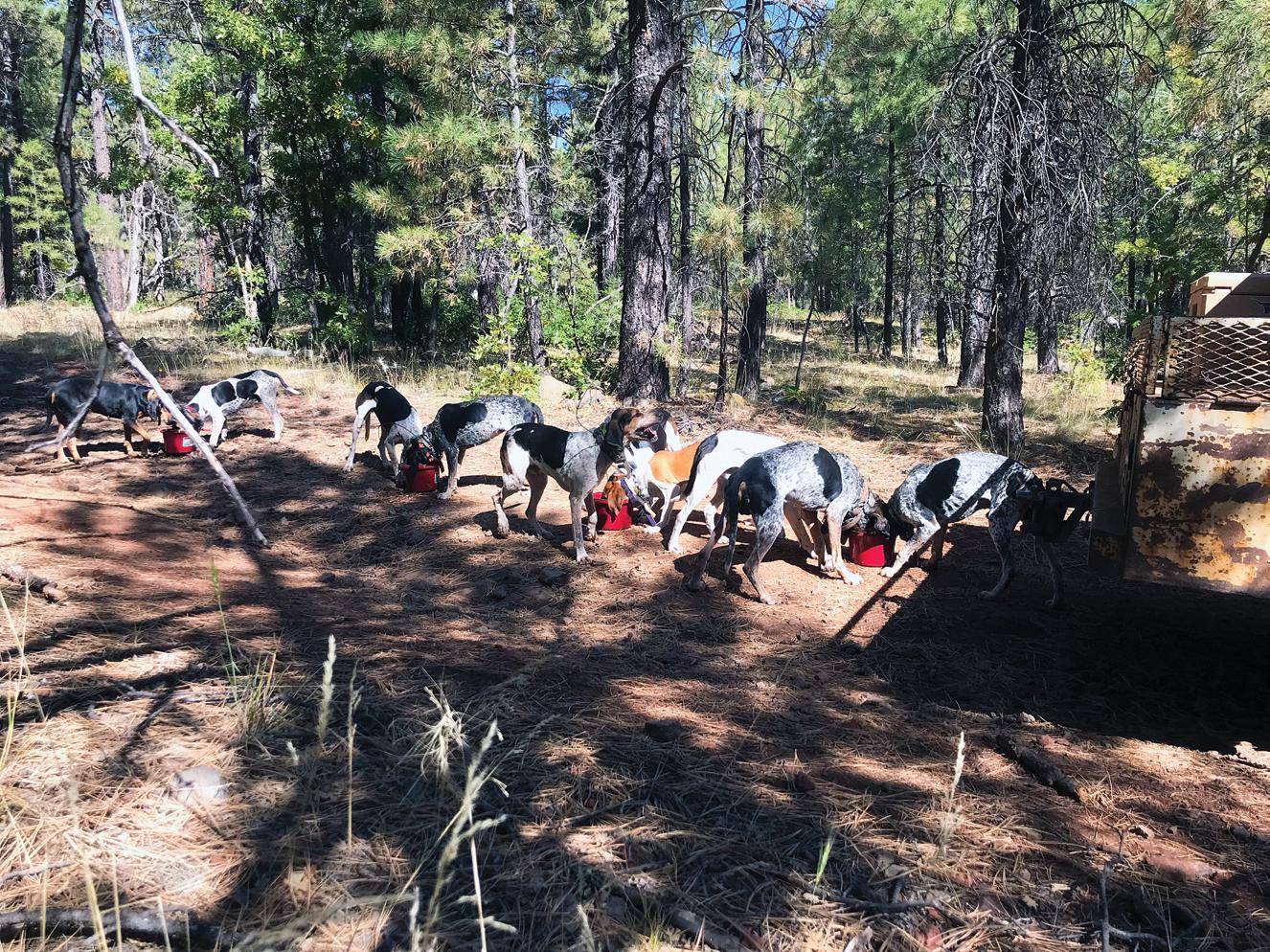
Once all was ready, I released the first arrow from 13 yards into the right side of the bear which was about 30 feet up the tree. The bear gave no great reaction other than to climb 10 feet higher and move to a limb on the other side of the tree. I moved to the other side of the tree and made a 23yard shot again into the right side of the bear. This time the bear moved to another limb, once again on the opposite side of the tree. The third arrow from 15 yards was into the left side of the bear and caused a bear explosion!
He began to aggressively descend out of the tree with bark and limbs flying. I heard Marcus yell, “Get the pistol ready!” (The guides carry pistols for the ultimate protection of the dogs and hunters, if needed). I quickly nocked another arrow and sent it into the back of the bear as he was about 10 feet off the ground, 12 yards in front of us and descending quickly. Fortunately for the hunter and guides, the



20 WESTERN HUNTER
Bow: PSE EVO NXT 33
Arrows: Gold Tip Hunter Broadheads: SEVR 1.75 Rest: QAD Ultra-Rest HDX
GEAR
Sight: Axcel Rheotech Release: Carter Quickie Rangefinder: Nikon Pack: Badlands
CRITICAL
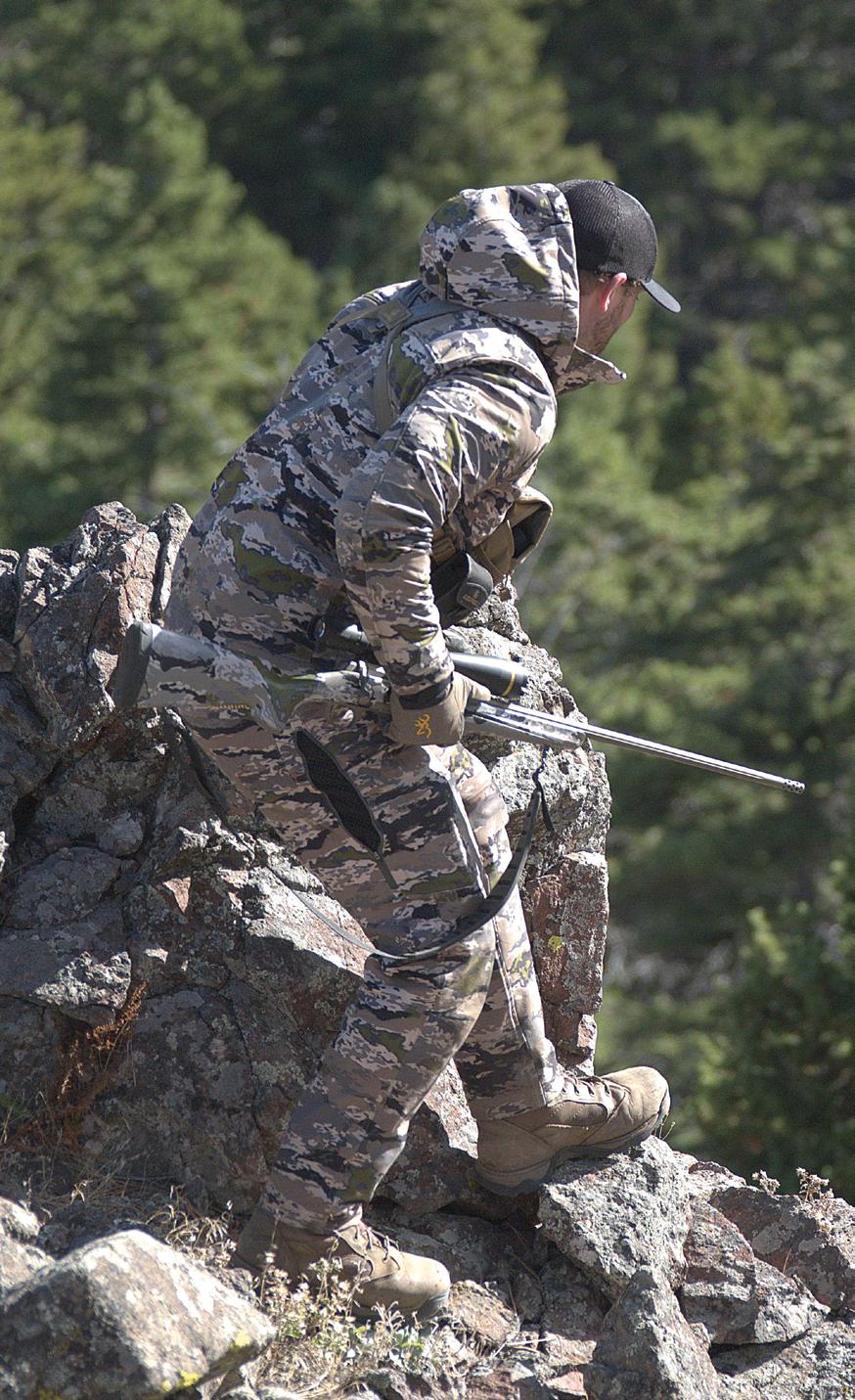
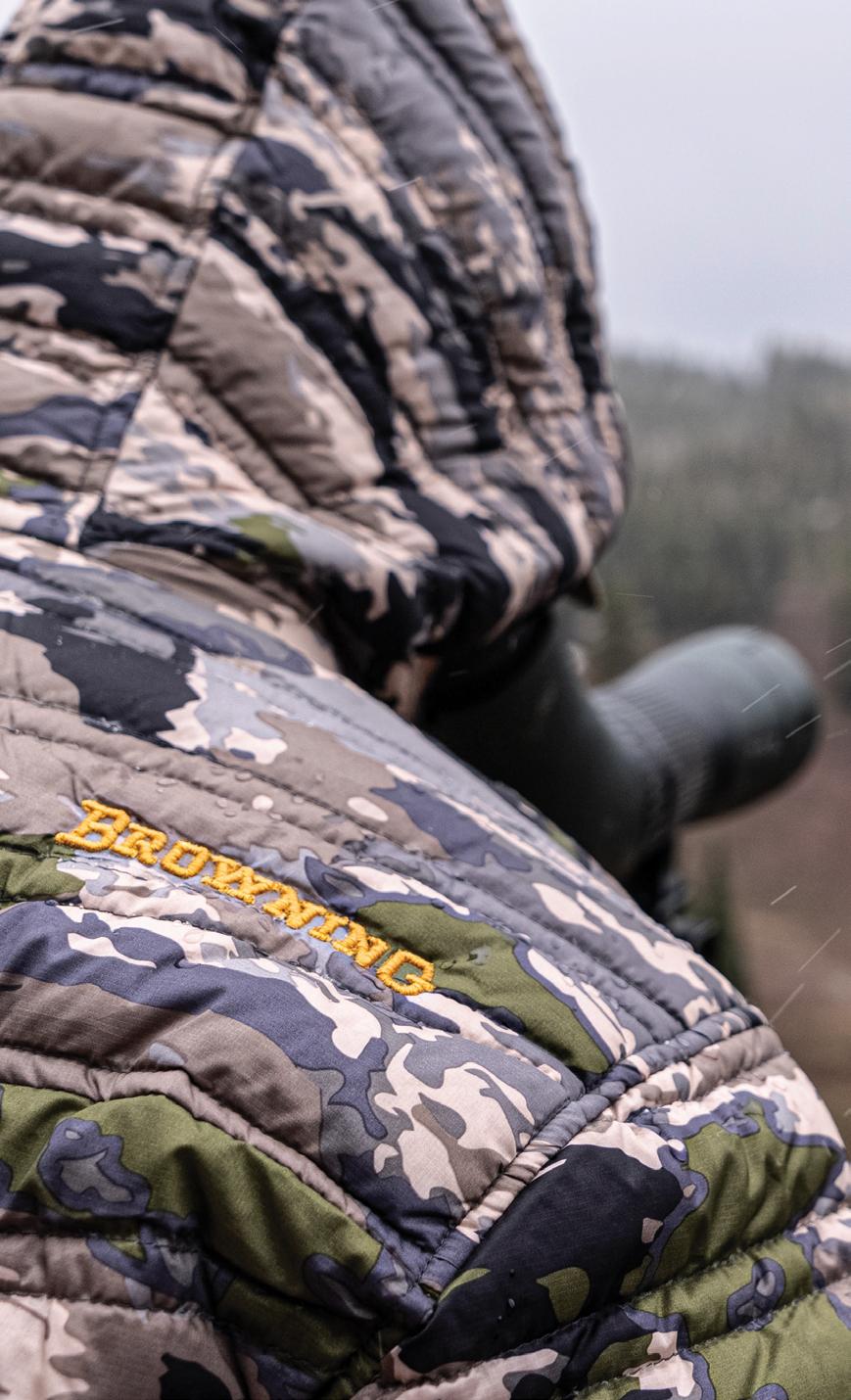

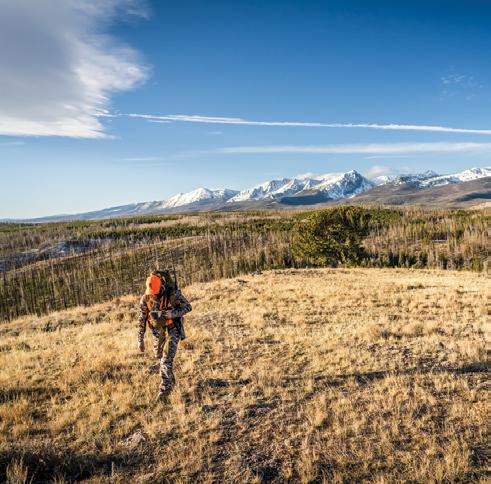


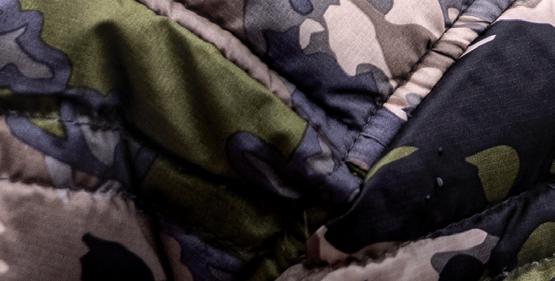


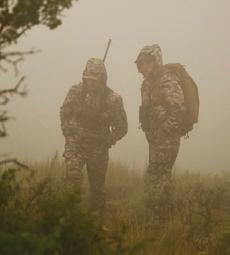


PACKABLE PUFFER JACKET browning.com → in OVIX Concealment
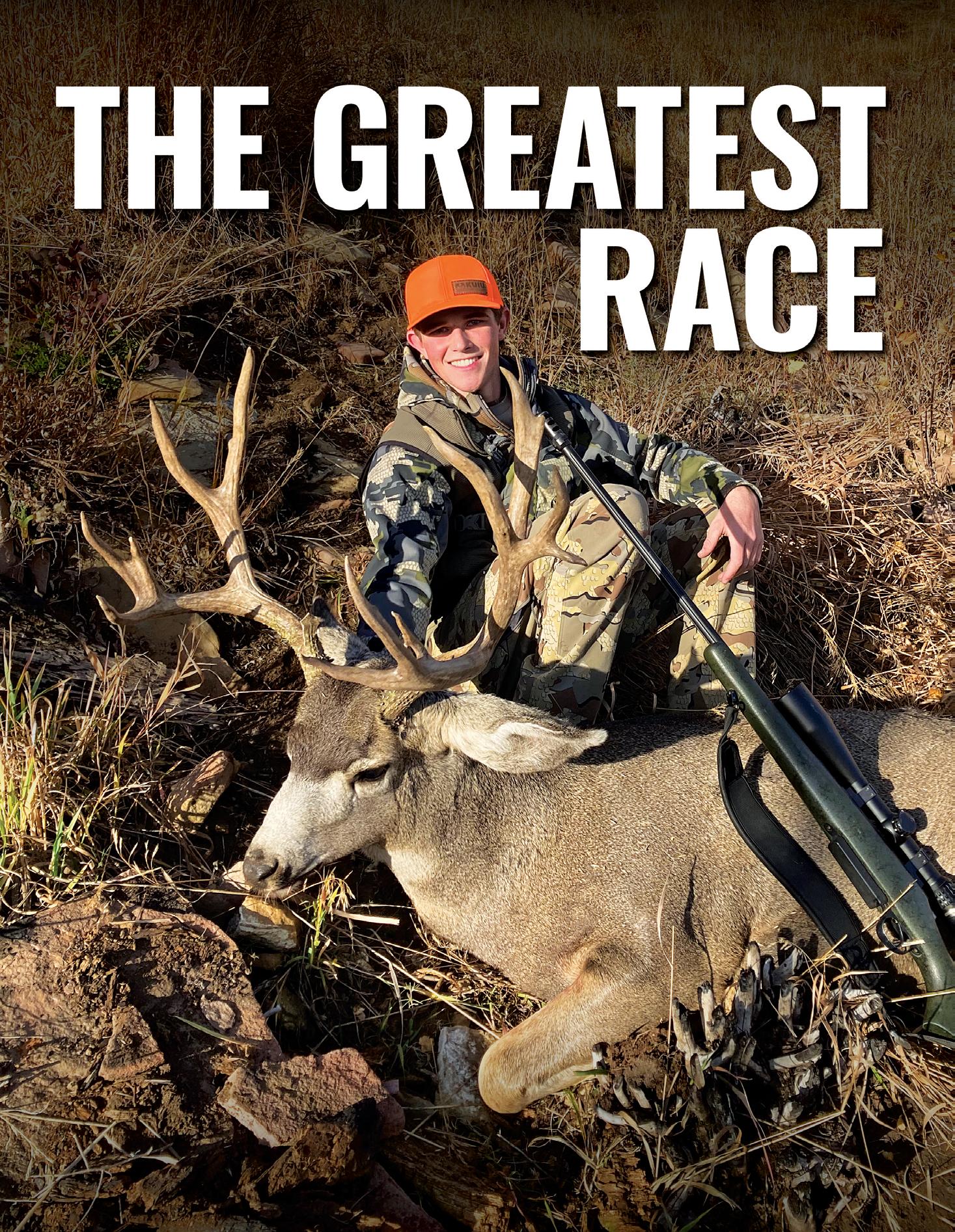
www.westernhunter.net 22 WESTERN HUNTER WHM
A sprint to tag a giant buck
Talon Tuttle Utah - 2023
With the archery and muzzleloader hunts ending, I started to scout for the rifle hunt. After seeing some good bucks during the other hunts and even passing a couple of mid-160s bucks, I had high hopes. During the rifle spike hunt, we found some elk, and while everyone was watching them I started to glass the rest of the canyon. Soon, I glassed two bucks in the middle of a group of pines. As I started to look closer, one of the bucks started to grow on me. It was a long way away and in the shade, so the clarity was not good.
As the sun rose above the mountains and the light started to get brighter, the clarity got better. When the sun hit the buck standing in the middle of an opening in the pines, his horns started to glow. I knew it was a buck worth keeping an eye on and chasing with a rifle. As I was watching him, he turned and I could see a big hook cheater sticking off of his left horn. Right when I saw that hook cheater I immediately knew that he was the buck I wanted to kill.
Plans and Rumors
Once again, having limited time, I was not able to be up watching this buck as much as I would have liked to. I watched him once or twice a week for about two and a half weeks. Two days before the hunt, I went up and found him within 100 yards of where he had been the past weeks. I knew I had a good chance of killing him. After looking deeply at


n Talon
On opening day of the rifle deer hunt, my longtime buddy Bowen Sitterud and I were out walking early to get to the canyon first. We had heard rumors that a couple of other people were watching this same buck and that they were going to attempt to kill him on opening day along with me. After watching this buck for a couple of weeks and having the best possible game plan set, we just had to execute.
The Starting Gun
The group of pines the buck had been in was at the end of a middle ridge that split the canyon into two bowls. The pines were on the north face of the ridge, so we needed to be in the north bowl, about halfway down, to be in range. We snuck down onto a terrace that would put us roughly about 650 yards away from the buck. I was shooting a 30 Nosler that was able to shoot out to 1000 yards. I felt comfortable out to 800, and with the pines located around 650, I felt confident.
When the buck looked up, I looked at his horns through the scope. Once I saw how big the cheater was, I got fevered up. All the composure I had built up and used to stay calm disappeared, and I started to get adrenaline.”
info@westernhunter.net 23 WESTERN HUNTER
and Bowen bask in the glow of taking their target buck.
We had about 45 minutes before shooting light when we got to the open, grassy terrace. I got set up and had the gun laid down in a spot where I was comfortable and could shoot. All we had to do was turn up the buck, range, dial, and shoot. After about 15 minutes of glassing and not being able to turn him up, I started to get worried, especially when we looked above us and saw two other hunters.
After a couple more minutes of glassing, Kasey called over the radio and said he had found my buck. He was in a good spot, feeding on a terrace. So, Bowen and I loaded the packs up and started out the ridge. We had to walk a little over a mile out the ridge to get to him. We started slowly getting out of the steep bowl that we were set up in and we walked past the other hunters just to ensure they didn’t follow.
Once we got past the hunters that were glassing, it was game on. Bowen and I started jogging and running at times to get to the buck before he crossed the saddle. As we got about halfway to the knob we had to get to, we saw two more hunters wrapping around the knob that the buck was on the back side of. We kept on heading to the knob, knowing that they did not know the buck was there.
Saved By the Spotter
As we got to the top of the knob, we saw that there were two telephone poles on top of it. Kasey was keeping an eye on the buck and guiding us in as


disappeared, and I started to get adrenaline. I set the crosshairs on his front shoulder and squeezed the trigger. I nailed him with the first shot!
He was hit nearly perfectly but was still hobbling around. I tried to get two more shots into him to make sure he didn’t get away, but I missed. The buck tipped over and started to roll down the bowl towards the ledges in the bottom. Bowen and I took off after the buck to make sure he did not go off the ledges and found him piled up 10 yards from where I had shot him. As we approached him, he kept growing on us.
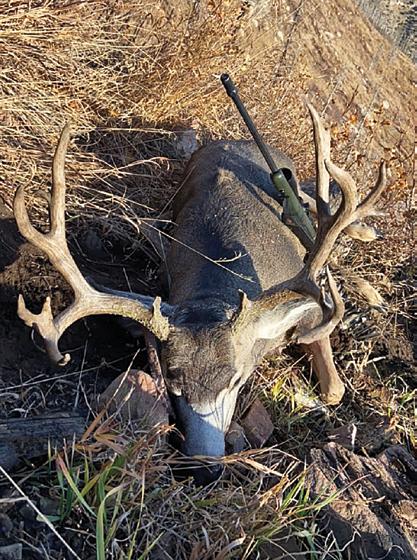
www.westernhunter.net
n Kasey and Talon enjoy the end of another successful hunt.

I pointed out to Bowen that he had a split on his hook cheater. Bowen then pointed out that he had matching tripods and another small kicker on his right side G2. That was when the yipping and hollering started! This being my biggest buck, the excitement and adrenaline were unmatched. As we started taking proached us and congratulated me on my buck. They took some pictures for us and helped us pack some of our stuff out. They were a huge help during the pack-out and made it so much easier. With a 3.5-mile
This buck capped off another amazing year that came with lots of great memories. I could not have killed this buck without the help of Kasey Edgehouse and Bowen Sitterud. They helped with even the small things. Bowen helped me stay calm to make a good shot and helped me pack a lot of weight out of


CRITICAL GEAR
Rifle: Remington-action Custom 30 Nosler
Scope: Burris Ammo: 192-grain Burger Hybrid
Binoculars: 12x50 Vortex Diamondback
Spotting Scope: Vortex Razor 27-60x85
Pack: Horn Hunter Full Curl Boots: Crispi Guide
Pants: Kuiu Attack Pant Jacket: Kuiu Axis Hybrid

info@westernhunter.net 25 WESTERN HUNTER

Only at KUIU.COM LIFETIME WARRANTY ON ALL OUR GEAR BASE LAYERS | INSULATION | OUTERWEAR | PACKS | SLEEP SYSTEMS | FOOTWEAR | ACCESSORIES


THREE FOR ONE
Having lived the majority of my life in the Midwest, my boys and I became avid whitetail hunters. In 2012, my wife and I had the opportunity to move to California. At the time, our boys were spread out across the country between college and work. Although California is not known for its hunting, I began purchasing preference points in multiple states. Over the last 10 years, we have been on elk, mule deer, and antelope hunts in Colorado and Wyoming. While we were usually successful, we had never taken an elk larger than a 5x5.
Several years ago, I decided to contact Worldwide Trophy Adventures and find out what they offered for elk hunts. One in particular sounded intriguing. The hunt was on the 95k-acre Fort Union Ranch in northern New Mexico with Bucks & Bulls Outfitters. After discussing the hunt details with my boys, I booked the hunt for the three of us for the first week of October 2023.

Up First, Eric
Over the next two years, we anxiously awaited for the day we would travel to New Mexico. My son Eric and I drove from California and picked up my son Greg (who lives in Cleveland) at the Albuquerque airport. Upon arriving at the ranch, we met the other three hunters in camp and our guides. We were hoping to sight in our rifles, but heavy rain throughout the evening prevented us from doing so. After a great dinner of grilled beef kabobs, we went to bed early.
The plan was to have breakfast at 5:00 AM and then go with our assigned guides to different portions of the ranch. My guide, Vern, and I would be hunting an expansive area on the backside of the ranch, while my two boys and their guides were headed to an area of the ranch called Mount Baldy.

moving through the timber. Eric’s bull emerged but did not offer a good shot. Finally, after making it through a stare-down with a cow, the bull came out and offered Eric a 52-yard shot. Even at that range, it took several rounds in the boiler room from Eric’s 300 Win Mag to bring down the monarch. Greg and his guide were close by and helped with the quartering.
www.westernhunter.net 28 WESTERN HUNTER
n Eric started things off by taking a great 6x7 bull.

A family’s perfect day of elk hunting
One for Dad
After lunch and a quick chance to verify that our guns were sighted in, we headed back out. Greg and his guide, Heber, were headed back to Mount Baldy while Vern and I would again be trying the area we had hunted that morning. Greg and his guide told us that they had spotted a bull and five cows bedded down about a mile away from where I was hunting, so Vern and I decided to investigate. After getting to within several hundred yards of the bull and his cows, we decided to pass on him, knowing that we could probably do better.
Shortly afterward, Vern spotted a large group of 20 to 30 elk on top of a large plateau a good two miles away. After checking the wind, we developed a plan to go after them. We would travel to within a half mile and then close the distance by climbing a steep, rocky embankment where we thought the elk would be feeding on top. After getting close to the top and peeking over, we saw a group of four raghorn bulls about 400 yards away. A few minutes later, we heard another bull bugling a couple hundred yards to the west of us. The bull and his cows were in a rocky, heavily timbered area that prevented us from seeing them.

New Mexico – 2023
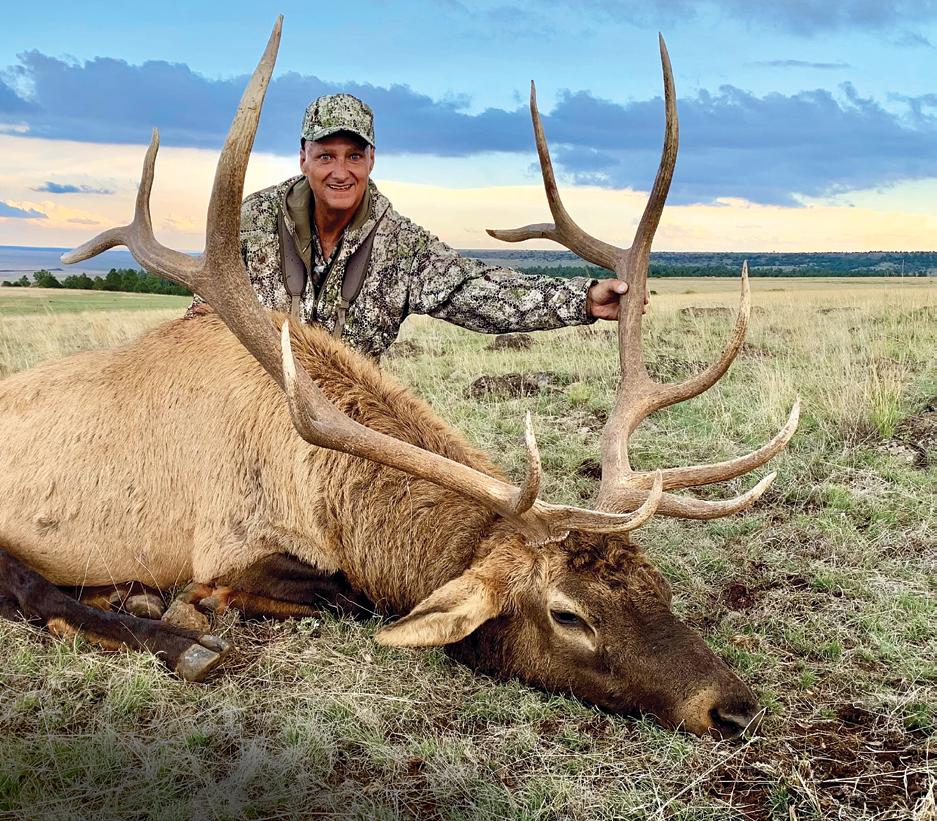
next to him. We could immediately start to see the cows emerging from timber approximately 250 yards away. After what seemed like an eternity, the bull finally stepped out in the open. He was bugling while herding the cows away from us. When I had a clear broadside shot, I aimed too high and shot over him twice before getting the chance to connect when he had moved out another 50 yards. Vern immediately hugged me and said that I had just taken a great bull.
After walking up to my bull and exchanging a few more high fives, I received a text message that Greg had also just connected with a big bull on Mount Baldy. My sons Greg & Eric, along with both of their guides, had hiked about two miles to the top of Mount Baldy in search of several large bulls that they had spotted earlier in the morning.
info@westernhunter.net 29 WESTERN HUNTER
Vince, Greg & Eric Castle
n Vince got on the board with a classic 6x6 bull.
Greg’s Bull
About halfway up, Greg’s guide signaled for them to lay down and be still as a dozen elk came running out of the valley towards them from about a mile away. They hunkered down and glassed the group to see if there was a shooter. The last bull to

they neared the crest, they could hear several bulls bugling from the other side. They crawled to the top and saw a large 6x8 herd bull with a dozen cows about 450 yards away. With strong winds at the top, Greg did not feel confident in taking the shot, so they repositioned themselves around an other side of the mountain that the herd was slow ly working toward. After the large bull came into view about 250 yards away, Greg took him down with one shot.
To get three big bulls in one day was beyond anything we could have hoped for! While we real ize we have now set a high bar for future hunts, we will forever be thankful for our special

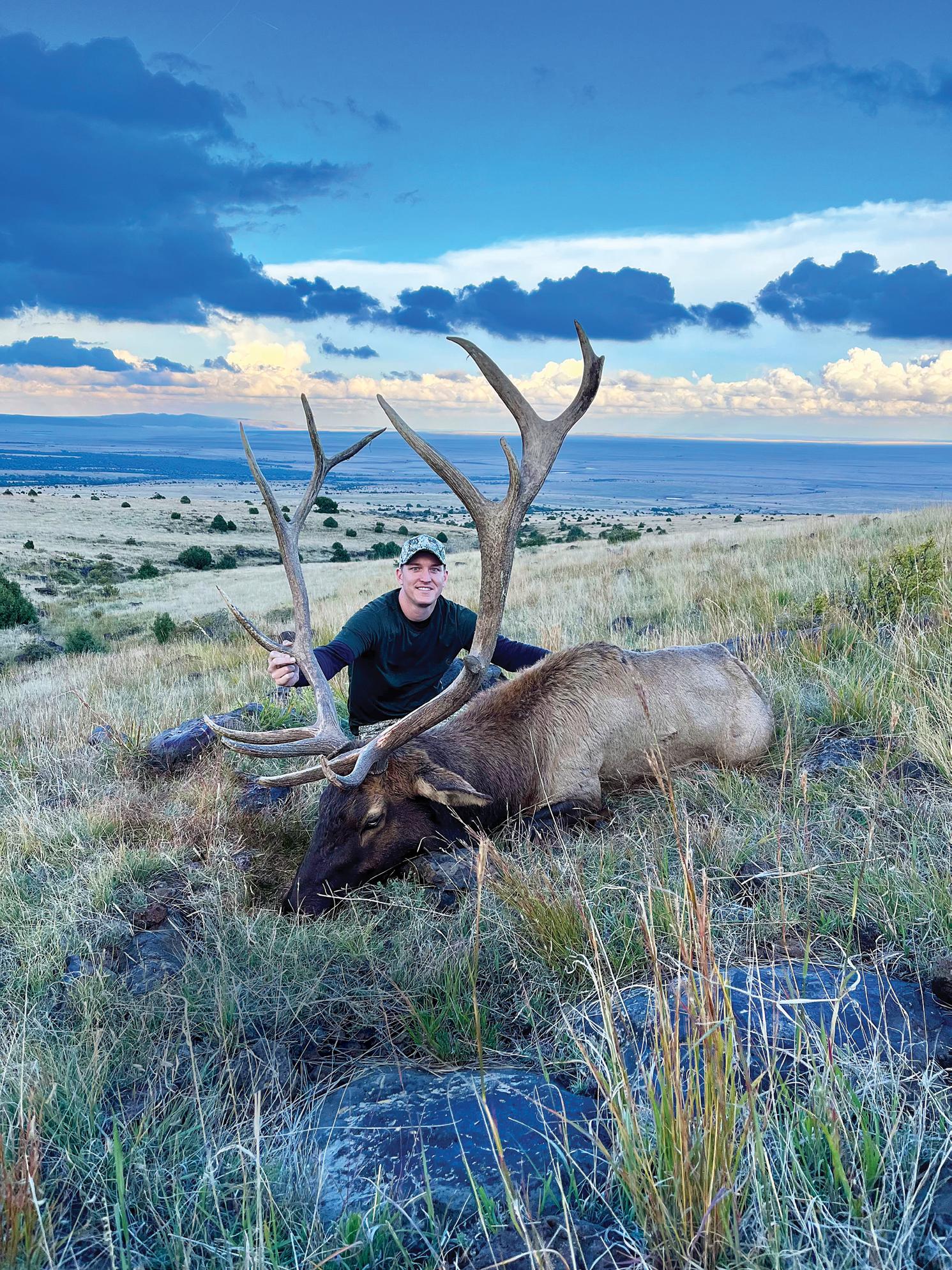

GEAR
Rifles: Christiansen 300 Win Mag, Savage 300 Win Mag Scopes: Nikon, Vortex Binoculars: Vortex Furry HD 5000 10x42 Clothing: Badlands, Sitka Backpacks: Badlands Boots: Redhead
CRITICAL
n Not to be outdone, Greg finished off a remarkable day with a 6x8 of his own.
PREMIUM PERFORMANCE TRUSTED BY PROFESSIONALS
Our Geovid Pro ballistics binoculars offer the epitome of optical excellence and are relied upon by professional guides and hunters during extended hunting expeditions. When paired with our Amplus 6 scope, known for its exceptional low-light performance, precision adjustments, and multiple reticle options, you can have absolute confidence in an optical system that embodies Leica’s proven track record of delivering unrivaled performance.
Geovid Pro Models: Geovid Pro 8x32, 10x32, 8x42,10x42, 8x56
Amplus 6 Models: 3-18x44 i, 2.5-15x56 i, 2.5-15x50 i

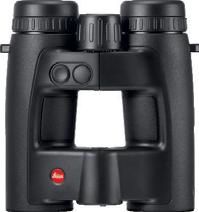
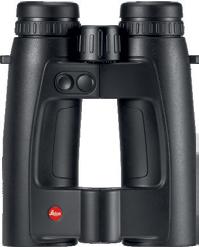



Discover more – visit your authorized dealer or explore leica-camera.com/sport-optics
Geovid Pro Features:
W
@LeicaHuntingUSA
Calculation Bluetooth Applied Ballistics Atmospheric Sensors Leica ProTrack Ballistics made easy Wind Correction
LEICA AMPLUS 6 2.5–15 x 56 i
LEICA GEOVID Pro 32
LEICA GEOVID Pro 42
LEICA AMPLUS 6 3–18 x 44 i
NEW
Reticle L-4w (MOA)
LEICA AMPLUS 6 2.5–15 x 50 i
NEW
Reticle L-4a
A long, arduous tracking job on a gigantic wolf

It started as a beautiful sunny day with a fresh blanket of snow. As I had my daughter Kate with me, I decided that we should go and do a couple of sets for coyotes and check for tracks. After a nice little drive and marking areas to return to for further investigation, I picked out one of my favorite spots to have a sit and let Kate stretch her legs.
After doing a small set of calls, we walked back to the truck which was a short 50 yards away, and there stood the biggest black wolf I’d ever seen in the meadow we had just left. I raised my 22-250 with hand-loaded 55-grain Varmageddon (definitely not the caliber or bullet of choice for wolves), put the crosshair on the center of mass, and let it rip as he was staring straight at me.
www.westernhunter.net 32 WESTERN HUNTER WHM
Matthew Ritchie
Alberta, Canada - 2023

Uninvited Guests
I decided to put Kate back in the truck and got her fastened in her car seat with a snack, listening to her favorite Raffi album. I then walked back to the point of impact and started my search for blood. Keep ing the truck in sight and listening to my daughter singing songs, suddenly the woods absolutely erupted in an uproar similar to walking into an SPCA and having every dog in the place start barking, snapping their jaws, woofing, and howling. I can only guess that there were an additional five to seven wolves with the bone-chilling sounds filling the woods all around me. At that point, I made the only choice I could
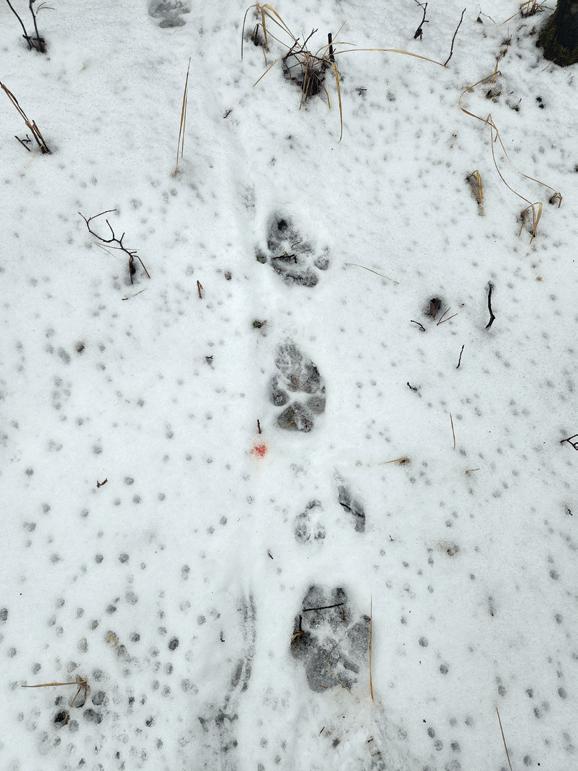
After returning home I made a phone call to my hunting partner Warren Smith and worked out a game plan to search the next day. As we set out the next morning with our game plan in place, we de cided with our extra time to cut the roads around the area and see if we could find where they had exited, if they had done so. Lo and behold, we lo cated the pack two kilometers away, and the tracks didn’t show any sign of blood or a wounded ani mal. So, we moved out of the area to return in the evening for a hunt.
Toe Dragger
Back to the main search area we went. With daylight upon us, we struck out into the meadow, found blood immediately, and began our tracking. After a short time, we located the bedding areas which were covered in blood. Spirits were starting to get high with anticipation of finding him. It was at that point we lost everything, blood and sign. We had a hell of a time locating their exit route, but we did manage to find where they all regrouped a kilometer farther up the trail. On that second day, I was only able to look until noon, so we packed up and called it a day.

info@westernhunter.net 33 WESTERN HUNTER
n Matthew’s wolf was a 115-lb male.
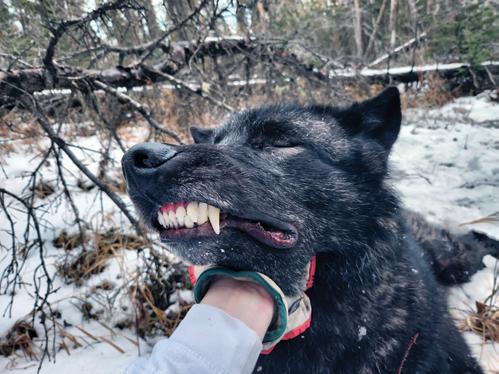

Luckily enough, my wife only ended up working a partial day the next day, so I was able to sneak away for one final search. So, on the third day, I struck out at noon and went to our last known tracks. I was looking for one particular track, as my partner had noticed one wolf was dragging his front left paw a little bit more than the rest. After following them, I gathered that “Toe Dragger” had made a hard detour off the main path and started to wander off, and this made me very curious.
Slow Recovery
Boom! I was on blood again and my excitement started to gain traction, so I figured why not howl and see if they were still around. I never got a wolf response, but what I got back was a beacon call from a raven in the exact direction I was heading. So, after calming myself a bit and having some water, I began my hike uphill, again. I was moving along slowly, making sure not to lose his track. The snow was melting and tracking was becoming more difficult when I lifted my head to see the most beautiful and biggest black wolf I’ve seen in person. He had expired, I believe, the first night or the second morning as rigor was set in and he was partially frozen. At this point, I had left my quad several kilometers away and needed to figure out the recovery plan.
Thankfully, it was only a 500-yard drag through the bush downhill to the main road. I called a good friend to pick me up and save me some walking. This was, hands-down, one of the hardest track jobs I’ve ever done, but I’m telling you, what a feeling when I recovered him. I knew I had hit him very well but with a light caliber, and knew I would be tracking, but it was incredibly difficult even with a little snow.

CRITICAL GEAR
Rifle: Remington 700 VLS 22-250
Ammo: 55-grain Varmageddon 34.6-grain Varget
Riflescope: Bushnell Nitro 4x12
Call: Foxpro Shockwave Decoy: Mojo Critter

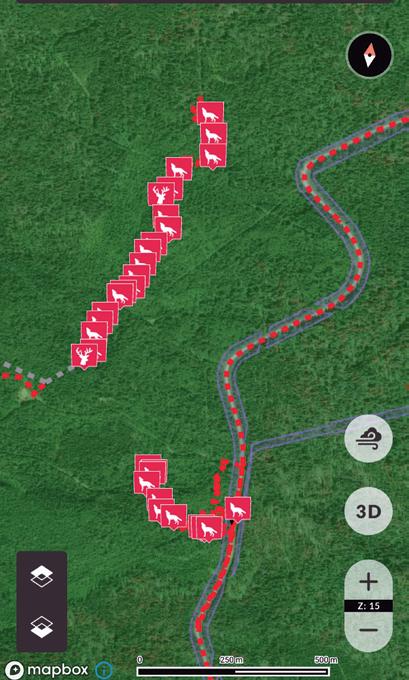

n Matthew’s second wolf was a female approximately 4 to 5 years old. Her K9s were wore and her front chewers were cracked. Signs of eating big weight bearing bones like moose.
www.westernhunter.net
All the markers are blood and track locations and don’t include the 587 circles I did getting back on tracks or following the wrong ones.


Iam crazy about gear. I really appreciate it when new products fill a niche that I find useful. I also enjoy testing and trying new things as they become available. One of my favorite parts about working with a lot of different outdoor companies is the field-testing portion where I get to take unreleased products, run them through the wringer, and report back.
This past season I got to test, aid in development of, and try a lot of great gear that I am really excited about. I figured it would be cool in this article to keep Western Hunter readers on the leading edge of what is coming and give you my two cents on some products that I have been hands-on with this past season. To do that I will be leaking a few new products before they are released for sale. I am going to ignore that “Top Secret” label on the box as we look at what is about to be available, and I reveal some awesome gear to look forward to this year.
Stone Glacier Game Bags
Game bags have come a long way from the original cheesecloth-type disposable sock bags that never seemed to keep dirt or flies out. Since the cheesecloth days, reusable bags have now become the norm. In my opinion, the game bag game just
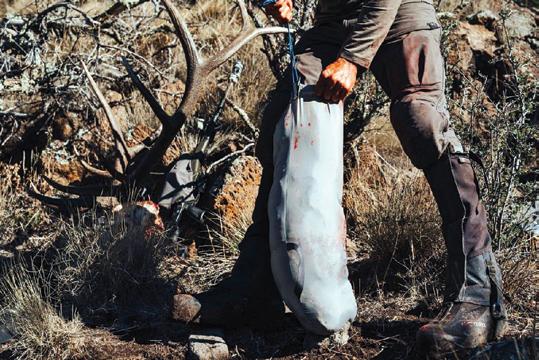
TOP SECRET GEAR LEAK

A SNEAK PEEK AT SOME OF THE NEW GEAR I HELPED DEVELOP FOR 2024
First Lite Western Hunting Clothing Line
Having field tested and been involved in the development process for First Lite, I have a ton of insight on some of the new First Lite gear to release this year. Here is a look at some of what I tested.
Yuma Poly Base Layer Hoody
First Lite’s first synthetic base. A company with wool base layers as its flagship is breaking into synthetic base layers. The Yuma Hoody is lightweight, wicks sweat fast, and works great in those hot envi-
durable. The design itself aids in the strength. Un like a pillowcase-type design, there is no bottom seam on the SG bag to bust out. The single-sheet material holds weight, and the integrated buckle closure makes it easy to hang, move, handle, and take down.
This product is rumored to be hitting shelves this summer.
Key Features:
No seam bottom
• Integrated buckle system for hanging
• Handle for easy lifting
• Lightweight and durable
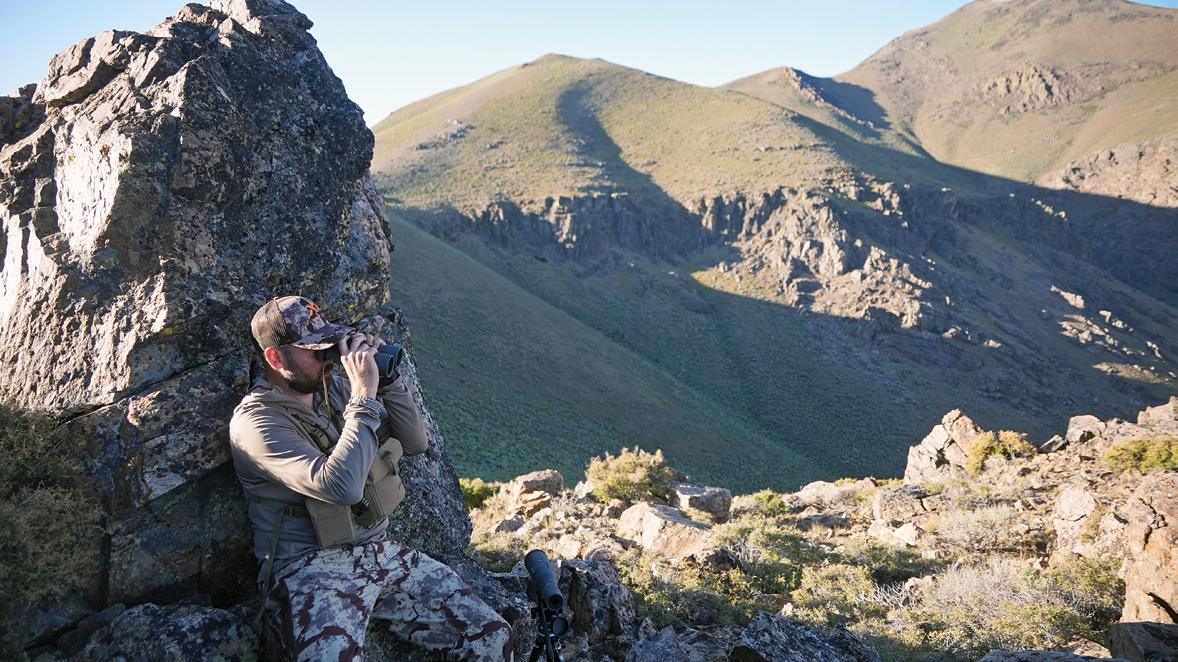
308 Pant
I started field testing the 308 Pant in 2022. It filled a niche with performance and simplicity. The idea was to create a go-to pant with mobility, comfort, and durability all equally in the mix – an allaround pant that could be used on the majority of

www.westernhunter.net 36 WESTERN HUNTER Gear for the Western Hunter
WARREN
REMI
HUNTING EDITOR
Kurt Racicot, Stone Glacier founder and designer, field testing prototype game bags.
A prototype of the Stone Glacier game bag being put to the test on an elk hunt I was guiding this past season.
The Yuma Poly Base and 308 Pants being tested in the Nevada backcountry.
Sam Averett
Gear for the Western Hunter
hunts. This pant hits that mark. It has been one of my favorite things in this new batch of 2024 gear and, without leaking it all, I would keep an eye out for more in this new 308 line in the future.
Key Features:
• 100% Poly 4-way mechanical stretch fabric
• 16.5" Straight leg fit to accommodate all bodies and all boots (308 Fit Consistency)
• Zippered thigh vents with mesh screening
• Zip cargo pockets on right thigh carpenter, and left leg front
Challis Jacket
One of the surprises in First Lite’s new line for this year was the Challis Jacket. It is a wind-stop polar fleece at a really good price point. I used this on a ton of late-season hunts this past year. It was one that I was not expecting to enjoy as much as I have. The wind stop has a ton of great benefits, and it pulled through on late hunts.
Key Features:
• Zippered tricep vents
• Windproof fleece with grid backer
• Zip-up collar without hood for easier layering
• High hand pockets stay out of the way of your pack belt, with dual internal compartments

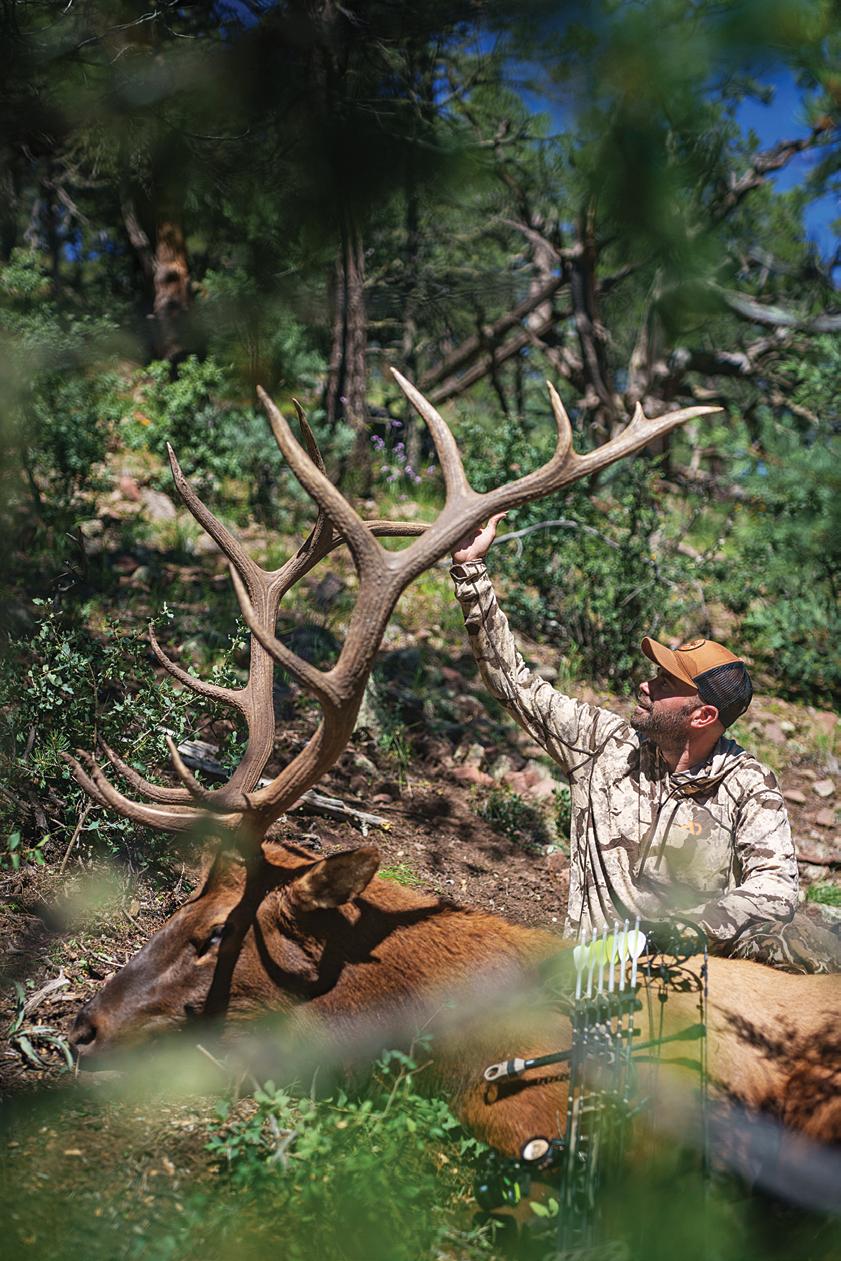
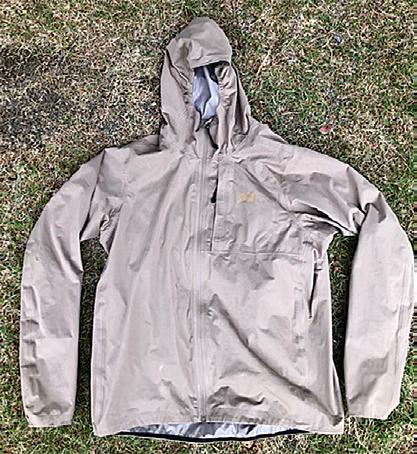

ly-season and dry-climate hunts or those spring hunts where rain moves in and out quickly. The jacket keeps you from getting soaked but also doesn’t take up valuable pack space or add much weight, making it an easy choice to take.
Key Features:
• Self-packs into Napoleon chest pocket
• 3-layer Ultra-lightweight construction
• Minimalist elastic cuffs and hood binding
• 6.6 ounces
info@westernhunter.net 37 WESTERN HUNTER
The Challis Jacket is one that really surprised me but I have always favored jackets with wind stop and I like the warmth and silence of polar fleece.
The new Cerca camouflage pattern checked all the boxes on my New Mexico elk hunt this past season.
The Flash Storm Jacket is the perfect rain shell for early-season and dry-climate hunts where the rain may hit, but it is not worth carrying a heavy set of rain gear.
Gear for the Western Hunter
Meat!
At-home meat processing has improved dra matically with the help of MEAT! Your Maker gear. Their philosophy of making commercial-grade equipment at a lower cost to the consumer means that everyone can have that commercial quality and time-saving at home.
2 HP Grinder
This year, to add to that commercial type of product, they have a 2 HP grinder dropping. Dur ing the past year of testing, I was able to grind es sentially an entire elk in around five minutes –pretty incredible.Aside from the higher horsepower, the larger throat aids in speed and efficiency. You can process faster by adding larger cuts of meat easily. Shortening grind time aids in the overall quality of the final grind by keeping the meat and fat colder and not rendering it during the process. This is especially beneficial in sausage making.
Key Features:

Weatherby Live Wild Edition Mark V
• Grinds 23 lb per minute or 1380 lb per hour
• Easy clean design and dishwasher-safe stainless steel
• Hands-free foot pedal control

25 Lb Motorized Sausage Stuffer
For those that take meat processing to the next level, a 25 lb motorized sausage stuffer is now in the mix. This makes the process of creating homemade brats, summer sausage, snack sticks, and more that much easier. I do a lot of this kind of processing, and having a motorized stuffer made a huge difference. This was always the pinch point in processing for me. This unit allows for commercial-type production at home. It is easy to use and faster than a hand-crank stuffer for those interested in doing volume.
Key Features:
• Forward and reverse function
• Foot pedal control for hands-free operation
• Multiple stainless stuffing tubes for different types of sausage
This one I am the most excited about because I got the opportunity to build my dream rifle and offer it to everyone. It is the Live Wild, Remi Warren Edition Weatherby Mark V. When I sat down, and we drew this gun up, they asked what I wanted. I knew that I had a long list of demands. I wanted it to be a top-end American-made gun and I wanted the Mark V action because of its accuracy and dependability. I also wanted a few other custom features like a spiral fluted barrel, spiral fluted bolt, lightened bolt handle, adjustable Trigger Tech trigger, threaded barrel, and muzzle brake.

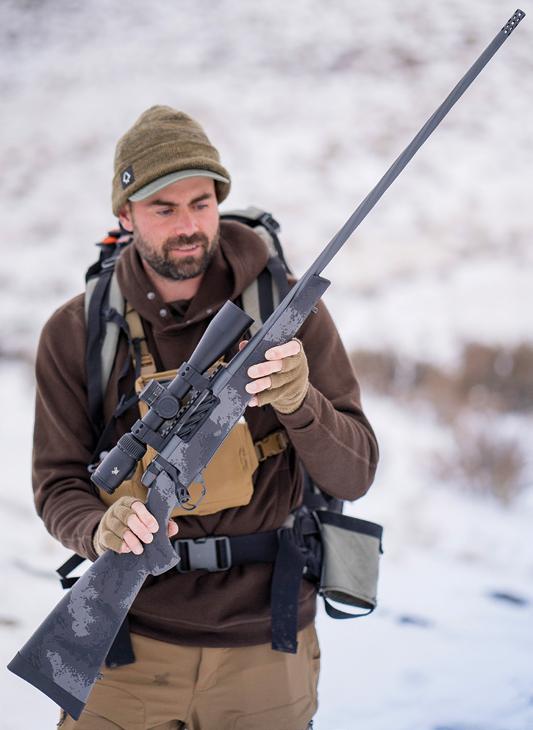
I also wanted it to look cool, and I liked the custom sponge paint option. Then, my final ask was for it to be at the best price point possible with a large selection of calibers. That was a lot of features and a big ask, and yet Weatherby figured out a way to make it happen. The first of the Live Wild series rifles checked all the boxes and then some.
During the building process, I was able to take a few off the production line and to the range for a round of quality control. I took it straight out of the Cerakote oven to shooting at distance. I shot it from 300 to 1,000 yards, hitting the bull the entire way out. It was a confidence-building moment for sure. We had the right combination, and the gun did its most important job... shot incredibly.
As a hunting gear junkie, and someone who has had a lot of input and testing on various gear in the hunting space over the years, it is incredible to be able to put my name on something of this caliber and be able to write a gear review on something that I got to be such an integral part of. It is an awesome moment, and for those looking for a great-shooting and good-looking rifle, this is definitely one to consider. The rifle will be available for order both online and in-store.
Key Features:
• Fluted and Cerakoted bolt and barrel
• Lightened bolt handle
• Threaded barrel with included muzzle brake
• Trigger Tech Trigger
• Hand-painted synthetic stock
• Made in America


www.westernhunter.net 38 WESTERN HUNTER
Sausage making simplified! I was able to make 50 lb of sausage links on the first run and it cut my process time in half. The Meat! motorized sausage stuffer is a game changer.
Grinding an entire bull elk I took in New Mexico took only around 5 minutes, start to finish.
The Live Wild, Remi Warren Edition Weatherby Mark V is a rifle packed with custom features that I’m proud to put my name on.

THE ARK
THE NEXT EVOLUTION OF KIFARU PACK FRAMES
JAMES YATES HUNTING EDITOR
Kifaru is known for making durable, comfortable, and dependable gear for the backcountry. When they say they make “gear for life,” they mean it. In fact, there are very few brands I can depend on more in the backcountry than Kifaru. I bought my first Kifaru pack over 10 years ago when I really couldn’t afford it, but I knew it would be a wise investment. Since that time, I have accumulated extensive experience with their frames, packs, and shelters. From some extremely strenuous packouts with their packs to weathering some gnarly backcountry storms in their shelters, I know I can confidently depend on Kifaru gear.
The Ark
Kifaru approached me in the summer of 2023 about a new frame they had already been developing for several years. This new frame, called the Ark, was going into the final stages of development, and they invited me to field test a prototype version of it. It turns out the Ark is a radical new pack frame
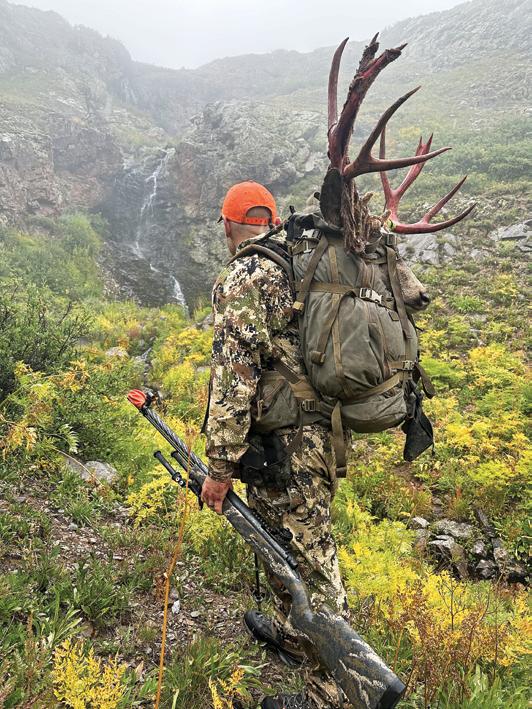
unlike any other that Kifaru has ever produced. After many years of development and waiting for the right moment, a new carbon fiber era has arrived for Kifaru.
The all-carbon-fiber Ark is the most comfortable and the lightest-weight frame with a full framesheet that Kifaru has ever produced. Despite the revolutionary advancement in the frame, it continues to be 100% made in the USA (with all American-made components). Kifaru proudly offers the new Ark frame, upholding the company’s legendary reputation for producing high-quality, lightweight, and comfortable gear for hunters demanding perfection. Kifaru is well known for its modularity and adjustability, and this new frame continues to improve upon these categories as well. Similarly, the Ark frame is compatible with nearly all legacy Duplex packs!
Upgrades
The new carbon fiber panel on the Ark steals the show, no doubt, but it is not the only significant upgrade on this new frame. The Ark features upgraded nitrogen-enriched foam in the lumbar pad, hip belt, and shoulder straps. This new foam is of higher quality and higher density and, to me, feels more form-fitting (it contours to the body well, almost like memory foam). The new hip belt incorporates laser-cut MOLLE, which promotes much better integration with MOLLE accessories like holsters. Also, the shoulder strap connection on the hip belt features a new angle that prevents pinching. Lastly, there is a new style attachment buckle to connect the load lifters to the frame that is easy to use and foolproof.
Frame sizes of 22" and 25" will be offered, which are designed to fit all torso lengths up to 22". Adjustments of the shoulder straps for different torso measurements are easier than they have ever been on any previous Kifaru frame. In fact, one of the major design considerations for the Ark was the ease of use in adjusting the shoulder straps and attaching bags. There are integrated slots in the carbon panel for adjusting the shoulder straps with Velcro, which is simple but genius.Because the shoulder strap attachment points are higher up on the frame and more secure, the shoulder straps do not splay out like they did on previous frames. Additionally, there is a new integrated strap attach-
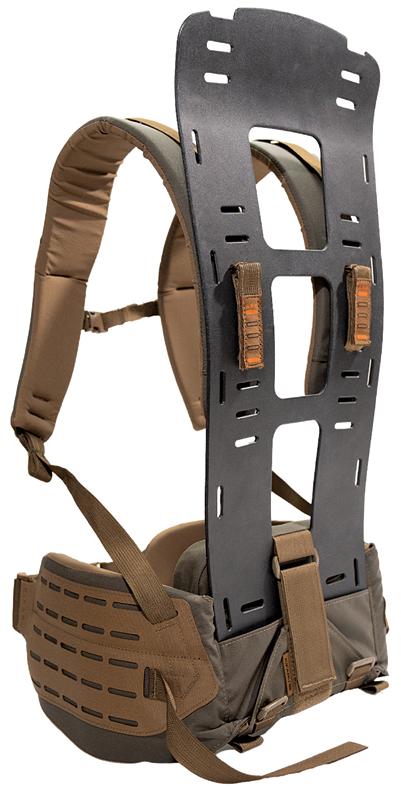
ment system that makes strapping on quarters and other awkward items a breeze.
The end result of all the new features is a frame that is lighter weight (essentially 3 lb for the 25" frame) without sacrificing any durability nor comfort. In fact, I think the new Ark is MORE comfortable than the previous Duplex Lite frame. For any legacy “curved stay” users of Kifaru (like me), this new frame fits great, without having to have the special curved stays; meaning the new frame fits a wide variety of back shapes well.


www.westernhunter.net 40 WESTERN HUNTER
The author packing out a big 5x5 buck with the new Kifaru Ark frame and Hoodlum bag on a grueling hunt in the high country of Colorado.
The author has used the new Ark frame over 60 days from the low desert to over 13,000 feet in the high country.
Gear for the Western Hunter
KIFARU ARK FRAME
Gear for the Western Hunter
Kifaru has done extensive testing of the durability of the new Ark in-house, and they’ve also given the frame to 15 stout individuals for field testing. The Ark saw it all this last fall and will be able to handle anything you can throw at it in the field. I put the Ark through its paces myself, including a 150-lb load, over 60 days in the field, a 16mile (one-way) high country backpack hunt, and even a hunt where I checked it on a commercial airplane (we all know how NOT careful airlines are with luggage). I’ve got to tell you the Ark is legit.
The Test
The trip of mine that really highlighted the new Ark frame best was my Colorado backcountry hunt. This hunt started with a 16-mile hike and roughly 5000 feet of elevation gain with approximately 45 lb in my pack. We had llamas for this hunt, but due to some unforeseen circumstances, I had to pack in with most of my gear after my partner, Mike, had already packed in with the llamas. Between the foam being more form-fitting and the frame panel having a bit of torsional flexibility (the frame moves with your body really well), the pack felt absolutely incredible for this hike in.
On day five, we pulled off a double on two big bucks and got all the meat, capes, and heads back to camp. For this entire hunt, the weather had been absolutely miserable. It had rained every single day a significant amount (over 0.5") and just after we got my buck back to camp, it rained hard for nearly 24 hours, putting down over two inches of rain. Everything was completely saturated with water; the meat, capes, gamebags, the 8-man Kifaru Tipi, packs, llama tack, etc. I have no doubt that we had over 100 lb of excess weight from the water saturated in the gear. We got up at 3:00 AM the following morning to make an all-day push for the trailhead.
Mike and I had to each carry about 80 lb on our

tions, we made it to mile 12 without many prob lems, just slow going with several breaks for the llamas. At mile 12, my llama laid down and refused to get up. Mike continued toward the trailhead with the other two llamas. After a long break and really having to push my llama, I made it to mile 13, and that’s all my llama would do. If I was going to get out that night, I needed to do something drastic. I absolutely had to get out that night for my own safety because my sleeping bag was packed and compressed wet, which is a big problem.
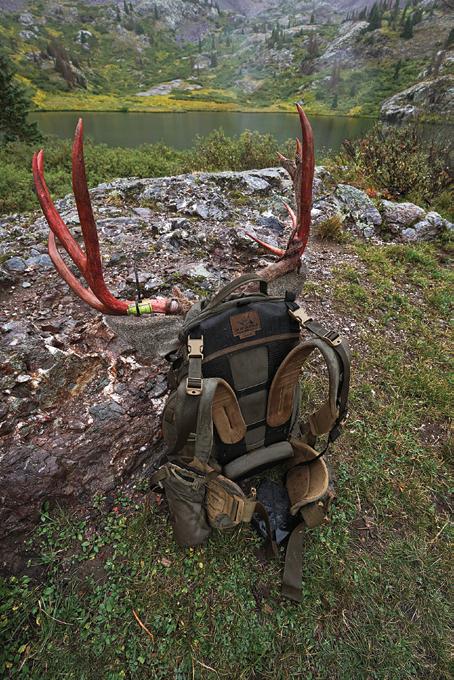
I loaded up one of the llama saddle bags really heavy and put it in the meat shelf between my Hoodlum pack and the Ark frame. I then slung the other llama saddle bag around my neck with the remaining gear. I had nearly 150 lb on the Ark frame between my pack and the meat shelf and an additional 30-40 lb slung around my neck. I proceeded to hike the most miserable three miles of my life. The weight around my neck was the miserable part, but you know what, the Ark handled business! It continued to do its job of transferring weight from my shoulders to the hip belt. I am not going to lie, my hips, back and shoulders were tired and sore from such a gnarly day, but the Ark exceeded expectations.

ably more comfortable than the Duplex Lite frame (any frame I have tried, for that matter) under all circumstances. The Ark’s lightweight hauling comfort (less than 80 lb) really stands out and has significantly improved because of the torsional flexibility in the frame panel and the new form-fitting foam. For heavy hauling comfort (more than 100 lb), the Ark feels similar to but still more comfortable than the Duplex Lite frame. Packing that much weight can be somewhat uncomfortable – just the nature of the beast – but the Ark exceeded my expectations.
For the final version of the frame, Kifaru was able to add layers of carbon beyond what my prototype had to vertically stiffen the frame even more without losing the torsional flexibility. This update has made the Ark even more comfortable under 100-plus-lb loads. The Ark is truly the next evolution in the line of already incredible pack frames from Kifaru. I don’t use these words often, but I honestly feel the new Ark is game changing. To learn more about the new Ark frame from Kifaru, check out their website at Kifaru.net

41 WESTERN HUNTER
The author using the new Ark frame to pack nearly 150 lbs the last 3 miles of an extreme pack out. The author originally had 80 lbs in the pack for the first 12 miles but had to nearly double that weight the last 3 miles when his llama gave up.



Spot Hogg Boonie Bow Sight
By James Yates, Hunting Editor
The piece of gear that I am most excited about for 2024 is the new Spot Hogg Boonie sight. Spot Hogg has been my favorite sight brand by far because of the lock down ability (sight adjustments don’t move at all once locked down), durability/ toughness, bright pins, and that industry-leading Multi-Ring Technology on the sight housing. I have owned and played with nearly every premium sight on the market, and they all get compared to and come up short against Spot Hogg. If anyone could fault Spot Hogg for anything up until now, it would possibly be the lack of premium features on their sights (though the simplicity of Spot Hogg sights
My favorite highlight of the new sight: the new Boonie features a first for Spot Hogg, an indepen dent second axis adjustment that allows you to level the sight independently from the bow (some in the industry call this a first axis adjustment, but it is technically a second, second axis adjustment). This point is going to allow Spot Hogg to offer inter changeable bow mounts for this sight (Picatinny, dovetail, and direct mount).
Another big upgrade is the removable scroll wheel, which will drastically improve the ease of sight tape installation and will allow for inter changeable wheels/sight tapes for different arrow setups. The new scroll wheel also features a new locking brake system with adjustable tension. This
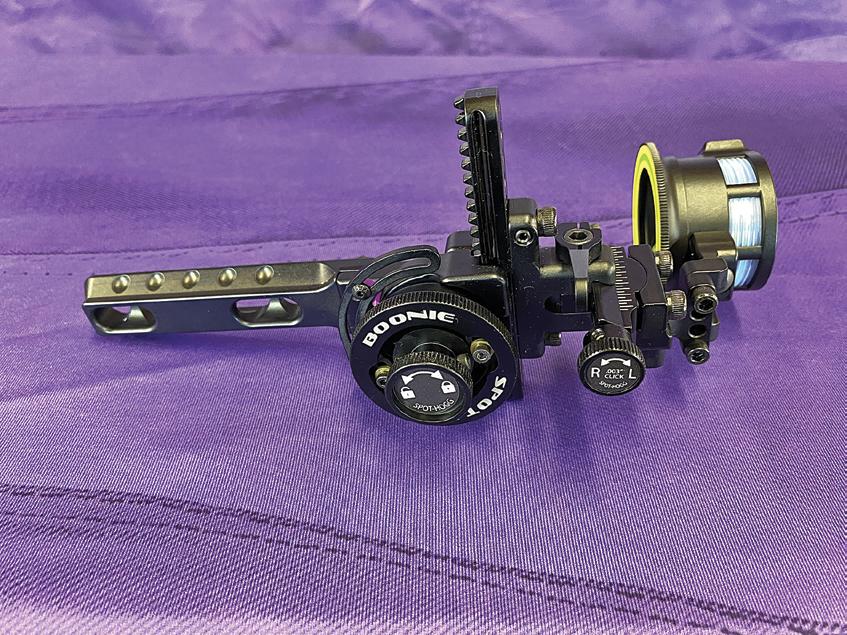
Barnes has released a new factory load to their VOR-TX LR lineup with the 280 AI (Ackley Improved) loaded with their 152-grain LRX (Long Range X) bullet. This is Barnes’ all-copper solution for hunters wanting the most downrange performance from their hunting rifles. The VOR-TX LR ammunition is loaded to maximize muzzle velocity to ensure reliable expansion at extended ranges within each cartridge and bullet offering.
Barnes LRX boasts a G1 BC of .467 on the 152-grain 7mm projectile, which will help maintain a higher velocity downrange for excellent terminal performance. Barnes VOR-TX LR 300 PRC ammunition loaded with the 208-grain LRX is a high-performance round and has shot very well in several of the 300 PRC rifles I tested last year, and I anticipate the 280 AI load to shoot equally well. For the western hunter looking to shoot all-copper bullets while still maintaining long-range performance, check out the LRX bullet and VOR-TX LR ammunition from Barnes.
Visit BarnesBullets.com for more information. p
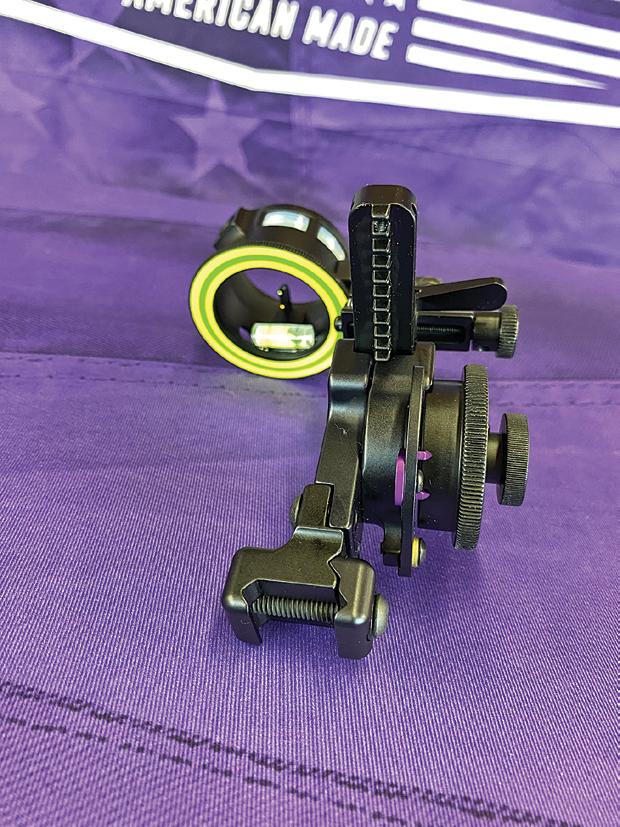
from others such as the Fast Eddie, for example (from 0.5 inches to 1.0 inches).
For more information about the new Boonie sight and to see all of the new features, check out the Spot Hogg Instagram page or Spot-hogg.com. p
8‚ AI Ammunition

www.westernhunter.net 44 WESTERN HUNTER WESTERN HUNTER MAGAZINE GEAR & PRODUCT HIGHLIGHTS p

Seekins Precision Havak Slam Rifle
By Colton Bagnoli, Hunting & Shooting Editor
 HAVAK SLAM RIFLE
HAVAK SLAM RIFLE
One of the most exciting rifles released at the 2024 SHOT Show was the Seekins Precision Havac Slam. The new custom rifle option has the same great Havak aluminum sleeved receiver and stainless steel barrels found in the Havak rifle, but it also features an all-new lightweight chassis to maximize weight reduction, yet reduce the rifle’s footprint when strapped to your pack in the backcountry. The new chassis is an aluminum/carbon fiber hybrid that features a side-folding butt stock and flush M-lok rail sections for a high-speed, lowdrag kind of feel. The side-folding attachment on this chassis is quite possibly the tightest and most

robust-feeling folder on the market. Its simplistic design and tight lock-up are key features.
The rifle’s overall weight is 5.5 lb, and it’s offered in 16" 308 Win, 21" 6.5 PRC, and 22" 7 PRC options. While the cartridge choices may be few, there isn’t much you can’t do with a sub-6-lb 7 PRC rifle across North America. Honestly, I wouldn’t want much more powder to burn in a larger magnum cartridge in this small rifle package.
Aside from the chassis features, the biggest value of this rifle is in the unconditional guarantee from Seekins Precision. The deal is that if you don’t like the rifle for any reason, Seekins will buy it back from you. I don’t know of any other rifle manufacturers in the industry that can make the same claim. (MSRP $4,650)
Watch for a full review and rundown of the Havak Slam in a future issue of Western Hunter Magazine. Until then, visit SeekinsPrecision.com for more information. p

Easton X⁄‚ Parallel Pro Arrows
By James Yates, Hunting Editor
Easton has been busy improving on an arrow that I have already found to be quite ideal. For the last few years, I have really liked shooting the Easton ProComp for hunting. Last year I wrote an article called Measured Arrow Consistency where I compared 10 different arrow models across different manufacturers for straightness and spine consistency. In this testing, the Easton ProComp was the highest-performing arrow. The X10 Parallel Pro is a new 4mm aluminum/carbon arrow from Easton that is replacing the ProComp. The X10 Parallel Pro, like the ProComp before it, has a thin aluminum core with carbon wrapping on the outside. The aluminum core is very exact and allows the high-modulus carbon outer layer to be exceptionally uniform. This combination results in an unmatched synergy of precision and exceptional spine consistency.
The X10 Parallel Pro is built using the same process as the Easton X10. The main difference between the two shafts is the X10 has a barreled design where the diameter tapers toward the ends. If you didn’t know, the Easton X10 is the most decorated arrow shaft in existence. It has been used to literally win every single archery Olympic Gold medal since it debuted in 1996. The X10 Parallel Pro is essentially the X10’s 4mm bigger brother that is big enough to be inserted with a broadhead for hunting.

The arrow boasts a straightness of ± .001", backed by Easton’s exclusive five-point straightness check. Beyond the straightness, the arrow is weight sorted with a tolerance of ± 0.5 grains within three different weight codes. Lastly, the arrow’s tight standards allow for exceptional spine-around-shaft consistency, which virtually eliminates the need for custom nock alignment.
Check out the new Easton X10 Parallel Pro at EastonArchery.com p
info@westernhunter.net 45 WESTERN HUNTER GEAR & PRODUCT HIGHLIGHTS NEW GEAR AND PRODUCT INFORMATION
PRECISION
SEEKINS

Hoyt Alpha X ‹‚ Bow
By James Yates, Hunting Editor
The Alpha X 30 is Hoyt’s incredibly efficient flagship aluminum hunting bow for 2024. This bow boasts a 344 FPS speed rating with a brace height of 6.19". That is incredibly efficient, especially considering the fact that Hoyt is now offering three different cam modules to keep the bow wickedly efficient throughout its entire draw length range from 25-30". Speaking of the cams on the Alpha X, they’ve been upgraded. The new cams are called the HBX Xact and feature fantastic adjustability, having 1/4" draw length adjustment settings, three letoff settings from 75-85%, and two backwall adjustment settings.
Generally, cams lose efficiency when they gain features, but not the Xact. My Alpha X 30 at 82 lb and a draw length of 28" is kicking out a 420-grain arrow at 319 FPS. Comparing the draw cycle of the new HBX Xact cam to the previous HBX Pro cam, the Xact cam has a smoother draw cycle and draws more easily at the same draw weight. I am pleasantly surprised with all of the

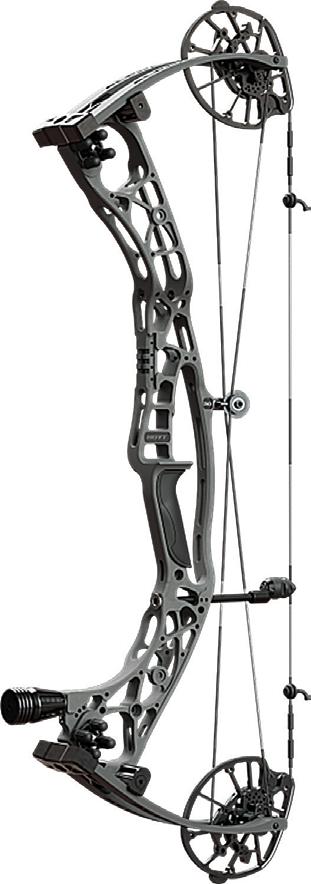
The other main upgrade is the new riser, designed from the ground up to be 25% quieter with an 18% reduction in vibration compared to the previous VTM. Having owned both bows, it is definitely noticeable on the shot.
I have been really in love with the new age of Hoyt since 2021. These bows have continued to build on one another and are incredible shooting platforms. They strike a beautiful balance between shootability, efficiency, and accuracy. If you haven’t shot a Hoyt post-2021, do yourself a favor, stop by a Hoyt dealer, shoot the new Alpha X series of bows, and witness firsthand what I am talking about.
You can learn more about the new Hoyt Alpha X 30 at Hoyt.com p

Hoyt Go-Stix 2.‚ Bow Stand
By James Yates, Hunting Editor
Hoyt released the Go-Stix a couple of years ago, and they have been a great addition to my bows. The Go-Stix is a lightweight kickstand for your bow so the bow can stand on its own. For 2024, Hoyt has released an upgraded version. Unlike the original, the legs now never have to be removed from the bow. Along with added functionality, the legs have seen a significant increase in durability. The new Go-Stix 2.0 features legs that swivel into four positions: “go,” “stow,” “cam stand,” and “tripod.”
Whether you are hunting from a treestand or ground blind, moving through brush, or stowing the bow in a bow case, there is an ideal position for the legs on the Go-Stix 2.0. For the 2024 Hoyt bows using the HBX Xact cam, there is a little kickstand built into the cam, which works in conjunction with the GoStix 2.0 to keep the cam and bow string out of the dirt in cam stand mode. Also innovative, the tripod mode allows the bow to stand on the Go-Stix 2.0 in combination with a front stabilizer (recommended front stabilizer length of 6-8").
Check out the Go-Stix 2.0 at Hoyt.com p
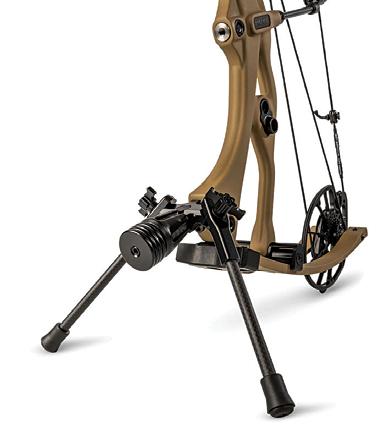
HOYT GO-STIX 2.0
www.westernhunter.net 46 WESTERN HUNTER GEAR & PRODUCT HIGHLIGHTS NEW GEAR AND PRODUCT INFORMATION
BOW STAND
HOYT ALPHA X 30
HBX XACT CAM
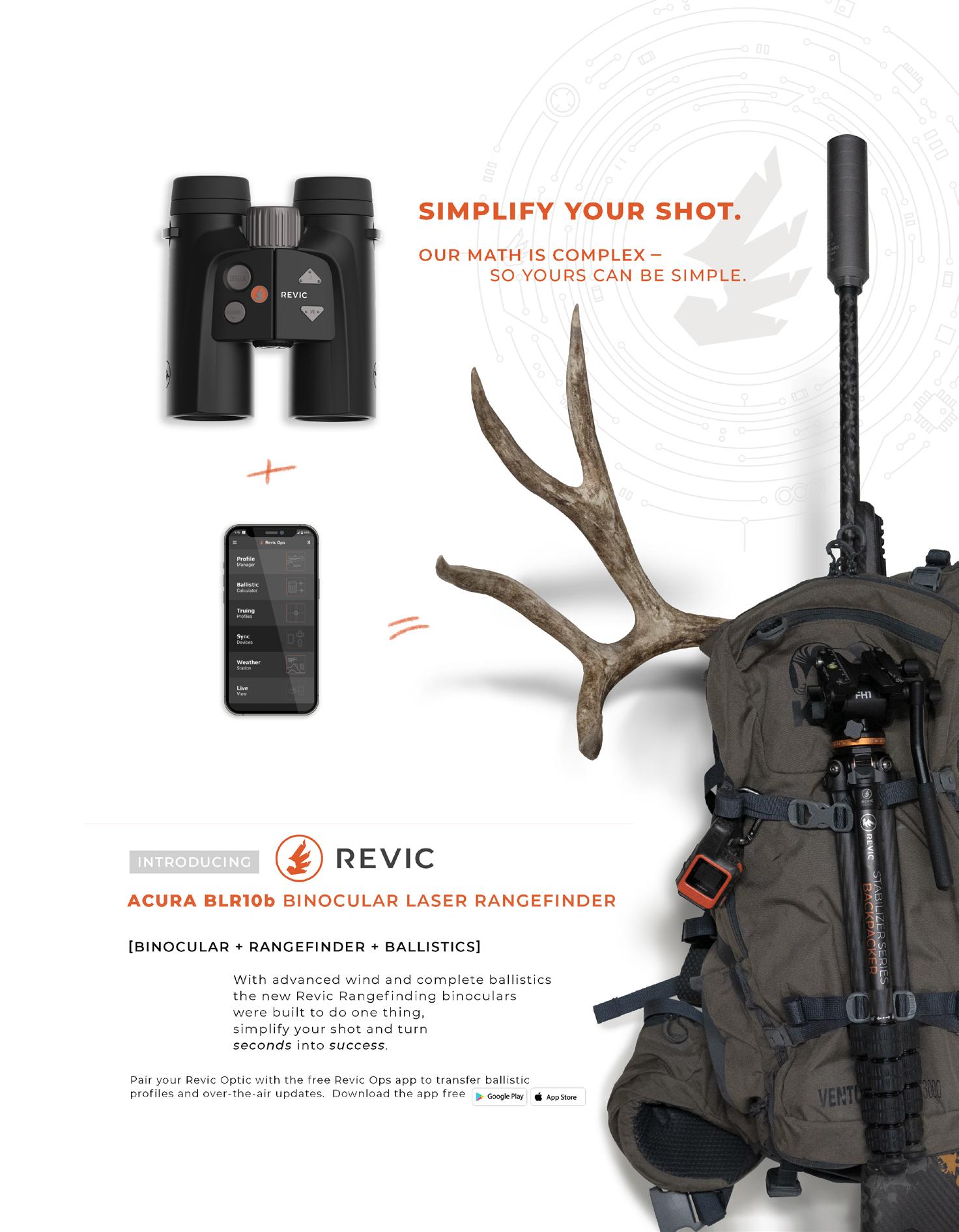

Leupold Mark ›HD Riflescope
By Colton Bagnoli, Hunting & Shooting Editor

Leupold is the leading American-made riflescope manufacturer, providing hunters and riflemen with a high-quality product line for nearly every application. With great success in their Mark 5HD rifle scope line, Leupold released a new Mark 4HD line for 2024. The new rifle scope line features a 30mm and 34mm main tube with a 4x zoom magnification system.
With locking elevation and windage turrets, the new Mark 4HD is purpose-built for the hunter wanting long-range capabilities in a lightweight, American-made optic. This new scope is offered in 8-32x56, 6-24x52, 4.5-18x52, 2.5-10x42, and 1-4.5x24 zoom configurations to cover all the bases. The 1-4.5 has a 30mm tube with a second focal plane reticle, and the 2.5-10 has a 30mm tube and


is offered in both first and second focal plane options, while the the higher magnification optics have 34mm tubes and first focal plane reticles in both MOA and Milliradian. Leupold also offers illuminated reticle options in several models with an MSRP from $999 to $1,599 depending on the model.
If you are in the market for a new optic, visit Leupold.com for more information. p
Nosler ‡ PRC Ammunition and Brass
By Colton Bagnoli, Hunting & Shooting Editor
With the increased demand for 7 PRC ammunition and components, Nosler has released 7 PRC Nosler stamped brass for the hand loader as well as Nosler Trophy Grade ammunition loaded with their 175-grain Accubond Long Range. Nosler ammunition has long been a standard for most of my rifle testing and evaluation due to its accuracy across the bolt-action rifle spectrum.
The new release for the 7 PRC will provide another factory solution for a rapidly growing 7 PRC market and offer hunters an option for a bonded bullet. The Nosler Accubond bonding process is a proprietary process that allows Nosler to chemically bond the lead core to the copper jacket, making it one of the most consistently performing hunting bullets on the market today. I have had excellent results with the 7mm 175-grain ABLR in my personal experience and will be adding the new ammunition line to my bench for the 7 PRC for rifle testing and hunting alike.
Visit Nosler.com for more information and to find a dealer near you. p

www.westernhunter.net 48 WESTERN HUNTER GEAR & PRODUCT HIGHLIGHTS NEW GEAR AND PRODUCT INFORMATION
LEUPOLD MARK 4HD 4.5-18X52
LEUPOLD
MARK 4HD 1-4.5X24

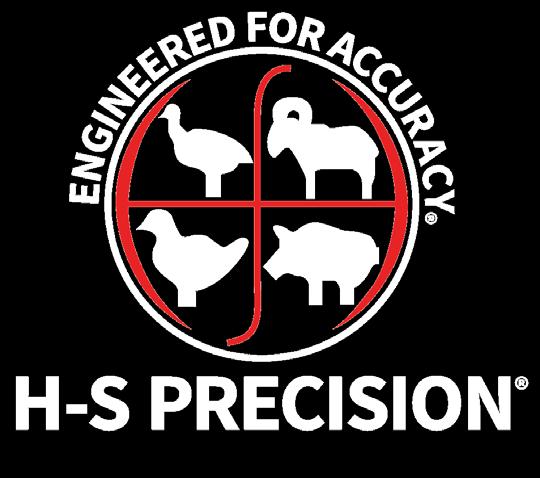

REDEFINING PRECISION

ONE COMPONENT AT A TIME

DETACHABLE MAGAZINE KITS
H-S Precision is a complete gun manufacturer producing high-quality firearms and products for the shooting sports industry using world-class techniques, proprietary technology, and state-of-the-art equipment.
DESIGNED, ENGINEERED, & MANUFACTURED IN THE USA
HSPRECISION.COM 605-341-3006 RAPID CITY, SOUTH DAKOTA

CUT-RIFLED BARRELS


SPRINGFIELD ARMORY WAYPOINT 6.5 PRC RIDGELINE RIFLE
 BAGNOLI HUNTING & SHOOTING EDITOR
BAGNOLI HUNTING & SHOOTING EDITOR
There is no shortage of factory rifles on the market to suit every shooter’s needs and aspirations. One of the most competitive markets is the mid-range of rifles in the $1,500 - 2,500 price range. Companies have developed new processes to create semi-custom-level rifles that deliver all the high-end rifle features at an economical price due to high-volume production assembly. Springfield Armory entered this arena with its Model 2020 Waypoint rifle line and has since added new models to the lineup every year to meet customer demands. The Waypoint Ridgeline rifle is Americanmade and designed for the western hunter who desires a sub-7lb rifle with a carbon fiber stock and a carbon-fiber-wrapped barrel to add strength and durability to the rifle system while cutting weight.
Carbon Fiber Stock Design and Ergonomics
The Waypoint Ridgeline rifle stock features a vertical pistol grip and adjustable cheek piece for a more comfortable interface for the prone, longrange shooter. The ability to fit the cheek weld of an individual shooter is key to success in longrange shooting. Until recently, this was mostly limited to custom-built rifles at a much higher price point. The grip angle is also crucial to accuracy and rifle control. Springfield selected a grip that is comfortable and allows a proper connection to the trigger shoe to ensure consistent trigger control. The forend features a flush M-lok rail embedded in the stock to allow the connection of rails and bipods when needed without having a sling stud always in the way. Overall, the stock is comfortable to shoot, and the rifle I tested features a standard 13.5" LOP.
Action and Trigger
Springfield’s designers built the Waypoint on a Remington 700 clone receiver with their own touch
on features and function while keeping the Rem 700 footprint and trigger pins with a simple side bolt release button for easy removal of the bolt for cleaning or bore sighting. The Waypoint receiver comes with a 20-MOA rail, installed with 6-48 screws, which allows for optic installation and removal with Picatinny rings. I prefer the 20-MOA on all my rifles for ease of changing out optics and to fit them in my safe when not in use – I just mark the rail to ensure I get the scope back in the same
The receiver comes fitted and tuned with a Trigger Tech trigger that is excellent for a factory rifle with a crisp, clean break and external adjustment features for adjusting the trigger without taking the rifle apart. Having a premium aftermarket trigger is a beneficial upgrade for reliability, safety, and improved accuracy over the many cheaply-made triggers available in 90% of rifles on the market today.
The receiver has a standard extractor and ejec tor system in the bolt face that works very well, and

www.westernhunter.net 50 WESTERN HUNTER
COLTON
The Springfield Waypoint Ridgeline chambered in 6.5 PRC, paired with a Leupold VX5 HD 3-15 makes for a great lightweight budget rifle setup.

I experienced zero issues with extraction or ejection with the rifle during testing. The 6.5 PRC is typically an easy cartridge to feed in a center-fed, push-feed rifle, but it can still have issues if not set up properly. Springfield set the proper pillar height in the stock to align the bolt face and the back of the case for reliable feeding. This is often overlooked in factory rifles, and even some custom rifles, giving the user a rifle that’s prone to misfeeds and jamming. This was not an issue with the Waypoint Ridgeline during my evaluation.
M5 DBM and Magazine
The bottom metal on the Ridgeline is an M5style detachable magazine system to allow for super smooth and reliable feeding. This DBM uses AICS or Accurate Mag-style magazines. These incorporate a center-fed design that is the preferred style for today’s bolt action rifles. Many “hunting rifles” have traditionally used a hinged-floor-platestyle bottom metal that allows the shooter to feed rounds staggered from the ejection port.
With today’s modern high-performance cartridges being shorter and fatter, the most reliable feeding comes from a center-fed magazine design. While testing the Waypoint it ran very smoothly, just like many of my full custom rifles, which isn’t always common with factory rifles. The system is well designed and executed by Springfield Armory,
and that should be acknowledged, as many com peting rifles in this price point have frequent feed ing issues due to poor designs and lacking QC.
Carbon Fiber Wrapper Barrel
The barrel on the Waypoint Ridgeline is a car bon-fiber-wrapped barrel from BSF Barrels. The blank starts with a steel core, similar to other car bon fiber barrels, and is then wrapped with carbon fiber filament. The barrel is a finished 24" length, 8-twist bore with a 5/8-24 threaded muzzle that allows the barrel to be fit with a variety of muzzle brakes and suppressors. The rifle comes with a Springfield Armory Radial brake that does an ad equate job of reducing felt recoil for the shooter. The rifle comes with a .75-MOA accuracy guaran tee from Springfield Armory, which is better than most competing companies that offer 1 MOA on similarly-priced rifles.
Evaluation
For my testing, I mounted a Leupold VX-5HD 3-15x44 optic in Leupold rings atop the Ridgeline’s Picatinny rail. The rail and scope were leveled and installed to Leupold’s specs for torque. I often use high-height rings on my rifles as I keep my head more upright on the cheek piece. The adjustable cheek on the stock allowed me to bump the height up slightly for a comfortable fit.
I selected Hornady Precision Hunter 143-grain ELD-X and Nosler Trophy Grade 142-grain ABLR for the majority of the rifle testing as these two make up the largest segment of quality 6.5 PRC ammunition on the market. I also tested Hornady Outfitter 6.5 PRC 130-grain CX ammo with a variety of hand-loaded ammunition I have used for testing various 6.5 PRC rifles.
After zeroing the rifle at 100 yards I began by shooting four three-shot groups of each ammunition with adequate cooling between groups. At first, the groups were pretty wide, in the 2" ballpark range, and after a day’s worth of shooting, they averaged around 1.25" across the board with various factory loads – not quite .75 MOA, but the barrel was fresh and it was only fair to shoot several more sessions to see if the barrel just needed breaking in. Not all carbon-wrapped barrels are premium barrels that shoot great out of the gate.
I continued to shoot the rifle in the same fashion with four three-shot group strings and adequate cooling breaks. The point of impact never shifted, so I knew I didn’t have a scope or stock issue, it just wasn’t shooting great. This is not an uncommon issue with factory rifles, in my experience. I cleaned the rifle between range sessions with minimal cop-

info@westernhunter.net
The author tested the rifle’s accuracy using two of the most popular 6.5 PRC factory ammunitions as well as handloads that have been proven performers in many 6.5 PRC rifles during testing.
The Springfield Armory radial brake helps reduce felt recoil and allows for excellent follow through shooting. The biggest downside to the radial brake is the amount of snow, dirt, and dust blown up from the ground and around the shooter, which can be excessive at times.
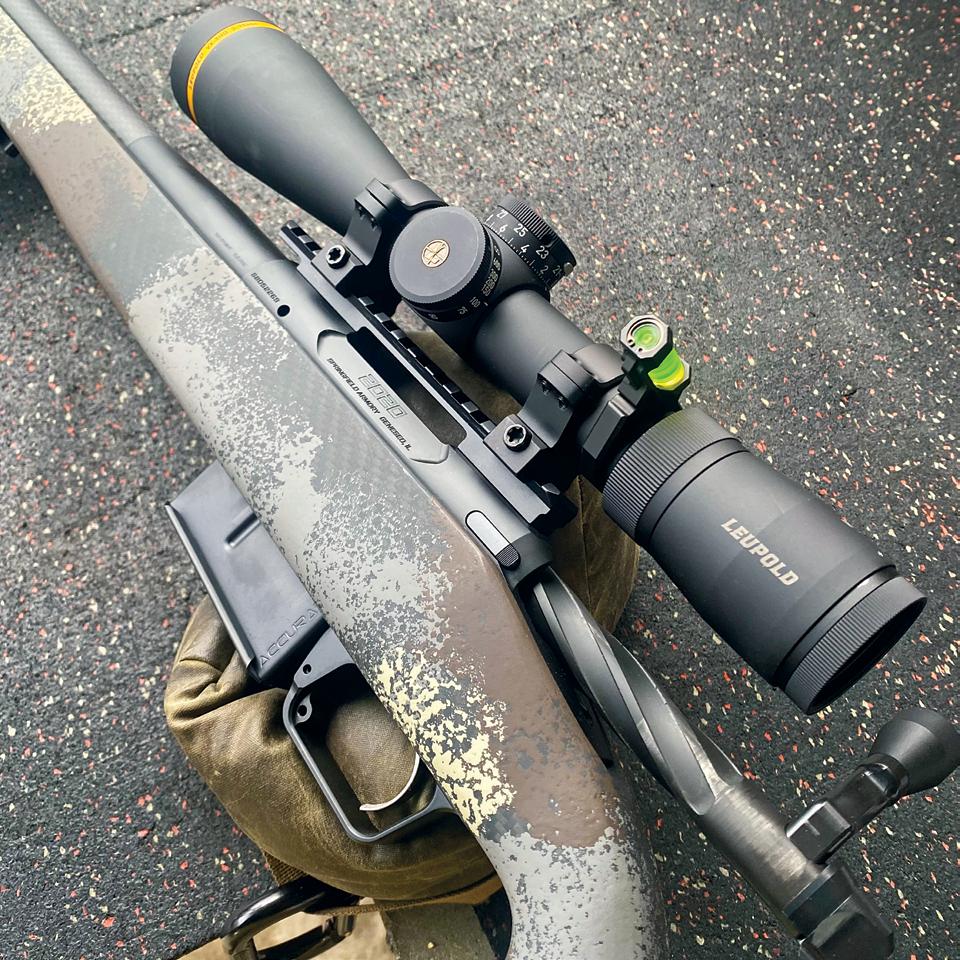
I fouled the barrel again with a few rounds and began testing in the same manner with ammunition from the same lot. The rifle continued to deliver groups with each brand in the 1-1.5" range for three-shot groups. I eventually tried a hand load I had made with ADG Brass charged with 57.0 grains of H1000 and a 156-grain Berger EOL seated at 2.950". This load is very popular with the 6.5 PRC long-range crowd for its accuracy across the spectrum of 6.5 PRC chambers in various rifles. Lo and behold, the Waypoint liked this load and shot several sub-1-MOA groups (one measured .75") at 100 yards and averaged right at 1" overall after four three-shot groups.
When it comes to factory rifles and accuracy guarantees, it’s important to remember the variables that must be considered by a manufacturer. When expectations are not met, most likely it’s the shooter, the lack of variety in ammunition tested by the shooter, or it is an issue with the rifle. I have been accused of not being able to shoot well enough
by rifle manufacturers in the past when their rifles failed to meet their own guarantee. On those occasions, the same day I tested their rifle, I shot several one-hole groups that would measure sub-.25 MOA with other rifles. It’s just the nature of the beast. I don’t put much faith in accuracy guarantees, as there are so many variables to consider.
I contacted Springfield about the rifle, and they were very good in communication. They offered to have the rifle shipped back for inspection, which is excellent customer service. I declined for the rifle to come back after inspection, as I prefer to keep my reviews to a one-and-done approach to keep the assessments fair across the board, and the rifle was loaned to me for the review. It should be noted that Springfield customer service made no excuses and never questioned anything about my testing when they offered to inspect the rifle and make it right. That is how a company should handle customer concerns about issues with a firearm. Kudos to Springfield for that.
Hits and Misses
Hits
• The overall rifle weight is well-balanced.
• A Trigger Tech trigger is a great upgrade in a factory rifle.
• The carbon fiber stock has good ergonomics and features.
• Feeding, extraction, and ejection were flawless.
• The adjustable cheek piece makes for a custom fit.
Misses
• The rifle met the accuracy guarantee only once with custom hand-loaded ammunition. I do not feel this was due to a rifle design issue, but a premium barrel would improve the overall accuracy of the rifle.
• During testing, I found that the radial brake blows excessive snow and dirt back into the shooter’s face. A side-port brake would make for an improvement.
After Action Review
While the rifle may not have performed as I had hoped in terms of accuracy with the factory ammunition most widely used for the 6.5 PRC chambering, It did show improvements with my hand-loaded ammunition that was loaded for a different rifle. I am sure I could have easily tuned a load to get better, sub-1 MOA accuracy, but I don’t do that in my factory rifle reviews as it’s not always the case for most shooters. A small percentage of hunters hand load while most shoot factory ammunition in factory rifles. I feel that shooting custom ammunition paints unrealistic expectations for what a rifle is actually capable of doing unless you hand load.
Springfield Armory has delivered a reliable rifle that meets the expectations for making the cut as a mountain rifle. A rifle that is capable of 1-MOA accuracy while being reliable in feeding, extraction, and ejection is plenty for most big game hunters across the country. The Springfield Armory 2020 Waypoint Ridgeline is a great option for the hunter looking for the proper balance of lightweight, reliable performance, and 1" accuracy with factory ammunition at the $2,500 price point. For more information on the Waypoint Ridgeline visit Springfield-armory.com

As always, help keep the gun conversation alive by emailing me at Colton@westernhunter.net with your questions or suggestions for future product reviews. Follow me on Instagram @papwinkle to see my posts and reviews regarding all things precision rifles to help make you a better rifleman.
And remember, “Only accurate rifles are interesting.” – Townsend Whelen
www.westernhunter.net 52 WESTERN HUNTER
The Waypoint rifle includes upgraded features like the side bolt release and an M5-style DBM with the magazine release button inside the trigger guard to prevent accidental release of the magazine when carried in the field.
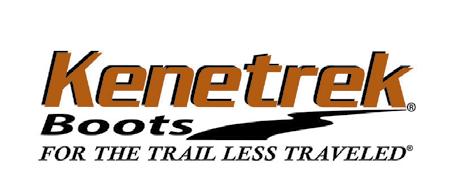


GRIZZLY PAC BOOTS
From the morning sits in the late season Whitetail stand to chasing after hounds hot on the trail of a Colorado Cougar, your boots are arguably the most important piece of gear you will use. Stay out longer, hike further, and perform better with Kenetrek Pac Boots. Built with the mountains in mind, our supportive leather uppers and high traction K-Talon™ outsole will keep you upright, while wool felt liners and extra insulation in the bottoms will keep you toasty warm in temperatures down to 0°F.

©KENETREK, LLC 2023 VISIT US ON SOCIAL WWW.KENETREK.COM 800-232-6064
ULTRA WARM + ALL DAY COMFORT FOR LATE SEASON HUNTS
ARCHERY BALLISTICS
PART 1 PROPULSION AND AIMING


ated with bows and arrows; nevertheless, the ballistics of archery equipment is an important aspect of archery that needs to be understood in order to optimize your bow and arrow setup. Archery ballistics is a very big topic, too big in fact to jam into a single article, so I am going to hit the important highlights and break it up into two separate articles.
In this first article, I am going to introduce the concepts of archery ballistics that deal with the bow and bow sight. I like to think of this as the propulsion part of the science, much like the rifle and rifle scope. The next article will be a bit more advanced
and focus on concepts that influence the flight of the arrow (trajectory) after the initial propulsion and building a sight tape.
Propulsion
Fundamentally, propulsion is a conversion of potential energy into kinetic energy. A rifle converts the potential chemical energy of the ignited gunpowder into kinetic energy of the bullet. The bow converts the potential mechanical (limb deflection) energy of the limbs into kinetic energy of the arrow. The magnitude of the propulsion of an arrow is dictated by the bow’s drivetrain, which consists of the limbs, the cams, and the bow’s power stroke.
The power stroke of the bow is simply the distance the arrow remains on the bow string when the bow is cycled. Power stroke is essentially the draw length minus the brace height. The more time the arrow spends on the bowstring, the more the energy from the limbs is transferred to the arrow. Since an archer’s draw length is fixed, only the brace height can be shortened to increase power stroke.
A general rule is that a change in total power stroke of an inch equates to about 10-15 FPS of arrow velocity. Decreasing brace height is a doubleedged sword. Decreasing brace height will, in general, decrease a bow’s forgiveness. Decreasing brace height too much can also lead to the string making
contact with the clothes on the archer’s bow arm. I shoot a 28" draw length, and for me, a brace height of 6.25" is a good balance of performance and forgiveness. A longer draw length leads to a longer power stroke, meaning the arrow spends more time on the bowstring, so the arrow is more likely to be negatively influenced by the archer. For this reason, the longer your draw length, the more you should consider a longer brace height.
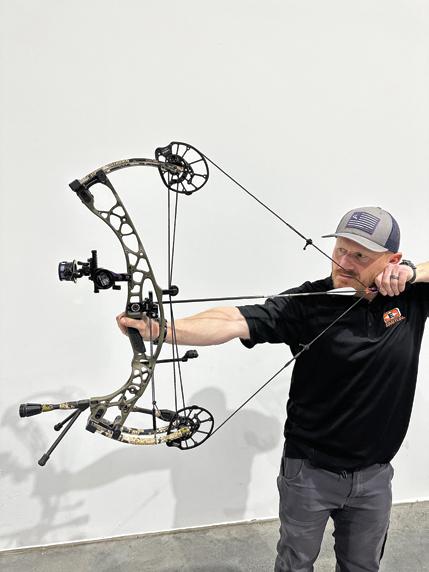
www.westernhunter.net 54 WESTERN HUNTER
The author at full draw with the new Hoyt Alpha X 30. With a brace height of 6-3/16", the Alpha X 30 has an optimized power stroke for the author with a 28" draw length.
Compound Bow Drivetrain
At the heart of a bow’s drivetrain is the cam system. The cam dictates how the bow draws, how it holds, and how efficient it is. From the moment you start to draw a bow, the force to draw increases until you hit the maximum draw force. As you continue to draw, the force to draw decreases due to let off until the minimum draw force point, or the “valley.” After the cam rolls completely over, the draw force just begins to increase again right before you hit the back wall.
Sometimes people use the word “smooth” to describe the draw cycle of a bow. What this means to me is a consistent and gradual draw force throughout the draw cycle – meaning the draw force gradually builds to maximum draw weight, then gradually decreases to the valley. A bow with a smooth draw cycle feels “easier” to draw than the peak draw weight would suggest. A more aggressive cam will build sharply to maximum draw force, remain at that draw force for most of the draw cycle, and then dump draw force rapidly to the valley.
These types of cams feel harder to draw, jerky, and you tend to hit the back wall really hard because you go from peak draw force to minimum draw force pretty quickly. These types of cams have very little valley, they can feel really “jumpy,” meaning if you creep forward at all at full draw, the bow will jerk forward into firing because the maximum draw force sits so close to the minimum draw force. There is a balance to strike in cam design preference that will be different for every archer. The benefit of a more aggressive cam is the increased bow speed it produces. If you have a shorter draw length or shoot low poundage, you should consider a bow with a more aggressive cam.
Cam efficiency relative to draw length is one of the single most important aspects to consider relative to the bow’s potential energy. Not all cam systems are perfectly optimized at every draw length. If your bow has a cam system with a draw length
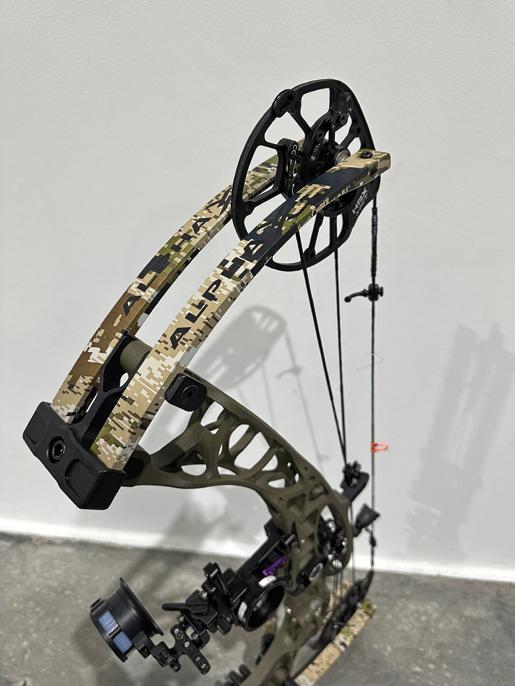
erally be most efficient at the top of the cam (longest draw length) and least efficient at the bottom of the cam (shortest draw length).
This efficiency loss is in addition to the 10 FPS decrease in arrow velocity for every inch of power stroke reduction. So, if you have a shorter draw length, you are likely getting hit with efficiency losses from a shorter power stroke AND an ineffi cient cam. For this reason, it is very important to select a bow that has a cam system that is opti mized for your draw length. For me, Hoyt’s Alpha X 30 with the smaller cam module is perfectly opti mized for my 28" draw length.
Bow draw weight (limbs) is the last component to discuss regards the propulsion of the system. The limbs (when deflected) are the fundamental source of stored mechanical energy in the bow. The cams, cables, and string only transfer the mechanical en ergy stored in the deflected limbs into the arrow. Cams provide mechanical advantage to the system by acting like a pulley system, multiplying the force applied by the archer when drawing. The shape of the cams defines the gear ratio and provides let-off as the bow is drawn. The stiffness of the limbs dic tates the peak draw weight of the bow. Every pound of increased draw weight results in roughly 2 FPS velocity gain by the arrow.

What does all of this mean for archery ballis tics? Propulsion is the foundation of an arrow’s trajectory; the arrow’s speed and kinetic energy are at a maximum right when the arrow leaves the string. Choosing the right bow for YOU and setting it up correctly are of paramount importance to optimize your ballistics. For more information about selecting the right bow for you, read my article, Bow Selection Guide in the Sept/Oct issue of Western Hunter
Trajectory
Once the arrow leaves the bow, the trajectory starts. How the trajectory curve is shaped is a function of the arrow’s initial velocity, its weight, and its drag. My next article will take a deep dive into discussing these influencing factors and optimizing the trajectory of the arrow. But, in this article, we need to discuss tracking that trajectory curve, however it is shaped, so that you can accurately aim.
The fundamental purpose of the bow sight is to provide focused aiming points (pins) that mark the impact locations of your arrows at various yardages based on the arrows’ trajectory. Simply put, a bow sight is a device that tracks the trajectory of your arrow. Whether you shoot an arrow with a fast, flat trajectory or a slower trajectory, there are many different bow sight options and configurations to best track the trajectory of your arrow. I have experience shooting arrows on both ends of the trajectory spectrum, and I have completely different bow sight design philosophies for each.
My main passion is bowhunting mule deer in open terrain. The single biggest archery mistake I have witnessed with myself and my hunting partners on these hunts is miss-ranging the animal. So, I have specialized my archery equipment for this pursuit to maximize my effectiveness. The most important thing for me is to design my bow and arrow to produce a fast, flat trajectory so that I have more margin for error on my range estimation.
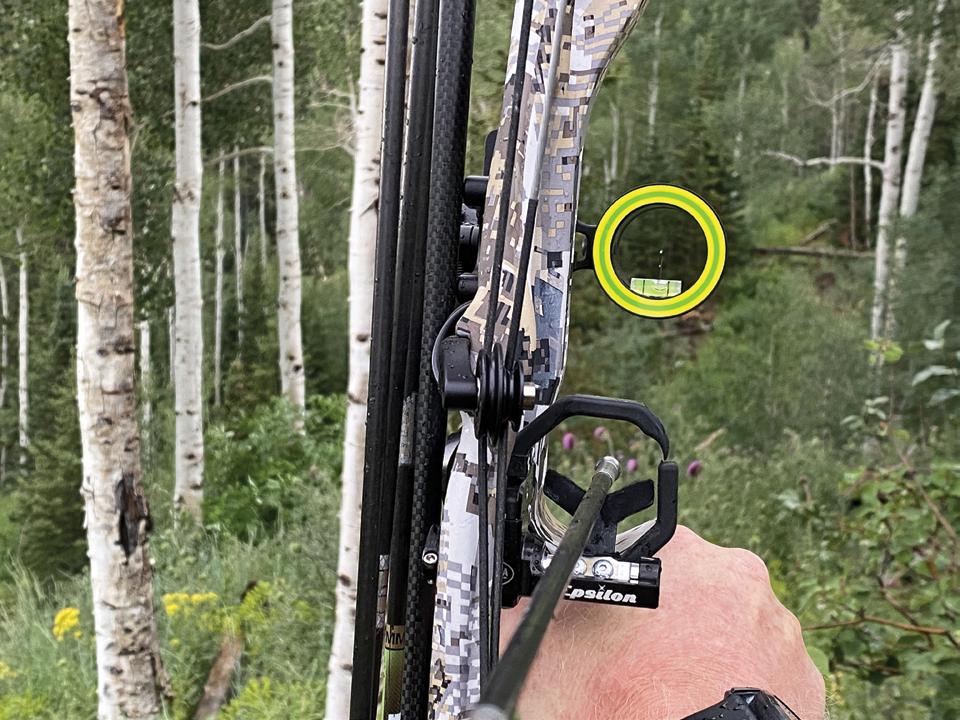
info@westernhunter.net 55 WESTERN HUNTER
Not all compound bow cams are created equal. The cam dictates how the bow draws, how it holds, and how efficient the bow is. The Hoyt HBX Xact cam strikes a perfect balance of smooth and efficient.
The limbs of the bow (when deflected) are the fundamental source of stored mechanical energy in the bow. Every increased pound of draw weight results in roughly 2 FPS velocity gain by the arrow.
Fundamentally, the bow sight is a device that tracks the trajectory or ballistics of your arrow and provides focused aiming points for that trajectory.
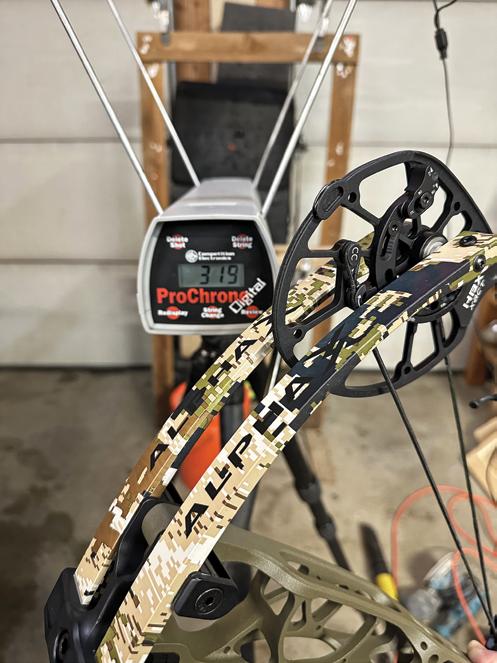
This actually presents some problems because with the pins being all close together, the sight pic ture is quite cluttered. For this reason, I used to be a diehard three-horizontal-pin slider sight kind of guy instead of a five-pin slider guy. I’d run 30, 40, and 50-yard pins to help alleviate the busyness of the sight picture. The sight picture was still a little cluttered, but it was manageable. Fast-forward to the advent of the double vertical pin, and my phi losophy changed.
Vertical Single Pin Bow Sight
Currently, my go-to sight for my main (fastarrow) setup is the Spot Hogg Fast Eddie Double Pin. This vertical pin setup has drastically changed my fast arrow shooting experience for the better. It has removed substantial clutter from my sight pic ture and it still provides three solid aiming points. How does a double vertical pin provide three solid aiming points? Two of the three aiming points are self-explanatory – there are two fiber optic points.
Think about it, if the arc of my arrow is minimized, I am more likely to hit where I am aiming if my range estimate isn’t perfect. To this end, for 2024, I am shooting a Hoyt Alpha X 30 at 80 lb and a 28" draw length. It is kicking out a 422 grain Easton X10 Parallel Pro at 320 FPS. You may be thinking that is crazy fast for a 28" draw length, and it is! I have strategically selected this bow because it is incredibly efficient and optimized for a 28" draw length.
It just so happens that when the top fiber on my Fast Eddie corresponds to 30 yards, the bottom fiber is pretty much right at 50 yards. It is more like 31 yards and 50 yards, but that’s pretty close. The third aiming point is pin gapping at 40 yards be tween the two fiber optics. This seems trivial and obvious (because you can theoretically pin gap with any multi-pin sight), but I assure you it’s not the same. If you follow my aiming philosophy with the vertical pin, it is way easier to accurately pin gap with a vertical pin compared to horizontal pins.

The first thing I need to state is that this philosophy is most applicable for arrows traveling over 300 FPS (the faster the better). Because my arrow’s trajectory is very flat, the distance between my 30yard pin and my theoretical 40-yard pin is about the same distance as from my theoretical 40-yard pin to my 50-yard pin. This means that my theoretical 40-yard pin is pretty close to centered between my 30 and 50-yard pins (not exactly, but plenty close enough for bowhunting). Caution, this is NOT a safe assumption for slower arrows.
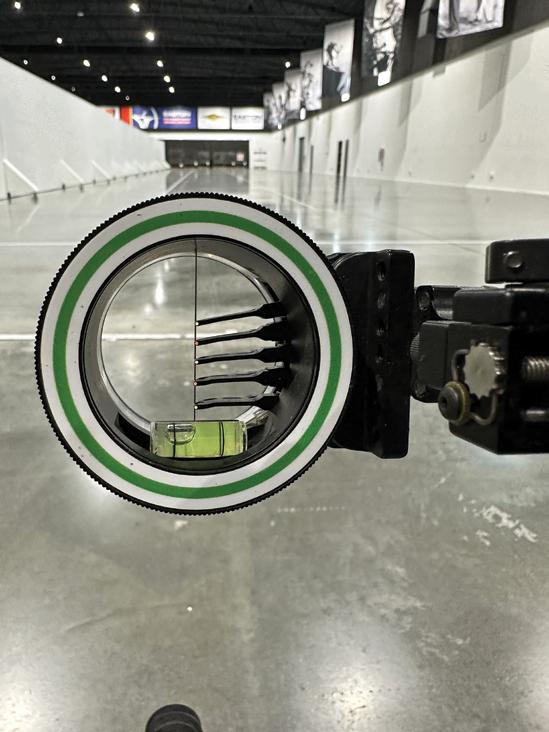
Imagine pin gapping with a two-horizontalpin setup at 30 and 50 yards, for comparison. The nature of pin gapping is guessing on your holding point by using the adjacent pins in the sight housing. When pin gapping with horizontal pins, you not only lose a vertical aiming point reference but also a horizontal aiming point reference. This means that you are not only estimating (guessing) on the vertical aiming between the pins but also the horizontal (left and right) aiming. This needs to sink in, so I will state it again: On a horizontal pin setup, there is nothing physically in the sight between the 30 and 50-yard pins to aim with, so you are guessing on the vertical and horizontal aiming points.
With a vertical double-pin sight, this is not the case; the black pin post itself in between the 30 and 50-yard fiber optics serves as your horizontal
aiming reference. With the double vertical pin, you are only estimating your up-and-down holding point, as the black pin post serves as your left and right reference. Since you are only estimating (guessing) on the vertical hold, it is substantially easier and more accurate to pin gap with a double vertical pin.
After all, aiming in the heat of the moment is hard enough, so any simplification you can make is substantial. With this philosophy on the Fast Ed-

56
The Hoyt Alpha X 30 is incredibly efficient at a 28" draw length, kicking out a 420 grain arrow at 319 feet per second (80 lb limbs).
The author’s Spot Hogg Fast Eddie double pin bow sight in its base position has pins at 31 yards and 50 yards.
The sight picture with a 5 pin sight is pretty busy especially if you are shooting a fast arrow and all of the pins are bunched closely together.
There isn’t a bow sight with a more simple sight picture than a Spot Hogg single vertical pin.
STARTING FROM SCR ATCH


O U T D O O R S M A N S . C O M 1 - 8 0 0 - 2 9 1 - 8 0 6 5

40 yards to the point that I don’t need a 40-yard pin. So, I say again, I have three solid aiming points with the vertical double pin sight, but only have one single pin post to obstruct my view. It is way more efficient than a horizontal three-pin.
Since the double vertical pin (fixed locations) came out, there is now a triple vertical pin sight head called the Spot Hogg Triple Stack. The benefit of the Triple Stack is that the pins are independently adjustable for elevations, unlike the fixed double-pin. If you are shooting a slower arrow, this is an awesome option to reduce clutter and still have three aiming points. I prefer the double pin because the Triple Stack sight housing is heavy and big. It weighs about 2.5 oz more than the doublepin housing. 2.5 ounces may not sound like a lot, but it is more than 20% of the total sight weight, so it is substantial.
“Picking a Spot” with a Single Pin
While we are on the subject of aiming with a vertical pin, I want to explain how I aim and line up on an animal, specifically with a vertical pin. Much like the discussion above about how important it is to have points of reference for pin gapping, the same goes for aiming on an animal. Many bowhunters report that it is difficult to pick a spot and hold on an animal; their aiming point seems to wander or “get lost” in the fur. I believe the rea-

son why this happens is because of poor aiming philosophy, and it can be corrected with a different perspective on picking a spot.
When I aim on an animal, I’m not focused on a single spot behind the shoulder, instead, I focus on defined body parts of the animal and independently lining up horizontally, then vertically. After anchoring and leveling, I aim horizontally by putting the vertical black pin parallel to the front legs. For a broadside shot, I like to clearly see all of the front leg in front of the black pin. If it’s a quartering-away shot, I put the black pin right on and parallel with the opposite side front leg. If it’s a slightly quartering-to shot, I put the black pin right on and parallel with the near side front leg. Using the front leg as your horizontal reference is extremely easy and intuitive with a vertical pin sight.
In the mountains, there can be some crazy angles, so the pin may not be exactly parallel to the front legs, but you get the point. Once I am lined up horizontally, I aim vertically by placing the fiber optic pin where I estimate the vertical midpoint of the body cavity to be, between the bottom of the stomach/chest and the top of the back. With the pin locked horizontally relative to the front legs, I find it very easy to lift the fiber optic point up and down to find the middle of the body cavity vertically. With this approach, I am only really estimating/ guessing on my vertical hold, since the pin post to
front leg reference is so solid. Instead of just picking and trying to focus horizontally and vertically on a random spot right behind the shoulder, I zoom out a little bit and use very defined body features to help me aim more systematically.
Horizontal Multi-pin Bow Sight
If you have followed my content here in Western Hunter or on my social media, you have undoubtedly seen that I like to design two different arrow builds to shoot from my bow. Just as I like to shoot a fast arrow for open country hunting to maximize range forgiveness, I like to shoot a heavy arrow (550 grains to 650 grains) for hunts with short-range situations to maximize penetration and shot angle forgiveness. I also incorporate different sights and pin configurations for my different arrow setups.
For my heavy arrow setup, I like a 4-horizontal-pin slider sight with pins at 20, 30, 40, and 50 yards. I like being able to shoot accurately out to 50 yards without having to dial my sight. Close-range shot opportunities are generally really quick encounters, so being able to shoot without having to take the time to dial is a significant advantage.
The reason why I’m okay with and prefer more pins in my sight housing for my heavy arrow setup is the slower arrow trajectory; the pins are more spread out which opens up the sight picture. Generally, the trajectory is slow enough on my heavy
www.westernhunter.net 58 WESTERN HUNTER
Pin gapping with the Spot Hogg vertical double pin sight is inherently more accurate than with a horizontal pin sight because the black pin post in between the fiber optics can be used as an aiming reference for the horizontal.
The author uses a more systematic approach to “picking a spot” on an animal that allows him to use the vertical front leg and the horizontal back and chest/stomach lines as reference points for aiming.
HANDLE WITH CARE


O U T D O O R S M A N S . C O M 1 - 8 0 0 - 2 9 1 - 8 0 6 5
arrow setup that pin gapping becomes difficult if I have more than 10-yard increments between my pins (unlike my fast arrow setup, where I can confidently pin gap between 30 and 50-yard pins).
For the horizontal multi-pin sight, I really like the Option Archery Canyon Pounder. My aiming philosophy is different for a horizontal pin sight. I generally use the horizontal nature of the pin to help me line up on an animal. When aiming on an animal, I like to see that the horizontal pin sits more or less parallel to the body cavity of the buck. This helps me to line up my pin right in the middle of the animal’s back and brisket/belly. This is a very similar concept


Conclusion
Archery ballistics need to be understood in order to fully maximize your bow and arrow setup. The propulsion of the arrow starts with the bow, and the bow needs to be optimized to produce the best results for you specifically. Attached to the bow, the bow sight is nothing more than a device that helps you track the trajectory, or ballistics, of your arrow. I use different bow sights on different bows depending on the trajectory of the arrow. I think there are clear benefits to using different pin configurations for different applications.
A big part of ballistics is aiming, pin gapping, and holding over. I take a different approach to aiming depending on my pin configuration. Part of aiming is knowing how and where to hold on an animal. I take a more systematic approach to “picking a spot” that allows me to use more defined body features for aiming, so I don’t get lost wandering in the fur behind the shoulder. When it’s all said and done, studying archery ballistics will make you a better bow hunter!
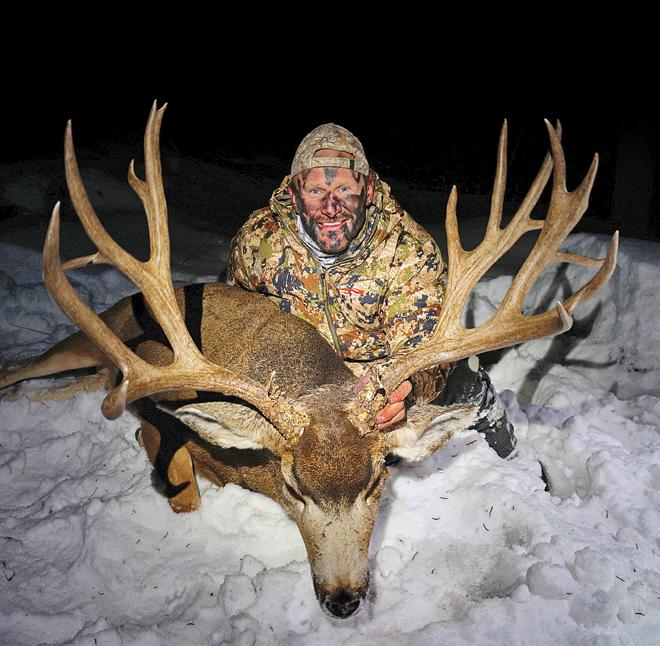

www.westernhunter.net 60 WESTERN HUNTER
When aiming with a horizontal pin sight, the author focuses on the horizontal pin post being parallel to and right in the middle between the horizontal chest/stomach line and the back line of the animal.
A big part of ballistics that will be discussed more in the second part of this series is steep uphill and downhill shooting and accurately accounting for the steep angle in your ballistics.
Fully understanding your bow and arrow ballistics will directly lead to more success in the field. From optimizing your trajectory to systematically aiming, there’s lots to learn and develop.


our products. START
FINISH O U T D O O R S M A N S . C O M 1 - 8 0 0 - 2 9 1 - 8 0 6 5
TO
 MIKE DUPLAN HUNTING EDITOR
MIKE DUPLAN HUNTING EDITOR
INSIDE THE CHAOS AND SECRECY SURROUNDING THE RELEASE OF 10 WOLVES IN COLORADO
In November 2020, Colorado voters approved Proposition 114 which required the Colorado Parks and Wildlife Department (CPW) to create a plan to reintroduce and manage gray wolves on designated lands west of the Continental Divide by the end of 2023. This proposition sounds innocent and innocuous to the uninformed, rapturous to the wolf-lovers, and highly concerning to hunters and livestock ranchers.
This reintroduction carries weight beyond simply having wolves on the landscape and plays into the culture war currently going on in this country. Additionally, some believe that there is a far greater plan from the national animal activist community to create a ground zero for a seeding population of wolves in the centrally located Colorado. This would provide a spreading and population increase of wolves to seven different states that share a border with Colorado.
History
Finding a starting point to tell this story probably takes us back 20-plus years to when pro-wolf and predator groups actively lobbied Colorado Parks & Wildlife (formerly known as the Colorado Division of Wildlife) at meetings of the CPW Wildlife Commission. There was a desire by some animal activists to have reintroduction plans for grizzlies, wolves, lynx, and wolverines to Colorado. What was decided was that human development and populations in Colorado had expanded to the extent that there would be too many human and livestock con-

flicts with grizzly bears and wolves, so no plan was initiated. A reintroduction of lynx took place with marginal results, several lynx casualties, and now rare sightings of the animal in areas where the cats were released. The wolf remained this enigmatic shadow in the backdrop of wildlife management issues that were occasionally discussed and rebuked. It was not until Jared Polis was elected governor of the state of Colorado in 2018 did serious wolf reintroduction discussions started taking place again by government officials. These changes have far-reaching intent and ramifications beyond the simple reintroduction of wolves.
Polis Administration
Governor Jared Polis has a long personal history in politics and was a five-term congressman for Colorado. Nowhere in his personal or political history was there much evidence of wildlife and or animal welfare-related advocacy, so the push toward wolf reintroduction seemed out of his target zone as governor of Colorado. However, Polis’s husband, Marlon Reis, is recognized on the national level as a vegan animal activist whom some call an “extremist,” and he is quite obviously helping to craft policy towards livestock and wildlife in Colorado.“My passion is definitely animal welfare,” said Reis in a 2019 interview. What is very apparent at this point is that there is a very sympathetic person in the governor’s mansion to animal activism and anti-hunting and antilivestock groups.
www.westernhunter.net 62 WESTERN HUNTER
Some may shrug off this aspect of wildlife management and policy in Colorado as being a sideshow to many of the other aspects of Polis’s policies. However, hunters, anglers, and ranchers have found out that this is very alarming, and there are active attempts in place to completely change the face of Colorado wildlife management and public lands utilization.
One of Polis’s first consequential acts as the new governor toward hunters and anglers was to completely rebuild the CPW Board of Commissioners. The Commission is an 11-seat board composed of citizens of Colorado that are hand-picked by the governor and sets regulations and policies for Colorado’s wildlife and state parks.
What is very apparent a few short years later is that the makeup of the commission has been crafted as an echo chamber where hunters seemed to have lost a voice and representation. Not only that, current commission members have professional careers entrenched in activism and animal welfare/rights issues. To assume they bring unbiased altruism toward wildlife and sportsmen and women is nothing short of simple ignorance and wishful thinking. There is an agenda in play, and the future of hunting in Colorado for our children and theirs hangs in a precarious place.
Selective Attention
Governor Polis made a public promise to the people of Colorado that wolves would be on the ground in Colorado by the end of 2023. What we have seen is that the opposition to the reintroduction or the concerns about the effects that this will have on the livestock industry are of zero consequence to the governor. So far, lip service and indifference are the only responses given to the opposition. This is especially troubling considering the ballot initiative passed by only around 10,000 votes in a state of nearly six million people and was approved by primarily urban voters with very little skin in the game.
What has been also apparent is that those who drafted the bill and the supporters of it wrote it in a way to bypass federal regulations and control and to create language where no lethal control of wolves would be permitted. Ranchers were prohibited from protecting their property and livestock and had to rely on state employees to attempt to haze wolves from their property. Some livestock losses have already occurred by wolves who made their way into Colorado from Wyoming, and these wolves have even killed and eaten pet dogs near Walden, Colorado.
Warning Signs
In the summer of 2023, wolves had pretty much dropped off the news cycle and out of the public eye. Behind the scenes, plans were being crafted for the capture and reintroduction, but some states such as Wyoming, Idaho, and Montana stated they would not be giving wolves to Colorado. This is of no conse-

quence to those who have crafted the reintroduction plan, and the external hiring of the new director for Colorado Parks and Wildlife, Jeff Davis, from the state of Washington, should have been a clue.
Davis was hired to replace former director Dan Prenzlow after a controversial comment by Prenzlow was taken out of context at a public meeting. It’s no secret that most wildlife managers within CPW opposed the wolf reintroduction for decades, so a supportive administrator was brought in from the outside to implement the wolf plan. Davis most likely had friends where he hailed from in the Northwest, as Oregon stepped up to the plate and wolves were promised to Colorado.
Empty Policy
In September of 2023, the federal government was also injected into the state’s business when the US Fish and Wildlife Service published an environmental review of what is called the 10(j) rule. This rule would permit the lethal control of wolves in certain circumstances, such as the protection of livestock. The only caveat is the state agency, Colorado Parks and Wildlife, must approve the issuance of such a permit. At this point, under Governor Polis’s leadership, that has not happened with an application from a North Park Colorado rancher who applied for the permit, and it seems to be a highly unlikely scenario moving forward with the current administration.
Contested Issue
With the looming end-of-2023 reintroduction promise by Polis, legal action seemed imminent. Expectedly, the Colorado Cattleman’s Association and the Gunnison County Stockgrowers Association filed suit in December in a last-ditch effort to stop or slow the release of wolves. A judge ruled quite promptly that the release would go on as planned, and the efforts to stop or even slow the process were nullified. At this point, it appeared unlikely that any efforts would derail the wolf reintroduction process, and speculation ran wild on when and where wolves would hit the ground.
Criteria for the release narrowed the location down to a relatively small area in Colorado that would most likely point toward Eagle County north of Interstate 70 as the prime location. Monday, December 18th will go down in history as the start of a new plan for Western Colorado, as it was the day that five wolves were released near Radium on a State Wildlife Area property.
Backdoor Release
The release was done in relative secrecy with some CPW employees, Governor Jared Polis and his husband, and a few dozen others who are most likely supportive wolf advocates who received invitations for speculative reasons. Not invited nor even notified were local government officials for the counties impacted nor any others not existing in the wolf advocacy echo chamber.
info@westernhunter.net 63 WESTERN HUNTER
The map released by Colorado Parks and Wildlife shows nothing more than river drainages where collared wolves have traveled. Broad-based and lacking tangible information, there is nothing to give the public or impacted ranchers any working information. This furthers the appearance of distrust towards the public by the state of Colorado.
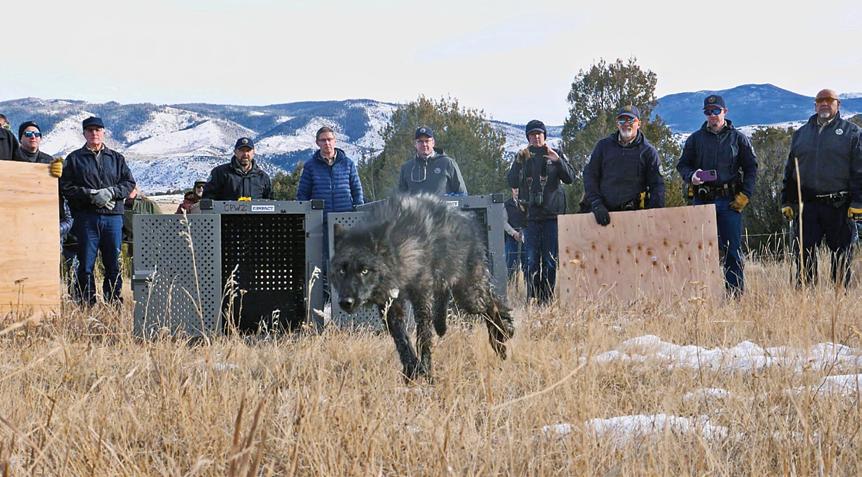
What’s even more astonishing is that some Wildlife Commissioners were not notified of the release, and one of them found out on the evening news. Additionally, Merrit Linke, a Grand County Commissioner who was a member of the Technical Working Group for the Wolf Release, was not invited, even though the releases occurred almost in his backyard and other members were present at the release. These acts speak for themselves and suggest that the only non-CPW people present were ardent supporters of the reintroduction and imply a private-party-like atmosphere to the event.
Coincidentally, there was a “Wolf Update for Livestock Producers” meeting taking place in Craig, Colorado, 70 air miles away from the release site between local ranchers and CPW officials that was hosted by the Colorado State University Extension. Presumably, this was more of an attempt to continue the conversation and foster the working relationship between ranchers and state employees. Partway through this meeting, an announcement was made that five wolves had been released that day. One can only imagine the palpable angst that must have settled over the attendees at that moment.
Fallout Report
As the days progressed, information trickled out about the wolves and the release, most of which begged questions and concerns. Also brought to light were some really poor optics, tactics, and amplification of the existing mistrust in Governor Polis and CPW concerning the process.
Two well-written and informative articles on the release and the wolves were penned by columnist Cat Urbigkit of the Cowboy State Daily and Rachel Gabel of The Fence Post, both detailing missteps, misinformation, and the obvious lack of transparency in the process due to an absence of trust toward the people who call the Western Slope of Colorado home.
The current story is that for this project, 10 wolves were captured in Oregon in December, presumably via net gunning. These were then presumably health-checked and pregnancy-checked (“presumably” is used because of the lack of candid information). What is alarming is that some of the wolves were captured from packs that were involved in and had a history of livestock depredation in Oregon. This information was not released by CPW but instead came from some investigative journalism by Rachel Gabel


Cat writes in her online article for the Cowboy State Daily about the release, and anyone reading it can quite clearly see that this was an “at-any-cost” effort by the governor to keep his promise to his supporters and the wolf advocacy contingency. Cat states, “Over the last two years, the message to Colorado livestock producers has been to do all they can to reduce the risk of livestock depredations, and producers have been stepping up to do that. The words ‘conflict minimization’ [are] repeated 176 times in Colorado’s wolf plan. So, when the same agency then takes an action that appears to increase the risk of conflict to livestock producers, what message does that relay?”
When Rachel Gabel blew up the official narrative of the history of the released wolves, Governor Polis’s husband Marlon Reis took to social media the weekend before Christmas and initiated a slander attack for her reporting. Reis deleted some of the Facebook comments he made in short order, but Cat Urbigkit took screenshots of them as evidence of the involvement and demeanor of the First Gentleman of Colorado towards any who question the official narrative or oppose the program of wolf reintroduction that he is heavily involved in.
Vague Information
A month later, in January of 2024, all we really have are the anecdotal rumors from social media on wolf locations and an extremely generic map of river drainages where wolves have been, according to radio collar data that was released to the public by CPW. The map shows a large chunk of country with uneven boundaries set by ridgelines and drainage boundaries, but it is essentially from the Continental Divide to near the Utah line and Interstate 70 to the Wyoming border. Zero other information of substance has been released by the state.
There is innuendo in the continued lack of transparency and unwillingness to share wolf radio collar data from the first month of there being paws on the ground. No one has spoken of this with an outside voice, but there is an implication that the wolves need protection from threats. This is mainly generated on social media by some who are very upset by the entire process and consider the wolf reintroduction a threat to lifestyle and financial well-being.
It’s worth noting that none of the wolves that were already present in Colorado have been killed or harmed by livestock growers, even when their livestock and pet dogs were killed. These people oppose wolves on the landscape but respect the rule of law and have chosen instead to fight the battle in the court of public opinion.
Simply put, threats against wolves really don’t have much validity at this point. The number of people that would be willing to shoot or harm a wolf and face the full force of both federal and state law enforcement, prosecution, fines and maybe jail time seems to be of no real consequence. So, why the secrecy?
www.westernhunter.net
Todd Schmidt took these photos about two weeks after the initial wolf release of this collared wolf just east of Radium State Wildlife Area. Todd was driving to work and was stunned to see this wolf right off the road, close enough that he took the pics with his cellphone. Immediately above this spot is the south facing winter range of the ewe and lamb bighorn group in the area.
Jerry Neal
TABLE TO FIELD


time worrying about it
O U T D O O R S M A N S . C O M 1 - 8 0 0 - 2 9 1 - 8 0 6 5
That certainly begs some answers, brings into question the trust of the state towards West Slope residents, and amplifies the distrust of these same people towards the state and CPW. The release appeared rushed, and some may consider it reckless when compared to the care and time taken with the Yellowstone wolf reintroduction. In the case of the CO release, wolves were simply captured, transported, and quickly dumped in locations where no resistance could be given and, seemingly, to meet the deadline and the political promise Polis made to his supporters.
Direct Consequences
A group of five wolves was released in the Radium State Wildlife Area west of Kremmling along the Colorado River, and another pair were released in the Blue River State Wildlife area north of Silverthorne near Green Mountain reservoir. The locations were not publicized but instead confirmed by eyewitness accounts and terrain recognition in the photos and video from the press release.
For bighorn advocates, this release location was extremely concerning, as hundreds of thousands of dollars were spent on a sheep reintroduction program immediately adjacent to the wolf release point, and the herd had grown enough to allow limited permits during the last few years. The sheep were intended to occupy Gore Canyon where the Colorado River cuts through the ridge boundary of Middle Park on the West side but instead, the sheep frequent the open sage and grass hillsides where forage is better and more obtainable.
The sheep would have to react quickly to the presence of wolves and adjust their habitat use to rockier, cliffed-out aspects of the terrain to avoid what could be a total slaughter of the herd if they continued to occupy the open areas away from security. A few weeks after the release, a lone collared wolf was spotted and photographed from the road in the area, in the exact location that the ewe and lamb group in the unit utilizes for winter range. If there was any consideration for the bighorns and the efforts made for their reintroduction, it was obviously deemed less important than the wolf release.
The wolf is not going away in Colorado – much to the dismay of sportsmen and women who see the wolf as a threat and competition to their lifestyle and despite concerns by livestock growers.
Governor Polis will be in office and will be term-limited in three years, but it’s clear that his agenda will be to support and promote the growth of the wolf population in Colorado. There are population goals established, but there is also a high level of distaste and opposition to any sort of wolf hunting or control once
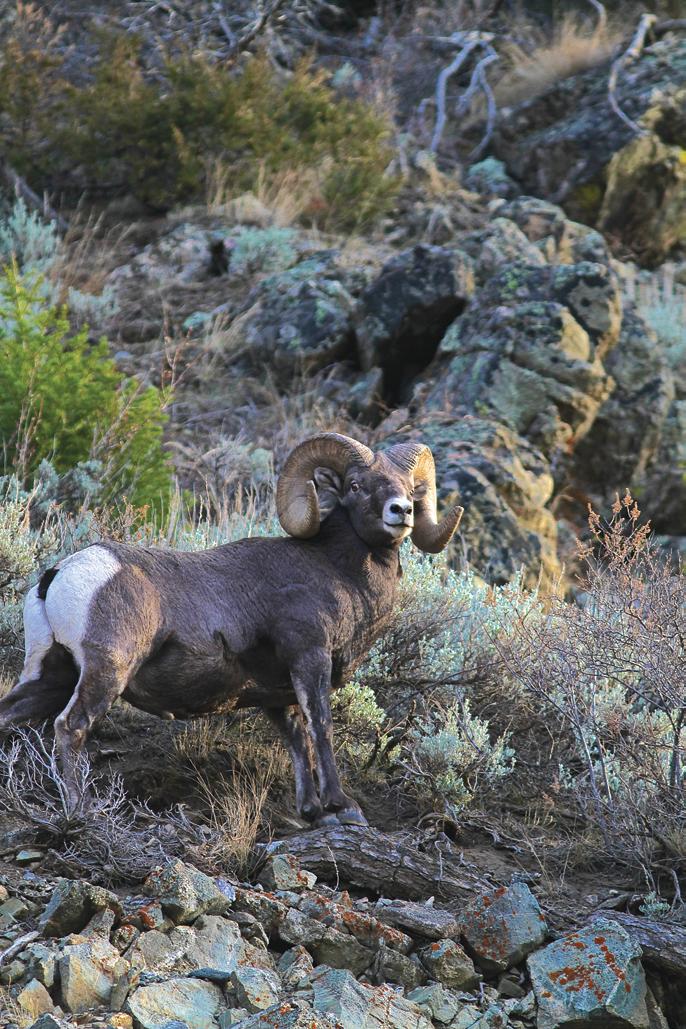
Middle Park, near Kremmling, is a historical deer hunting area that had high populations of animals and offered tremendous hunting opportunity for sportspersons. Due to Chronic Wasting Disease, populations are down, and hunting permits were dramatically increased in an experimental attempt to slow the spread of disease simply by decreasing population density and mature buck representation in the herd. Mature mule deer bucks are considered to be the primary spreaders of CWD because they travel from doe group to doe group while rutting.
Uncertain Future
Wolf populations on the landscape will have an impact in the future, but no one really knows what will happen. What we do know is that other states report heavy impacts from wolves on ungulate populations. Still, some are of the anecdotal opinion that wolves have made some ungulate populations stronger
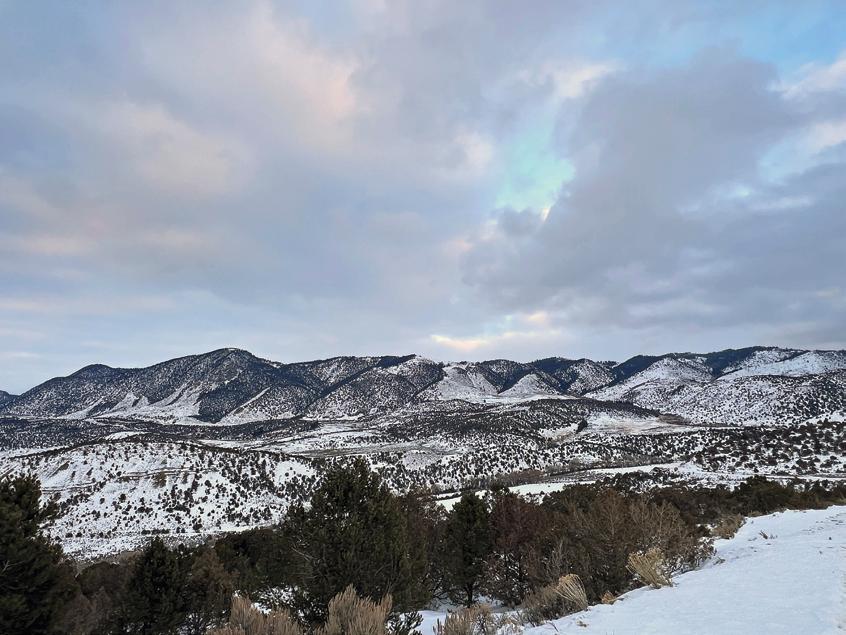
Wolves are here in Colorado to stay. That is without question. What will be interesting to see is how they fit in and whether can they stay out of excessive conflict with livestock producers. It is also unknown whether these wolves will reduce deer and elk herds to the point of a reduction of hunting opportunity – not to mention the hunting dollar, which both small-town economies and Colorado Parks and Wildlife rely upon.
A growing urban population on the Front Range of Colorado controls the political direction the state takes. Increasing numbers of people who lack experience and knowledge of the lifestyles and livelihoods of rural Western Colorado residents will probably be the driving force behind wildlife management moving into the future. Consumptive users such as hunters and fishermen are the minorities and must find a place to articulate the value of their way of life to those who get their information from television documentaries and well-funded animal welfare activists who aren’t afraid of using deception to get their way and impose their value sets. It’s these challenges hunters must address and push back on if they want the tradition of hunting to survive for future generations.

www.westernhunter.net 66 WESTERN HUNTER
The terrain surrounding Radium State Wildlife Area where the first group of five wolves were released has been managed actively through the last decade plus with controlled burns, mechanical habitat improvement and removal of immature pinion and juniper trees that are encroaching on critical sagebrush winter range.
This ram was taken by Victor Clark, the winner of the 2017 statewide sheep tag raffle. The raffle raised well over $100,000 as did the auction tag that year, funds from which are used for habitat projects for wild sheep and other big game animals. The wolf reintroduction project is costing citizens millions of dollars and will continue to cost the state, businesses and livestock producers for years to come with lost revenue from decreased hunting license sales and depredation reimbursements.
Mike Duplan
Mike Duplan
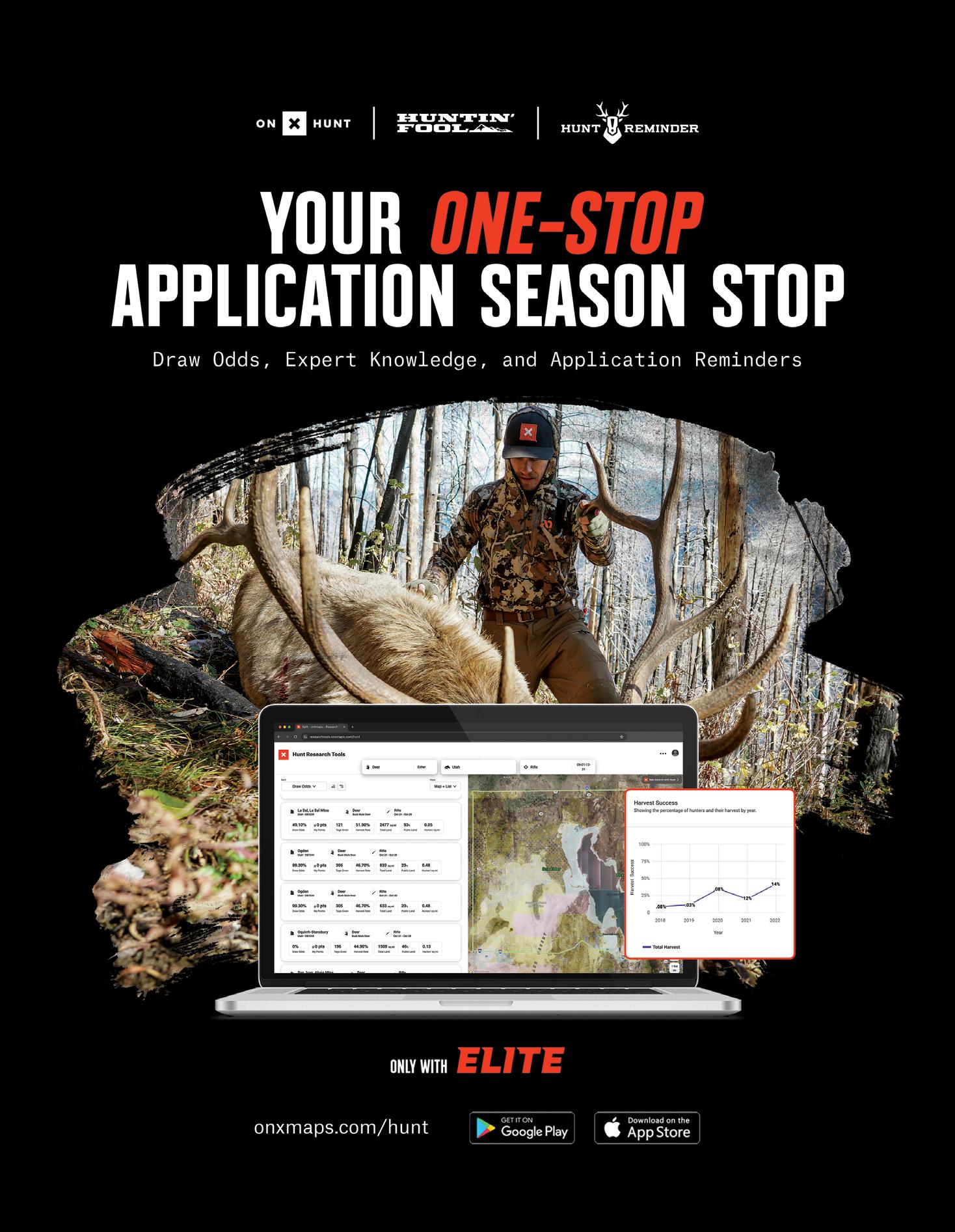
BAITING BEARS
EXTEND YOUR SEASON AND YOUR SKILLS

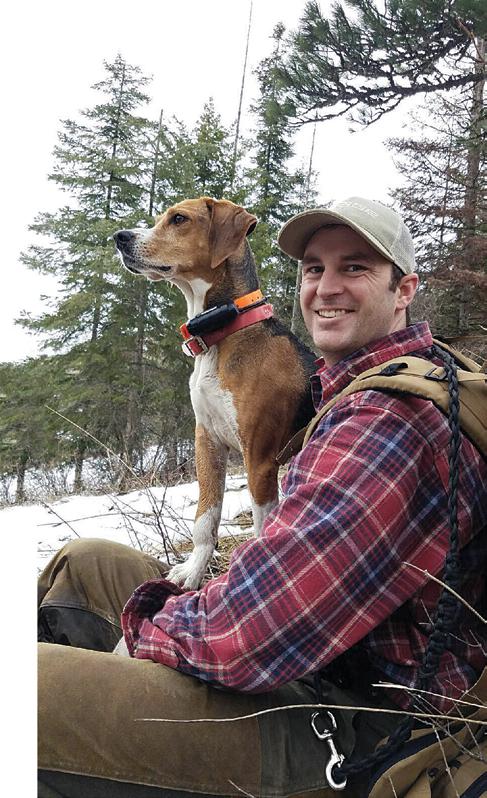
lot of work to find a good spot, haul bait regularly, hang tree stands, check trail cameras, and have the patience, persistence, and courage to make a wellplaced shot on a big bruin. It also provides hunters with an ideal method of selective harvest. At close range, it is easy to decipher males from females and selectively manage populations with consistency.
When I was growing up, we were allowed two bear tags per year. During the fall I was busy hunting deer and elk, but those bear tags allowed me to keep hunting big game during the spring and summer months. Back in those days I didn’t have hounds to hunt with, so we hunted bears either by spot-and-stalk or baiting. Being a bow hunter, baiting bears was always my preferred method. It affords you countless opportunities to make yourself a better hunter. You must study the terrain, practice
stand placement, and learn to keep your wits during ultra-close-range encounters with predators. Most importantly to me, it kept me hunting outside of the traditional fall season.
Through the years I have met a lot of people who talk about wanting to become better hunters. Hunting season comes, they hunt their deer and elk, and then they shut it down until the next fall. When I bring up baiting bears, they don’t seem to comprehend that it allows them to hunt big game six months out of the year, extending their opportunity to become a better, more well-rounded hunter and outdoorsman. I spent most of my youth hauling bait and climbing trees with my brothers, and in those years, it taught me a lot about the outdoors all while building my confidence to make the shot count in any hunting situation.
www.westernhunter.net
Bait Site Location
The first thing I look for when searching for a bait site is a large, remote canyon. It needs to have a good population of bears or be in a spot bears use as a travel corridor between large canyons. Within this area, I will look for a bench, saddle, or ridgetop where standard morning and evening thermals can be slightly disrupted. Mature bears will almost always circle downwind before committing to bait, and you should use any advantage you can to prevent them from being able to smell you on their approach.
In the springtime, bears will frequently be feeding on the south and west-facing slopes where food sources are typically growing. These open hillsides are good for spotting bears at first or last light, but when it comes to baiting them, I prefer to have cover of brush and timber. Mature bears don’t like to expose themselves very often, and it’s my opinion that you will have better success getting them to commit to bait under cover than in the open. Once I have found a successful bait site location, I try to keep that site as an established site for years to come. Bears tend to return to these areas even after the bait has been removed to chew on greasesoaked logs and check if food has returned.
Bait
Grease can be carried in milk jugs or five-gallon buckets and mixed with the food. Bears can smell the grease from a great distance, and once bears start hitting your bait, they will track it all over the countryside. This seems to make it easier for other bears to find your bait site.
When using grease or molasses, I like to dump a puddle on the ground in front of the bait barrel, ensuring it gets on the bear’s paws so they can disperse the scent when they travel. If you have a friend or two who are baiting, you can go in together on a pallet of dog food to reduce your costs. Just make sure to follow regulations regarding what bait is allowed in the area you are hunting.
When I start a bait site, I will typically use a 50-lb bag of dog food mixed with fryer grease. We have also had very good results using commercial scents, specifically BoarMasters Wildlife Attractant. The more scent you have out, the more quickly bears will locate your bait. We mix a few drops of concentration into the grease and food and rub some of the attractant into the bark or on the undersides of branches to keep the scent from being washed away by rain. Once bears are consistently hitting the bait, I will stop using the attractants and let the odor of the bait draw them in.
Once the bait is getting hit regularly by bears, I will try to bait it as much as possible to keep it full
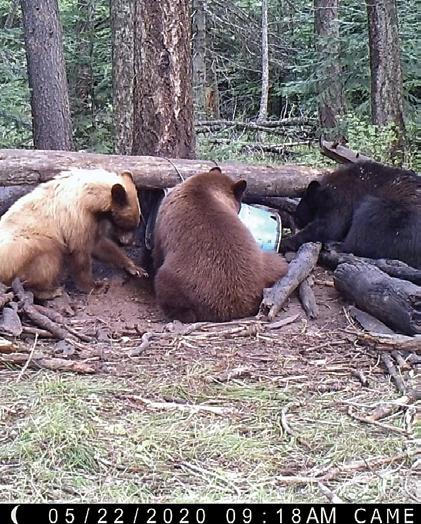
If you have a connection with a local bakery or butcher, expired bakery goods and meat scraps can be good options. These baits can be cheap or free of charge, but they are time-consuming to use. All bakery goods need to be unwrapped and placed in containers, and meat scraps will spoil in a short amount of time. While the odor of rotten meat will help draw the bears in, I have found that they do not like to eat rancid meat. If bears are not visiting your bait often enough to consume the meat before it turns rancid, I don’t recommend using meat. I have seen bears baited with all sorts of different things, but nothing has proved as consistent and convenient as dog food with a little fryer grease.
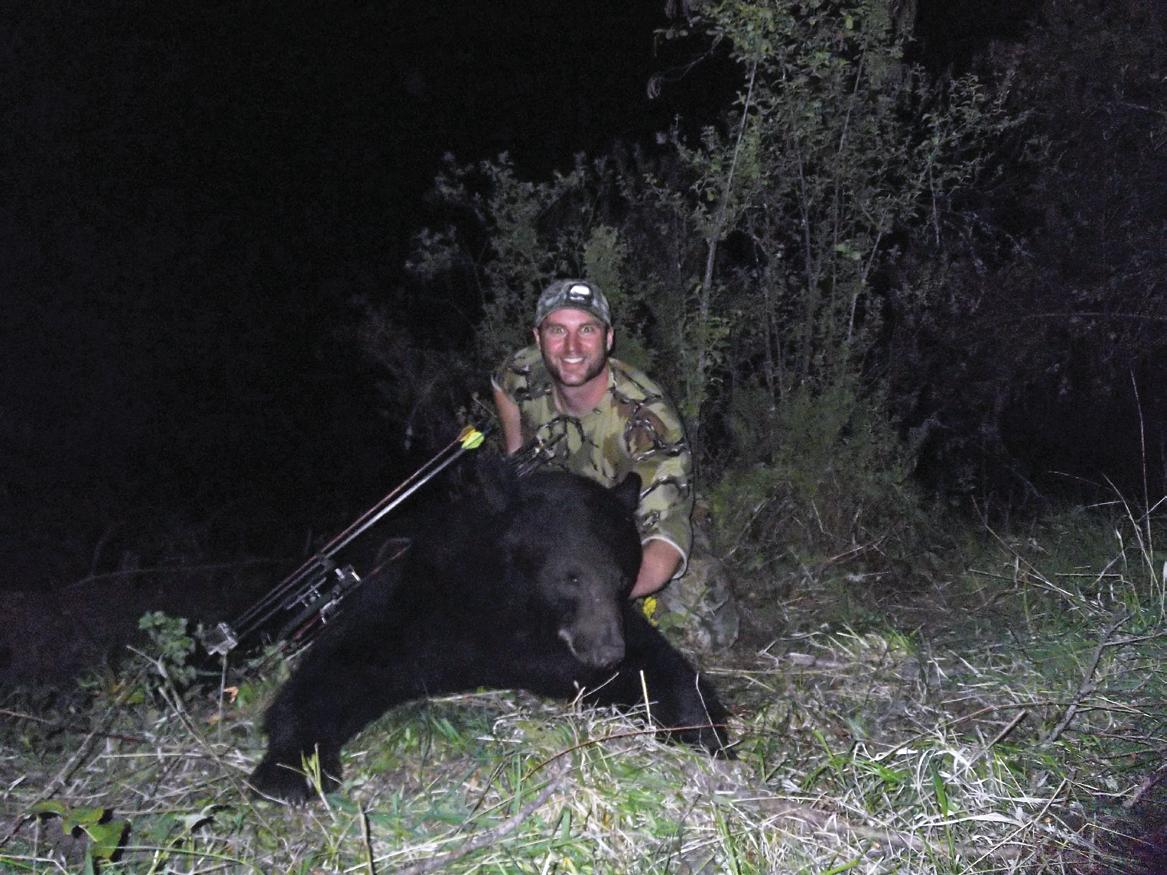
Using a bait container isn’t always necessary. I have seen sites with the bait dumped on the ground that worked just fine. If you are in a situation where your bait is in the backcountry or your bait site is difficult to get to, it may not be worth the effort to pack a bait container. The problem with baiting this way is that rain will deplete your bait and other animals can freely take from it with ease. Baiting this way works best in the summer when the weather is nice and you aren’t as likely to lose
I prefer a container to protect the bait from the weather or other animals. Often, it helps to stop bears from eating all of your bait in one sitting. Having a well-designed bait container will protect your bait and allow bears to get some, but not all, of your bait at once. The best bait containers I have seen were made from 16-gallon steel drums. I prefer these smaller bait containers because the areas I bait are usually difficult to pack bait into. Not only is it difficult to pack your container in at the beginning of the season, but most of the time, you are required to remove it after the season as well. If your bait site is easily accessible, then by all means, use a 55-gallon steel drum.
info@westernhunter.net 69 WESTERN HUNTER
Cutting a hole in the center of your barrel will allow you to use it in a vertical or horizontal position. As competition for food increases bears will frequent the bait more often.
Using trail cameras helps hunters identify and pattern mature bears. After two weeks of trail camera surveillance the author was able to take this mature boar on his third day hunting the bait.

Some steel drums have a removable lid held in place by a ring and bolt. These types of barrels are probably the most convenient for baiting, but you can accomplish the same thing with a regular steel drum by cutting holes however you desire. I like to cut an eight-inch hole on the side of the barrel, usually in the middle or upper third when it is standing vertically. This allows me to use the barrel vertically or horizontally, depending on the bait site. I use a hole saw to put additional holes in the barrel for chain or cable and secure it to a tree with a padlock.
Some states allow the use of plastic barrels, however, I don’t recommend using plastic barrels for baiting. Although they are lighter, they will not last very long, and you will end up replacing them. There are all sorts of designs and theories out there on bait barrels, so do a little research and you’ll find one that works well for your situation.
Stand Placement
Once you have a reliable bait site, it’s time to learn to hunt it. The biggest factor in stand place
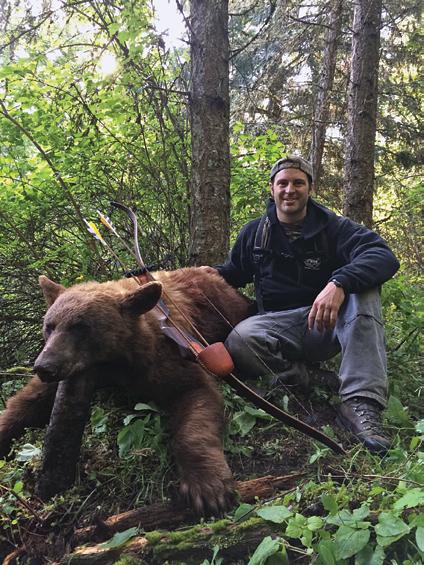
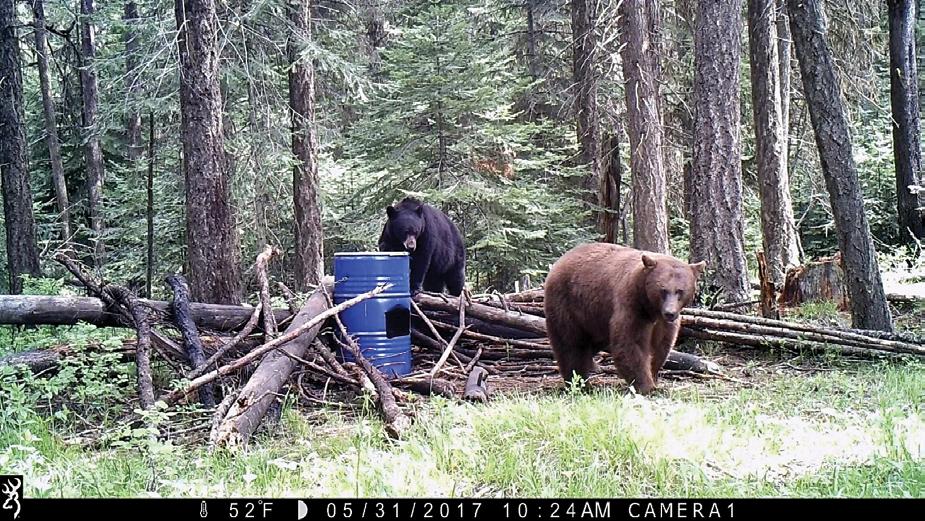
every day, only to sit that bait and not see a single bear. As soon as I left that bait site, the bears would immediately return. My trail camera revealed that they were smelling me while on the stand.
Mature bears will almost certainly circle downwind before committing to your bait. Hopefully, when choosing a bait site, you can pick a spot that has some geographical blockade on the downwind side of the bait. This can be a cliff, bench, or clearing that the bears don’t want to expose themselves in while approaching the bait. Your goal should be to put your stand downwind of the bait but not allow the bears to easily circle downwind of your stand.
When I choose a bait site, I will typically have one or two trees picked out as possible stand locations. They need to have a good amount of cover and allow me to get above eye level with bears that are on the bait. One trick that helps me is to set my bait and my cameras but hold off on setting my stand. Whenever I fill the bait, I study the tracks and pictures off my camera to predict the direction the bears are approaching from. If I have done a good job of selecting a bait site, this should be predictable and help solidify my placement.
Another factor I keep in mind when selecting a tree for my stand is the position of the barrel in relation to my stand. I try to set my stand so that when the bear is feeding from the barrel, it will
provide a broadside shot. The bears’ positioning can be manipulated by the placement of logs and branches, also known as a crib. Creating a crib can help ensure the bear will feed from a broadside position, making it easier to accomplish a wellplaced shot.
Hunting
Before I start hunting a bait site, I need to see a picture of a bear that I’m interested in harvesting. Hunting with archery equipment requires you to put your stand close to the bait, and I have had a lot of bears mess with my stands over the years. This is why I sometimes refrain from hanging a stand until I decide to hunt a specific bait. Having tree stand pegs pre-placed in your tree makes it easy to slip in and hang a stand when you are ready to hunt.
When I decide to hunt a bait site, I try to make as little noise as possible. My approach will be slow and from the opposite direction that most of the bears are entering the bait. Most of the time I will still freshen the bait and check my trail camera before hunting, but I will be very careful and quiet when doing so. I hide any bait containers out of sight and on my exit path so I can easily retrieve

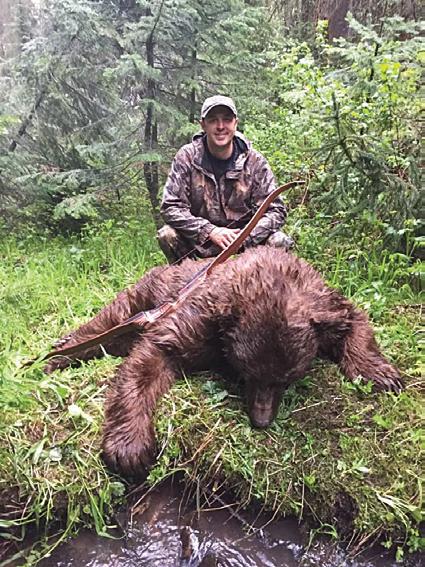
www.westernhunter.net 70 WESTERN HUNTER
Good stand placement prevented this nice boar from smelling me as he approached the barrel from downwind.
A bear’s body mass will be greater in the fall as they prepare for hibernation. This bear tipped the scales around 350 lbs.
Baiting provides ultra close range encounters ideal for archery hunters. This one was taken at less than 20 yards with a recurve bow.
Close range encounters with a big boar like this one will test the nerves of experienced hunters.
Building a “crib” around your bait can help position bears for a broadside shot while they are feeding from the barrel.
Once I am in the stand, I sit still and quiet for as long as possible. I allow myself to stand and possibly pull my bow back once an hour. Bears are extremely quiet when they approach the bait, and sometimes they will suddenly appear out of nowhere. Mature bears will often circle the bait site before entering, so don’t let your movement get you busted by an approaching bear.
Trail Cameras
When I started baiting bears, there were no trail cameras. We had little or no way of knowing how many bears were hitting the bait or how big they were. Now I use trail cameras on every bait I have as a tool to help me know if a mature bear is hitting my bait and help pattern them to plan my hunts. Baiting can be expensive and time-consuming, but using a trail camera will help you save fuel, bait, and time.
Bears are notorious for messing with cameras, so make sure that you use a good lock box and have it securely attached to a tree. Never fill your bait before you check or set your cameras. Getting any bait or attractant scent on the camera will increase the chances that bears will mess with it. If the state you are hunting allows the use of cellular trail cameras on your bait, make sure you mount them high in a tree and angle them down to take your pictures or videos. Most cellular cameras have exter-

nal antennas, so placing them up high, out of their line of vision, will help deter them from breaking any external components.
Remember to position your cameras on the side you enter and exit your bait from, as it allows
Alaska Raw
By Bob Lacher
Alaska truly is a sportsman’s paradise. But (and this is a big but) hunting there is extremely difficult and without the right equipment, experience, or enough money it is at times almost impossible. The country is so vast and virtually roadless compared to the lower 48, that without an airplane, horse string or snowmobile most of the state is out of reach. If you want to better understand this then you need to read “Alaska Raw”. Lacher is a native Alaskan and his book a detailed look into many of his adventures. His writing style is incredibly engaging and easy to read and difficult to put it down! From Unimak Island to the Brooks Range using boats, planes and snowmobiles while hunting caribou, bears and Dall’s sheep, these true stories are captivating.
you quick and easy access to see what has been hitting your bait before climbing into your stand. We have had extremely good luck with the Browning trail cameras. They perform very well during all seasons, including the winter months when temperatures plummet.
Conclusion
I can still remember the first bear that ever came into one of my baits. My brother and I were sitting in a big cedar tree when a nice cinnamoncolored boar materialized out of the ferns. He came walking up the draw, swaying his head back and forth as he approached. My heart was pounding, my knees were shaking, and even though I didn’t get that bear, it was an unforgettable experience. What I remember most about that bear hunt was how much fun I had camping out, hauling bait, setting stands, and the anticipation that a big boar might come into our bait.
Baiting bears was instrumental in my development as a hunter and has taught me a lot of lessons over the years while giving me a ton of good memories. If you are looking for a way to challenge yourself or introduce someone new to hunting, baiting bears may be just what you are looking for. Be sure to check your local state regulations to see if baiting and trail cameras are legal in your area before using them.

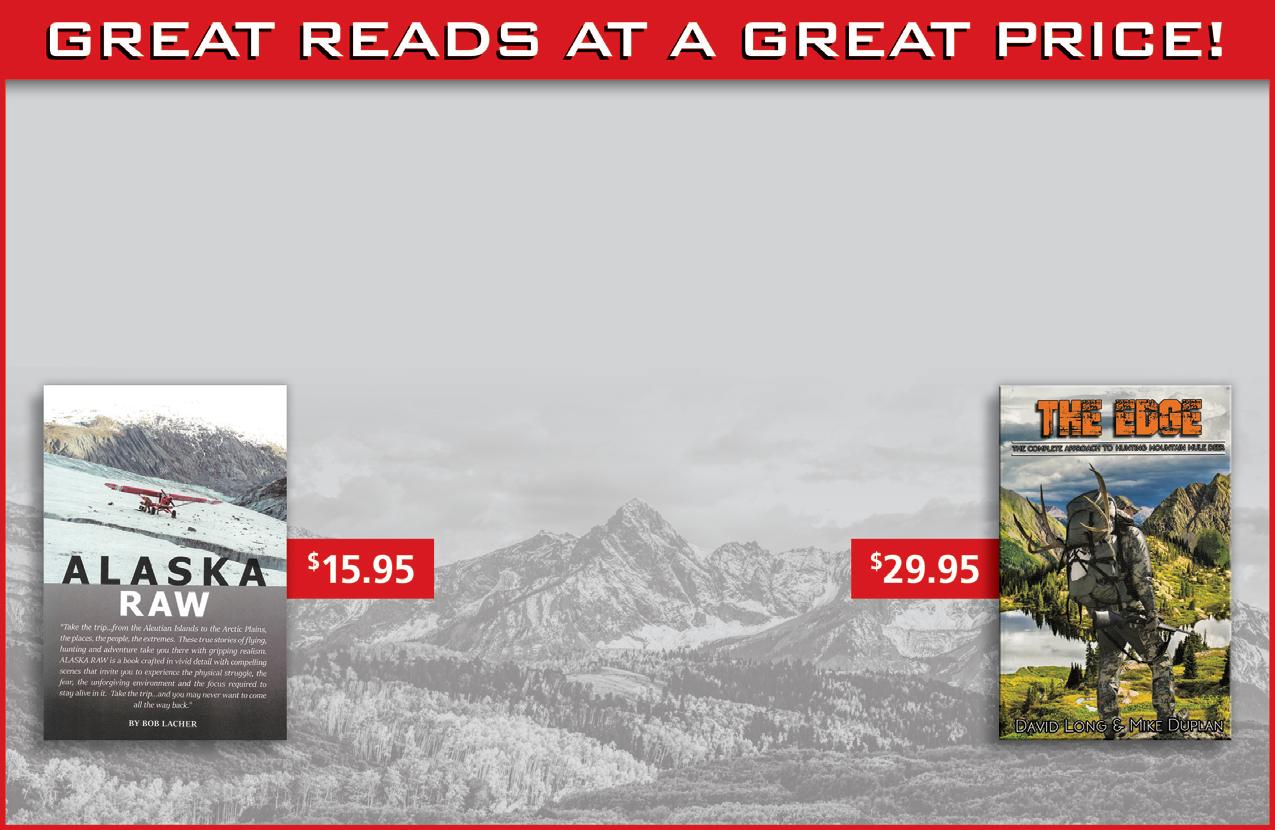
The Edge – The Complete Approach to Hunting Mountain Mule Deer
By David Long & Mike Duplan
The modern mule deer hunter must be willing to outwork, outthink and outhunt both his competition and the highly educated mountain mule deer buck.
In the book “The Edge – The Complete Approach to Hunting Mountain Mule Deer”, authors and mule deer hunting experts David Long and Mike Duplan have collaborated to bring the reader insight into just what it takes to be successful when hunting mature mountain mule deer. “The Edge” will show the steps involved to increase your chance of success and the reader will learn that there is now a year round approach involving, fitness, conditioning and nutrition.
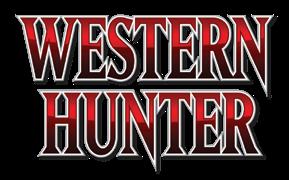
info@westernhunter.net 71 WESTERN HUNTER
order your copies today at www.westernhunter.net
Always hide bait containers out of sight from the bait and on your exit path from your stand.
Great new prize opportunities, a bigger audience, and a new ruleset, will make this film festival one you won't want to miss out on.



Learn More and Submit a Film at:
FILM FESTIVAL IS BACK!
THE
F I L M F E S T . W E S T E R N H U N T E R . N E T



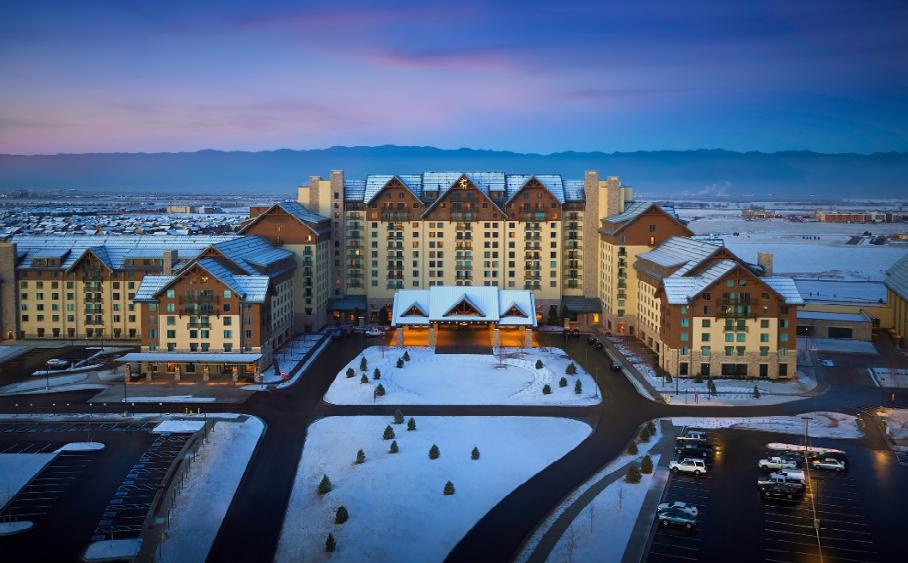




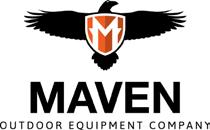






TICK AWARE
VITAL INFORMATION TO STAY SAFE IN TICK COUNTRY
For the western hunter, the word “tick” brings with it a distinct fear that can leave one searching every inch of their body. This parasite has earned its title, with the ability to transmit more than a dozen debilitating bacterial diseases and survive amongst a wide array of climates and habitats. The question is not if you will encounter these
Western Blacklegged Tick
The Western Blacklegged tick primarily inhabits the Pacific Coast states (Northern California, Oregon, and Washington) as well as limited locations of Utah, Nevada, and Arizona. It most notedly is a carrier of Lyme disease, Anaplasmosis, and a form of relapsing fever.

Tick Types
The most prevalent human-biting ticks seen in the West include the Western Blacklegged tick, the Rocky Mountain Wood tick, the Brown Dog tick, and the American Dog tick. These arachnids are characterized by eight legs (six legs during larval stage) and go through four lifecycle phases.
Initial life starts as an egg deposited on the top layer of soil. A tick will experience its first blood meal at the second stage of life, as a larva. The larval stage of a tick will be one of the least visible to humans, as a typical body diameter can be less than 0.5 mm. The first blood meal is typically ingested from small mammals; lizards, rodents, and birds. The initial blood meal allows the tick to molt into a nymph. It is at the nymph stage that a tick is most likely to become infected. A second blood meal causes it again to molt into what is now an adult tick.
Human contact with ticks is most likely to occur during the nymph/adult stage. Although ticks can bite at all stages of life, nymph and adult females are statistically more likely to attach to a human host. A tick’s lifespan lasts anywhere from two to three years.
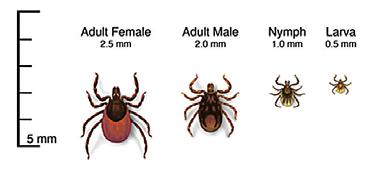
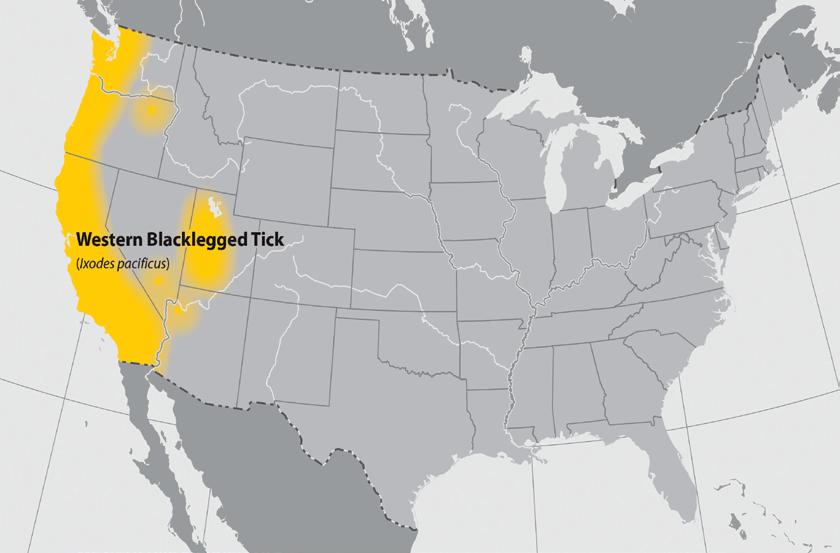
Rocky Mountain Wood Tick


Rocky Mountain Wood tick is known to inhabit the Rocky Mountain states. This tick is often a carrier of Rocky Mountain spotted fever, Colorado tick fever virus, and tularemia.



www.westernhunter.net 74 WESTERN HUNTER
CODY BARNES FIELD EDITOR
The
Distribution
map provided by CDC
FEMALE MALE
Provided by CDC Provided by CDC
Distribution
map provided by CDC Provided by CDC Provided by CDC
FEMALE MALE
Photo: Zachary Phipps
Rocky Mountain Wood Tick
Brown Dog Tick
Preventative Measures
Clothing Treatment
Products containing permethrin 0.5% can be applied to clothing and fabric-constructed equipment. Permethrin is a synthetic chemical. This chemical mimics natural extracts from a flower that contains neurotoxins that naturally repel a long list of bugs. This odorless insecticide incapacitates ticks on contact. It is important to note that a tick crawling on permethrin-treated clothing is likely to cause it to fall off, not instantaneously kill it.



American Dog Tick
Permethrin-impregnated fabrics can be laundered multiple times before the efficacy is reduced to nothing. Most brands conservatively note you can wash your clothing up to six times or wait six weeks before an additional coating will be needed.
When applying, be sure to spray all sides of your equipment and clothing and allow time to air dry. For outfitters, or those lucky enough to spend months hunting through the fall, consider sending your clothing in to be professionally treated. Companies like insectshield.com provide a professional treatment that lasts up to 70 washes!
Permethrin is inexpensive, found at almost any outdoor store, and is harmless to humans. I choose to spray my clothing, pack, boots, and any other fabric-constructed equipment before any trip into the mountains. Permethrin should be applied to fabrics only, not to skin.
Skin Treatment



The emergence of ticks can be seasonal and dependent on weather conditions in each particular state, with some areas of the more temperate West having year-round activity. In most locations, spring marks the arrival of tick season. The months of April, May, and June are regarded as the most active time frame. As spring transitions into summer, the warmer temps will diminish tick sightings. It isn’t until fall’s first rain that we will see tick activity pick up yet again.
Ticks are activated by moisture and humidity. The more arid, dry states see less activity than our coastal neighbors. Ticks are not bound by elevation constraints; they are found at sea level and at elevations just beyond 9000 ft. They make their home amongst tall grasses, brush habitat, aspen, and conifer forests. In fact, the only undesirable habitat for a tick is vegetation that lacks concealment from the direct heat of the sun. It’s fair to say their home range covers just about any location on the map you may spend time in. So, what preventative measures can we take to minimize our unavoidable relationship?
First developed in the 1940s for the US Army, DEET is an insect repellant intended to be applied to the skin. The most effective potency against ticks will contain more than 20% DEET. Unlike permethrin, DEET will discourage insects of all sorts from landing on you. There are multiple variants available including 30% and 100% DEET formulas that last 7-12 hours before reapplication is needed.
Spraying DEET on any ingress points where a tick is likely to first make contact with your body is recommended. I spray around my waistband front and back, around the cuff of each hand, around the ankles where my pant leg ends, and around the collar of my shirt. If using sunscreen in conjunction with DEET, its effectiveness will be reduced. For any question as to the length of efficacy of any products using more natural ingredients, refer to the National Pesticide Information Center (npic.orst.edu) or the Environmental Protection Agencies registered list of insect repellants (epa.gov/insect-repellents/ find-repellent-right-you).
Additional Deterrents
In addition to the products listed above, some mechanical strategy can be utilized when clothing yourself.
• Always tuck your pants into your socks. This creates a natural closure, as ticks are more likely to continue traveling upward instead of attempting to travel down your sock.
info@westernhunter.net 75 WESTERN HUNTER
The Brown Dog tick is found nationwide and is a carrier of Rocky Mountain spotted fever.
Distribution map provided by CDC
FEMALE Provided by CDC Provided by CDC
MALE
The American Dog tick is located in California and limited locations in Eastern Wyoming and Eastern Montana. It is known to transmit Rocky Mountain spotted fever and tularemia.
Distribution map provided by CDC
FEMALE Provided by CDC Provided by CDC
MALE
• Wear gaiters. Again, you’re creating one more barrier of entry.
• Keep your shirt tucked into your pants and underwear. If you have a hoodie, keep it on while in known tick country!
• Last, but definitely not least, perform tick checks. How often is entirely subjective and has a lot to do with how many ticks you’re noticing in the first place. Safe practice suggests at least one thorough tick check morning and evening. Close inspection of the head (behind the ears), hairline, upper legs/ thighs, waistband, groin, armpits, and backs of the knees is recommended.
Keep in mind that we are capable of trekking ticks back into our homes without knowing it. It’s recommended to run clothes in the dryer for 10-15 mins on high heat before washing, as hot water is not likely to kill ticks unless it is over 130 degrees Fahrenheit.
Visual and Physical Signs of Tick Bite
A common perception is that a tick bite will present as a bullseye rash. While this may occur, symptoms can vary greatly depending on the type of bacteria transmitted, among many other factors specific to each person. An expanding rash (that does not itch) three to thirty days after the initial latch can be a very ominous sign. The rash will be warm to the touch and can present as an oval, round, triangular, or irregularly shaped. In addi tion: flu-like symptoms, joint pain, fatigue, gastro intestinal discomfort, and headaches may all pres ent in some form or fashion.



Ticks detect their hosts by sensing body heat, body odor (carbon dioxide), moisture, and vibration. They often lie in wait on the edges of blades of grass or brush in a “questing” position with arms wide open, waiting for their next meal to pass. Some species will quickly attach while others will wander on their host until they find a preferred “bite” site. Depending on the species and stage of life, this process can take anywhere from 10 minutes to two hours. When a site is identified, the tick will insert its feeding tube, cutting into the skin of the host. Some species will secrete a cement-like substance to ensure detachment doesn’t take place while feeding. Ticks also secrete small amounts of saliva with anesthetic properties which numb the area, often leaving the host completely unaware of their presence.

76 WESTERN HUNTER
Provided by CDC
Rocky Mountain Wood Tick
Photo: Sean McCann
Brown Dog Tick
Photo: Bay Area Lyme Foundation
Illustration provided by Bay Area Lyme Foundation


SAVE HUNDREDS ON PREMIUM OPTICS 1 - 8 0 0 - 2 9 1 - 8 0 6 5 | O U T D O O R S M A N S . C O M / U S E D
$1,400 Saved!
Over

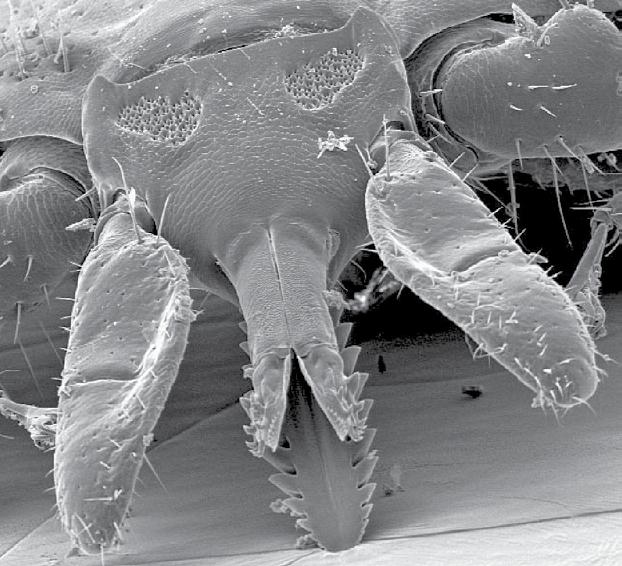
Typical transmission times of harmful pathogens are somewhat controversial as there is much conflicting research. The most important takeaway is that there is no safe period of time for a tick to be attached. Research has shown that bacteria can be found in the salivary glands of a tick, thus transmission can occur very early in the feeding process.
Tick Removal
Some antiquated methods of tick removal can actually cause more harm than good. The use of a flame to get the tick to detach, the use of Vaseline or nail polish remover, and credit card scraping are just a few examples of methods that have been deemed inefficient and potentially harmful.
If you do happen to find a tick has attached itself to you, there are some critical steps to take:
1. Grasp the tick as close to the skin as possible in an attempt to remove the mouth along with the body.
2. Pull firmly, maintaining consistent pressure. Use needle-nose tweezers or a designated tick removal tool.
3. Do NOT twist or yank the tick. This may cause the tick to go into “shock” and regurgitate the entire contents of its midgut (where harmful pathogens are typically stored)
4. If available, wash the site with rubbing alcohol, iodine scrub, or soap
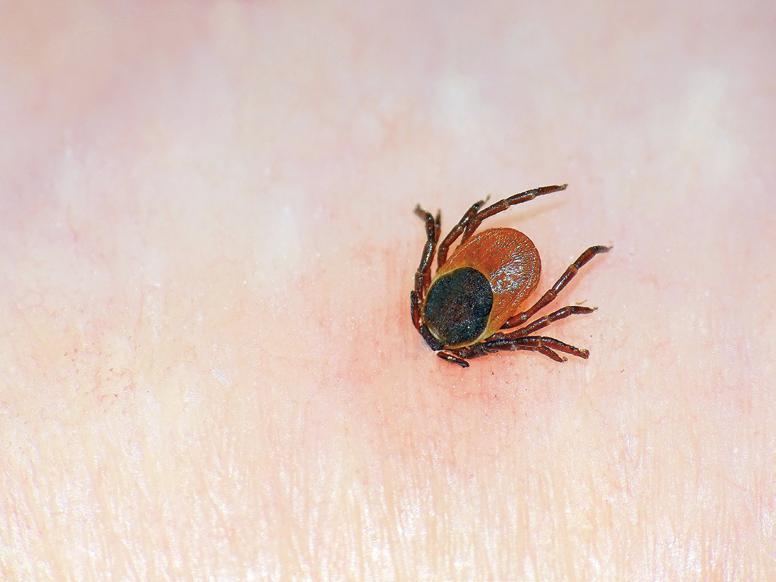
tested for seven to nine different pathogens. Results can be delivered via email in as few as three business days after your tick arrives for analysis!
8. See a doctor as soon as possible. You must be an advocate for yourself! Treatment is typically based on symptoms, history of exposure, and in some cases, blood test results. Most tickborne diseases can be treated with a short course of antibiotics. The CDC recommends taking doxycycline after a tick bite in cases where Lyme transmission may have occurred. Doxycycline is an antireplication antibiotic that can help slow the replication of harmful pathogens while in the bloodstream.
9. Continue to monitor for symptoms 30 days after completion of the antibiotics.
There currently is no reliable diagnostic testing for most diseases caused by tick bites. In fact, research shows that up to 70% of cases of Lyme disease have been missed using diagnostic testing in the early stages of infection. It is

Conclusion
Be prepared and take the preventative steps needed to limit your exposure. Hopefully, this information has armed you with more knowledge to make smart decisions while out in the field. For those interested in learning more about ticks, I recommend checking out the Bay Area Lyme Foundation (bayarealyme.org) and referring to information provided by the Center for Disease Control (cdc.gov/ticks/index.html).

Disclaimer: This article is for informational purposes only and does not constitute medical advice. Seek help from a licensed medical professional if needed.
www.westernhunter.net
Photo: Connecticut Agricultural Experimentation Station
Embedded Tick
Photo: Julian Hodgson
American Dog Tick engorged after blood meal.
Photo: Roger Lupton
Rocky Mountain Wood Tick
Photo: Zachary Phipps

FLESHING IT OUT
SKINNING AND FLESHING A-Z – PART 2 OF 3
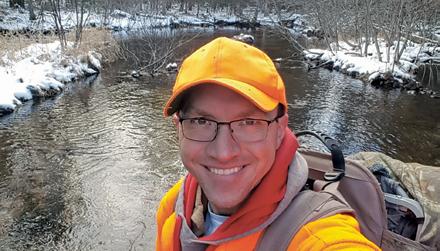
In Part 1 of this series, we discussed the method I like to use when it comes to skinning and caping a big game animal for a shoulder mount while deep in the backcountry. In this article, I’m going to detail the first few steps of actually removing the flesh from the skin in order to preserve the hide with salt.
To flesh a hide for a head mount, there are four technical areas that require a cautious hand and a sharp knife. Those four areas are the eyes, mouth, nose, and ears. There is no particular order in which these areas need to be fleshed, but they all need to be addressed before salt should be applied to the

Easy on the Eyes
In my opinion, the most important aspect of any mount is the animal’s finished eyes. The reason I address this is because badly damaged eyes during the skinning/fleshing process can be difficult to reconstruct for even the best taxidermists. Thin skin combined with fine or no hair makes for a real challenge if flaws need to be corrected. With all that said, fleshing the eyes isn’t all that difficult, it just requires a bit of caution.
There are a couple of different methods used to skin and ultimately mount eyes on big game animals. Some taxidermists prefer to keep the inner eyelid skin attached to the eye, while others do not. I have found that with a quality tan, high-quality glues, and proper skin positioning, the inner lid isn’t necessary for a high-quality finished eye. That said, you may want to ask your taxidermist if they have a preference for keeping the inner lid attached. The inner eyelid will be a milky white, smooth
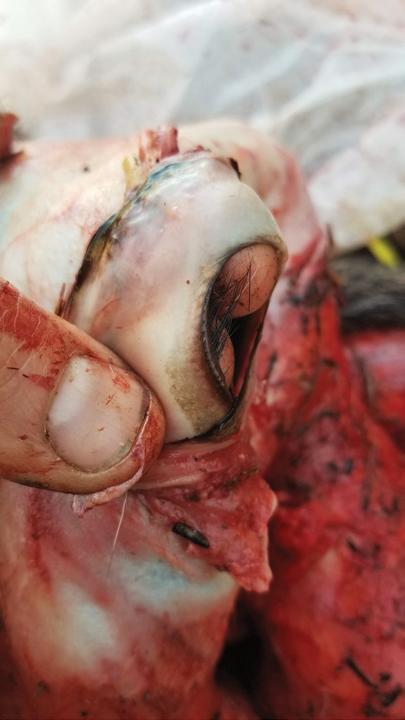
Since I don’t use the inner eyelid during the mounting process, I like to start near the eyelid with a razor-sharp knife and work back and away from the circumference of the eye. If you choose to keep the eyelid, simply start away from the eye and work toward the lid, separating the inner lid from the main skin, and stopping where the two meet. As you can see in the picture, there will be white little rows of fat along the eyelid. I like to make the incision just along the back side of these rows and slowly remove the inner eyelid and flesh away from




www.westernhunter.net 80 WESTERN HUNTER
NICK GEHRING TAXIDERMY EDITOR
mouth.
4
1 2 5 3
Split the Lips
To flesh out the mouth, you’ll have to “split the lips.” Similar to the eyelids, mammals have both inner and outer skin on their lips. For most taxidermy purposes, you will need to keep the inner lip attached, as it will be tucked into a slot in the foam manikin. “Splitting the lips” simply involves making an incision between the inner and outer lip without cutting through the actual skin. To do this, keep your sharp blade parallel to the skin of the face and carefully split the two apart by pulling back with the thumb of your non-cutting hand as


mals is probably the softest of all, which makes it kind of a pain to flesh out. Nostril skin is extremely thin, and combined with the soft tissue around it, it can be challenging to flesh it out. I like to start near the nostril and work my way outward and away from it.

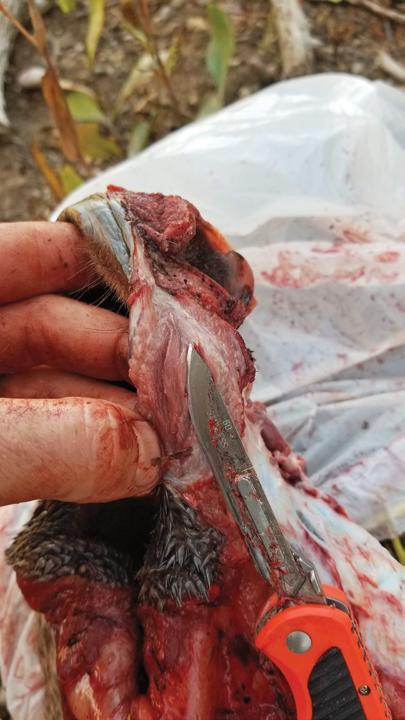
I like to first split the entire circumference of the mouth and then go around a second time to actually remove any remaining flesh from the split lips. You’ll notice at the front of the lower jaw skin on most antlered animals that there’s a dense area

Sometimes it can be helpful to insert a dowel, stick, or finger into the nostril to provide tension to cut against, but be careful not to cut the skin itself. You’ll also notice that there’s a fair amount of flesh in the nose pad itself.
This needs to be removed, but again, carefully, as the nose pad skin is tough, but paper thin.
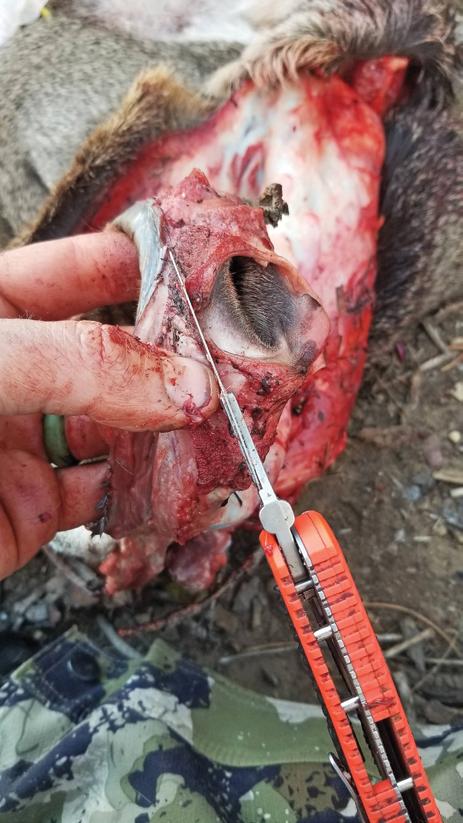
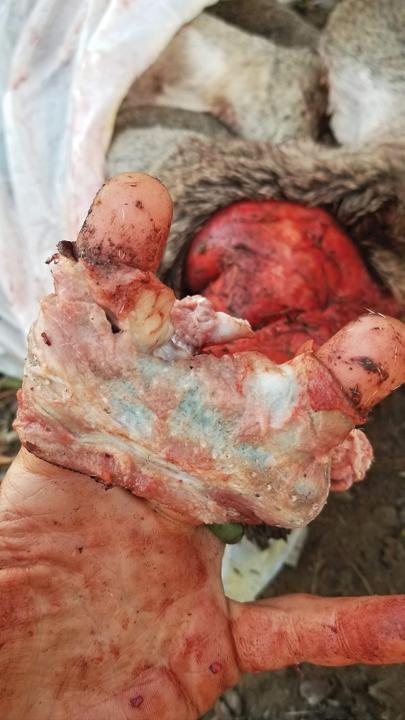
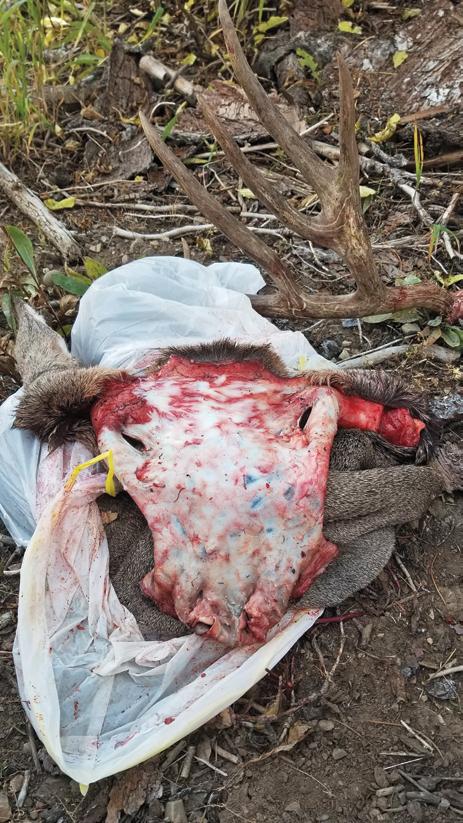
9
11
6 7 8
10
12 13
Turn the Ears
With the eyes, mouth, and nose finished, it’s time to “turn the ears.” Similar to the eyes, mouth, and nose, the ears also have inner and outer skin.
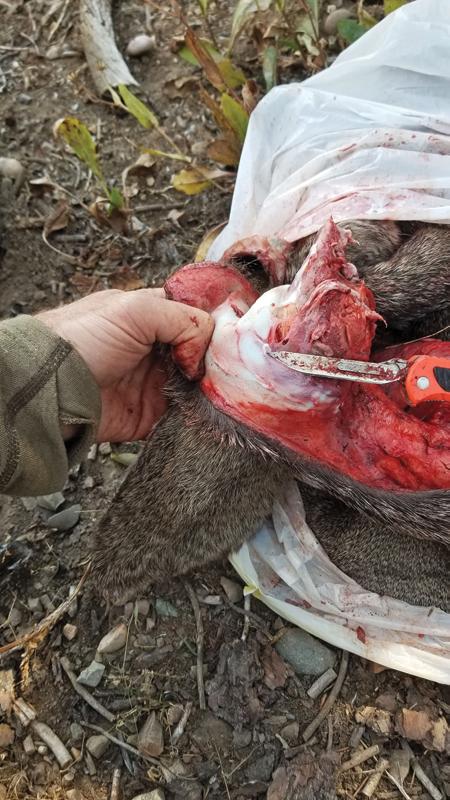
Once you’ve worked past the ear butt, you’ll begin to expose the ear cartilage. This cartilage is firmly connected to the inner ear and loosely connected to the outer ear (the back of the ear with fur on it). Since it’s more loosely connected to the outer/back ear, you’ll notice that once you’ve peeled it back far enough, you’ll often be able to force a thumb in between the cartilage and back skin, separating them from one another.

Some animals, like bears or really old elk or deer, are not so easily turned and will require careful use of a knife tip to slowly peel the skin away from the cartilage.
Generally, at this point, you can begin to slowly work your thumb sideways towards either edge of the ear, being careful not to break through where the inner skin meets the outer skin. As you separate
One way to know that you’re getting close to the edge of the ear is to watch for dimples and serration of the cartilage, as this will mark the transition from inner ear to outer ear. With the ear fully turned, you can remove all the meat and fat connected to the cartilage.

With the ear turned inside out, you’ll want to gently work it apart to the entire circumference of the ear, using extreme caution near the edge of the cartilage, as it is very easy to rupture the ear where the inner skin meets the outer skin. If you do rupture the ear, don’t panic, it happens. Thankfully a torn ear is not that difficult to correct in the mounting process.


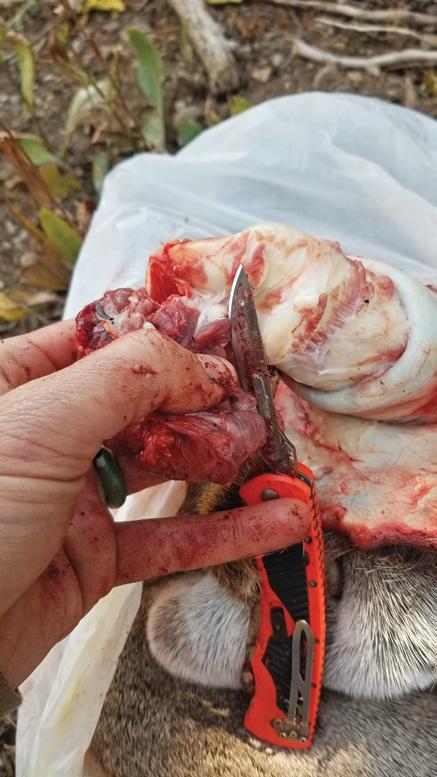
If you’ve made it this far, you’re on the final stretch! Truthfully, the rest of the process will be much easier, and in the next issue, I’ll share some basic concepts regarding final fleshing and salting procedures. Until then, always remember that these principles generally apply among all mammals, so you can practice on anything from rabbits to coyotes this offseason, perfecting the skill for when it will really count next fall.

www.westernhunter.net 14
15 16 17 18 19

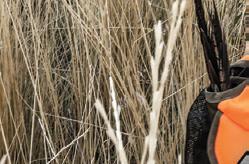













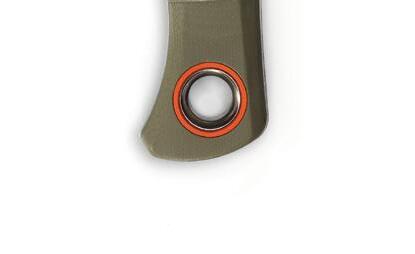
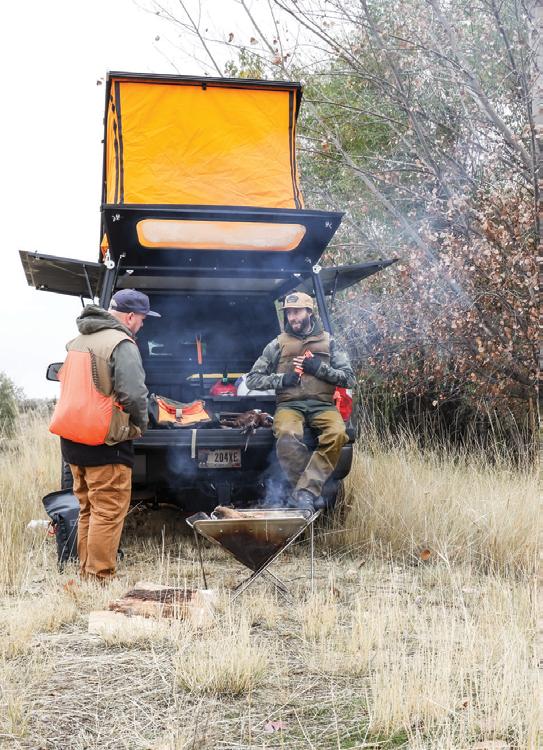
FOR ADVENTURE
THE FIRST SLICE TO THE LAST
the 15500-3 Meatcrafter® in your quiver, you can move from the field to the BBQ pit and the truck bed to the butcher's block without missing a beat. It's a hybrid hunting fixed blade knife that brings a distinctive edge to the table. MEATCRAFTER® 15500-3 GET YOURS LocationMaupin Oregon
BUILT
FROM
With
NORTH AMERICAN SUPER SLAM
MUSKOX
 FRED EICHLER HUNTING EDITOR
FRED EICHLER HUNTING EDITOR
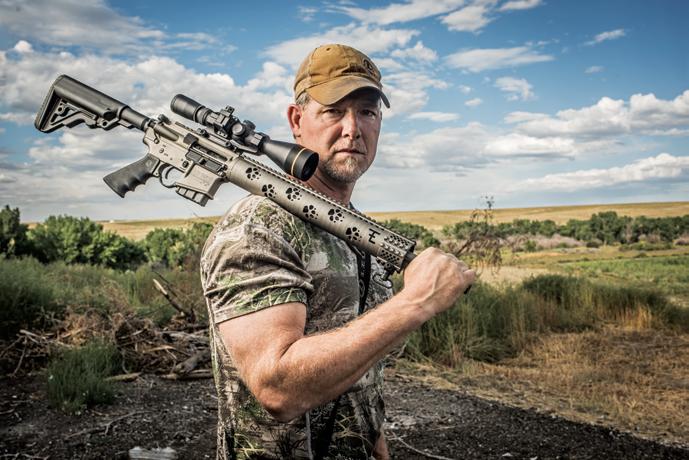
If there is one animal in North America that looks like it is straight out of the pre-historic ice age, it would have to be the muskox. These large bovine animals live in the Arctic and roam the tundra, eating mosses, lichens, and grasses.
THE CAPE BUFFALO OF THE NORTH
during the rut and their ox-like build. They are unique creatures in so many ways and have adapted to survive the harsh weather in the Arctic tundra they call home. Currently, they can be found in the Canadian Arctic, Norway, Alaska, Greenland, and
What They’re Made Of
When you see one, the first thing you notice is the long flowing hair and horns that look similar to those of a Cape buffalo. During the rut, the males will charge at each other and slam their heads together until one gives up and runs off. If you look up “muskox fighting,” the video you can find will impress you. They often run at each other at speeds of up to 30 mph and slam their heads together like sheep do.
Beneath the long hair is a thick coat of a wool-

been used in the Arctic to make clothing, hats, gloves, etc. It’s no wonder the wool-like hair is sought after for clothing, as it allows the muskox to withstand -50-degree temperatures.
Both males and females have horns, and with all the hair on them, they look massive. Their thick coats make them look much larger than they are. The males usually weigh a little more than the females, and although I have heard of bulls weighing up to 900 lb, the ones I have seen weighed between 400 and 600 lb.
They travel in smaller herds that, when attacked, form a defensive circle where the bulls and cows all face out and the calves stay in the middle of the circle. This maneuver works well against wolves but it doesn’t do so well against man. In the early 1900s, populations were dangerously low due to unregulated hunting. Fortunately, restrictions and regulations were put into place, muskox populations rebounded, and they are doing great in the areas where they are currently found.
My First Muskox
About 20 years ago I decided to go try and hunt a muskox with my recurve. I went to Banks Island in Canada. It was like stepping back in time. The small population of people was offset by one of the largest muskox herds at one time. I had decided to go in September because the late Dwight Schuh, who was the editor for Bowhunter Magazine at the time, suggested an early fall hunt. He explained that many people go in the winter when the weather is bad and they can drive up to them and shoot them easily. However, for a spot and stalk hunt, I would probably enjoy the earlier time of year.
84 WESTERN HUNTER North American Super Slam Series
www.westernhunter.net
Dgwildlife
Frank Fichtmüller
North American Super Slam Series
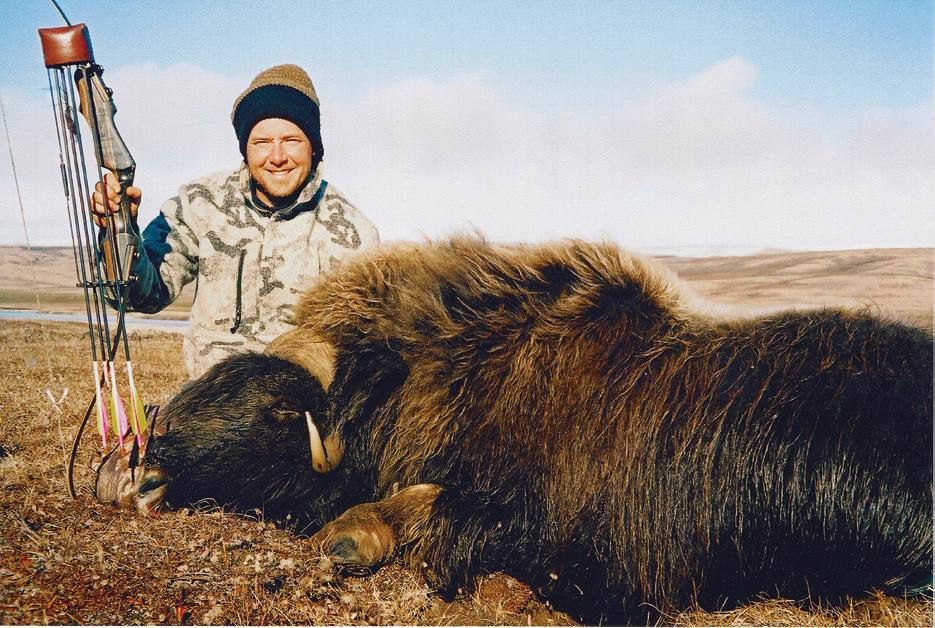
I am glad I listened. The weather was beautiful, and the muskox were out in the tundra. My first stalk ended when I was spotted in the open country and the muskox I was after just took off to join some others not far away. I finally found one feeding close to a small runoff stream that had a low bank I used for cover. I will never forget the excitement I felt as I slowly slipped in closer to the shaggy beast. It was only topped by watching my arrow disappear into the thick hair.
Walking up to my muskox on the tundra was a pretty incredible experience. Just overcoming the challenges of spot-and-stalk-ing an animal in the

terrain to sneak up within bow range was a big part of what made this hunt exceptional to me.
Guides and Gear
On that occasion, I was on a guided hunt with an outfitter that is no longer in business. However, there are several outfitters in Canada and Greenland that friends of mine have gone with and had good experiences. I suggest getting a good outfitter if you are interested in hunting these unique animals. For gear, I advise some good 10x binoculars. I like Leupold or Swarovski 10x42 binoculars. I also suggest a thin carbon arrow with a low-profile broadhead and small feathers or vanes, as it can be very windy and you want something that won’t drift easily in a crosswind.
For a rifle, I can say that most anything would work fine, as the shots are usually from close. A far shot would be 200 yards, and in the wide-open country, it’s not like they will be disappearing in thick brush. I do advise a good bullet no matter what caliber you choose, as the super thick hair and hide can cause a cheap bullet to fall apart. The Hornady Dangerous Game DGX bullet is a solid performing bullet I have used with great results on Cape Buffalo, and it would be my choice on a muskox. In reality, though, there have probably been more muskox taken with a rusty 30-30 with a round-nose lead bullet or a .303 British Enfield with old FMJ bullets than anything else. So, I would take something that you shoot well and not worry too much about caliber.
NORTH AMERICAN SUPER SLAM
pTHE SUPER SLAM IS COMPRISED OF THE FOLLOWING SPECIES:
Whitetail Deer • Mule Deer
Coues Deer • Columbia Blacktail Deer
Sitka Blacktail Deer
Rocky Mountain Elk • Roosevelt Elk
Tule Elk • Alaska Yukon Moose
Canadian Moose • Shiras Moose
Rocky Mountain Bighorn Sheep
Dall Sheep • Stone Sheep
Desert Bighorn Sheep
Barren Ground Caribou
Central Barren Ground Caribou
Woodland Caribou
Quebec Labrador Caribou
Mountain Caribou
Rocky Mountain Goat
Pronghorn Antelope • Mountain Lion
Polar Bear • Brown Bear
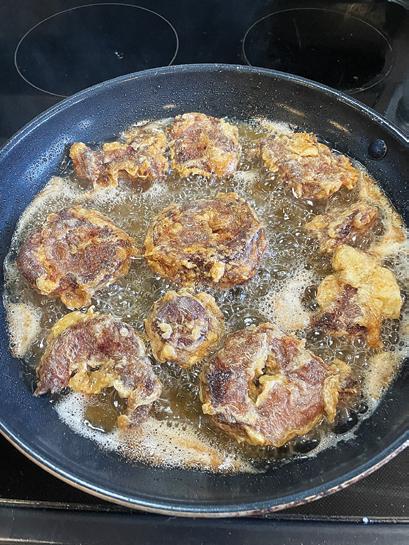
If you’re looking to hunt an animal reminiscent of prehistoric times, in the arctic tundra, where you may also encounter wolves and polar bears, look no further. The muskox should be on your list.

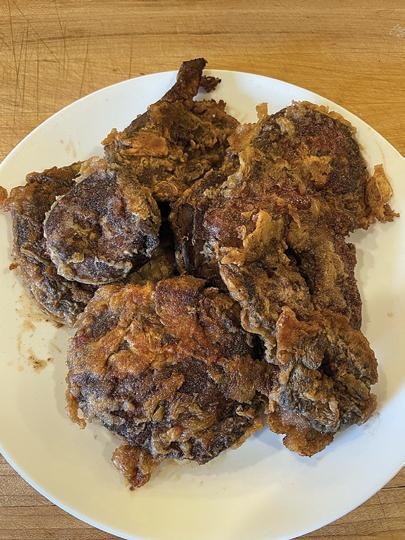
info@westernhunter.net 85 WESTERN HUNTER
I advise that you spend the extra money to get the meat back home. It’s delicious and a great source of protein.
n Although I’m certainly no expert, having only taken two muskoxen on guided hunts, they are amazing, challenging, unique, and tasty animals.
Quality optics are a must for locating muskox in the arctic tundra.
HIKER’S HOOVES
NAVIGATING TERRAIN AND STRENGTHENING FOUNDATIONS
MATT WARD HEALTH & FITNESS EDITOR
If you’ve been following my 2023 articles, we’ve arrived at the last broad topic in my series for Western Hunter Magazine: the foot. As it’s arguably the most under-examined and poorly understood area, this article dives deep into foot health.
For those dealing with hot spots, heel pain, plantar fasciitis, knee pain, toenail issues, or foot cramps, the common response involves getting shoe inserts and resting. However, the reality is that a thorough assessment of the foot, both passively and actively, is crucial. Specific exercises, progressing based on individual needs, are key, especially for those engaged in activities like running, jumping, or backcountry pursuits.
Let’s start with the fundamental understanding that the foot consists of two main parts – the hindfoot and the forefoot. These two parts, the hindfoot (heel and ankle) and forefoot (toes and metatarsals), work together, playing distinct yet interconnected roles in providing stability, shock absorption, and propulsion during activities like hiking.
Hindfoot Function
1. Stability and Shock Absorption
• The hindfoot, comprising the heel and ankle, offers stability on uneven terrain, preventing ankle rolls and sprains during activities like hiking on rocky surfaces.
• The robust structure of the heel acts as a shock absorber, mitigating impact forces during descents and each step.
2. Weight Distribution
• The hindfoot is responsible for distributing body weight evenly, and it’s crucial for maintaining balance and preventing excessive pressure on specific areas of the foot.
3. Ankle Mobility
• It also enables dorsiflexion and plantarflexion, allowing adaptation to changes in terrain, vital for foot positioning on inclines and declines.
Forefoot Function
1. Propulsion
• The forefoot, especially the toes and metatarsals, plays a key role in pushing off the ground during each step, providing necessary propulsion during activities like ascending slopes.
2. Toe Grip and Balance
• Toes contribute to gripping the ground, enhancing balance on uneven surfaces and working in harmony with the hindfoot to prevent slips/falls.
3. Terrain Adaptation
• The forefoot is responsible for adapting to changes in the hiking surface, providing a solid platform on flat terrain and a pronounced flexion on inclines for gripping and ascending.
4. Sensitivity and Feedback
• The forefoot, rich in nerve endings, provides sensory feedback crucial for detecting variations in terrain and making real-time adjustments to foot placement.
In summary, both the hindfoot and forefoot collaborate to offer a stable, adaptive, and propulsive foundation during hiking. The hindfoot excels in stability and shock absorption, while the forefoot contributes to propulsion, balance, and adaptability on diverse terrains.
www.westernhunter.net 86 WESTERN HUNTER
HEALTH & FITNESS
www.lathropandsons.com
HEALTH & FITNESS
Foot Rolling
Now, let’s address a common issue – rolling to the outside of the foot throughout the propulsion and toe-off phase. A simple test-and-exercise routine can help address this concern.
Test: Calf Raise
• Perform a calf raise with hands on a wall or surface for stability.
• Do 10-15 calf raises with straight legs.
• Follow with 10-15 calf raises with bent knees.
• Transition to 5-10 single-leg calf raises with a straight and bent knee.
Exercise: Calf Raise Correction
• Take a video of your calf raises to check if your weight stays over the big toe joint.
• If rolling to the outside (over the 4th or 5th toe), perform 60-100 calf raises daily with a ball squeezed between heels and knees bent or straight.
• Progress to single-leg calf raises, ensuring weight remains over the big toe knuckle.
Tip: Strengthening improves biomechanics, reducing hotspots and blisters during trips.





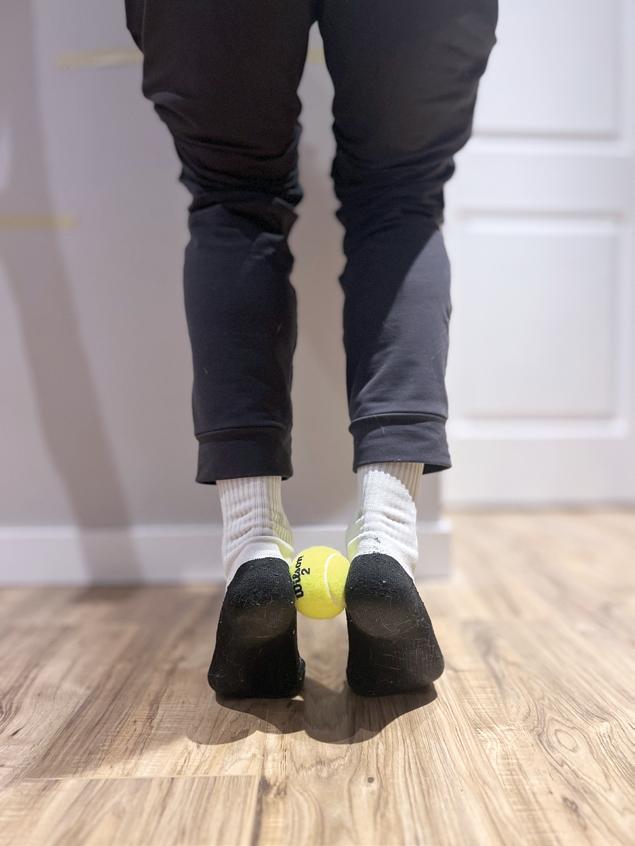
Tibialis Posterior Muscle
The tibialis posterior muscle, often overlooked, plays a vital role in foot and ankle stabilization during the gait cycle. Strengthening this muscle is crucial for overall foot biomechanics.
Conveniently, the exercise to activate and strengthen the tibialis posterior muscle is the same as above. If you find yourself wanting to work on tibialis posterior strengthening or you have pain on the inside of the shin/behind the medial malleolus, perform the calf raise correction exercise as described above.
Foot Control
Controlling the foot involves simple yet effective drills.
1. Big Toe/Little Toe Control
• Lift little toes while keeping big toes down and vice versa.
• Cross legs and use fingers between toes to flex and extend ankles, enhancing sensory input.
2. Toe Threading
• Flex and extend ankles using fingers between toes, improving sensory and motor input.
3. Toe Splay Exercise
• Sit with bare feet, keeping big toes down, lift little toes and vice versa.
info@westernhunter.net 87 WESTERN HUNTER
This is the Double Calf Raise Test. On the right (1) is correct with the push off being over the big toe joint (MTP). On the left (2) is incorrect and it is over the pinky toe.
CORRECT INCORRECT CORRECT INCORRECT 1 2 3 4
This is the same Calf Raise Test but with just a single leg option. Again notice the right photo (3) with the weight staying over the 1st MTP and the left photo (4) being over the pinky toe.
This is the correction if you cannot seem to keep yourself from rolling to the outside of your foot during a calf raise. Its also a great exercise to throw into your daily routine. Squeeze that ball and control the heel from the floor to the top and back to the floor.
HEALTH & FITNESS
Foot Mobility
Wear toe spacers at home (barefoot) for 10 minutes to three hours, gradually increasing. This improves forefoot splaying during push-off.
Foam Rolling
Roll your calves, shins, and quads regularly using a foam roller or trigger point ball.
1. Gastroc and Soleus
• Roll from ankles to knees, adjusting pressure for 1-2 minutes.
2. Anterior Tibialis (Shins)
• Roll along shins, focusing on tender spots for 1-2 minutes.
3. Quads
• Roll from knees to hips, targeting inner and outer quads for 1-2 minutes.
Tip: Consistent foam rolling enhances flexibility and reduces muscle tightness.
Toe Spacer Recommendation
Purchase toe spacers online and wear them around the house (without shoes) to enhance forefoot flexibility and splay.
Hiker’s Hooves
Prioritize foot health for optimal performance and comfort during activities like hiking. Simple tests, exercises, and self-care routines can significantly improve foot biomechanics, reduce discomfort, and enhance overall stability. Your feet are your foundation – treat them well.
While the facets of foot health are indeed numerous, let’s delve deeper into the intricacies. Often overshadowed in the realm of overall well-being, our feet silently bear the weight of our daily activities. This article serves as a gateway to understanding and rectifying the often-neglected issues related to foot health. Consider this an invitation to explore and address the intricacies of foot care for the robust foundation they provide.
Imagine returning triumphantly from a challenging sheep hunt only to find yourself compromised during the subsequent elk hunt due to debilitating blisters. It’s a scenario that underscores the importance of prioritizing foot health. So, let’s not only scratch the surface but also unravel the layers of knowledge that contribute to resilient and reliable feet.
In our journey, we’ve discussed the biomechanics of the foot, the interconnected roles of the hindfoot and forefoot, and the significance of muscles like the tibialis posterior. These aspects form the bedrock of a stable and propulsive gait during activities like hiking. The test-and-exercise routines provided serve as practical tools for self-assessment and improvement, ensuring your feet are up to the challenges presented by varied terrains.
Yet, our exploration doesn’t end here. The top problem identified – rolling to the outside of the foot – introduces a targeted test-and-exercise regimen. The emphasis on maintaining alignment over the big toe joint is pivotal for preventing issues during the propulsion and toe-off phases. Committing to the recommended exercises can significantly enhance biomechanics and reduce discomfort during prolonged activities.
We’ve also touched on the often-overlooked tibialis posterior muscle and its critical role in foot stabilization. Recognizing its significance and incorporating exercises to strengthen it can lead to improved overall foot and ankle function.
Transitioning to the control of the foot, we’ve introduced simple drills that gauge and enhance your ability to manipulate your toes – a seemingly mun-
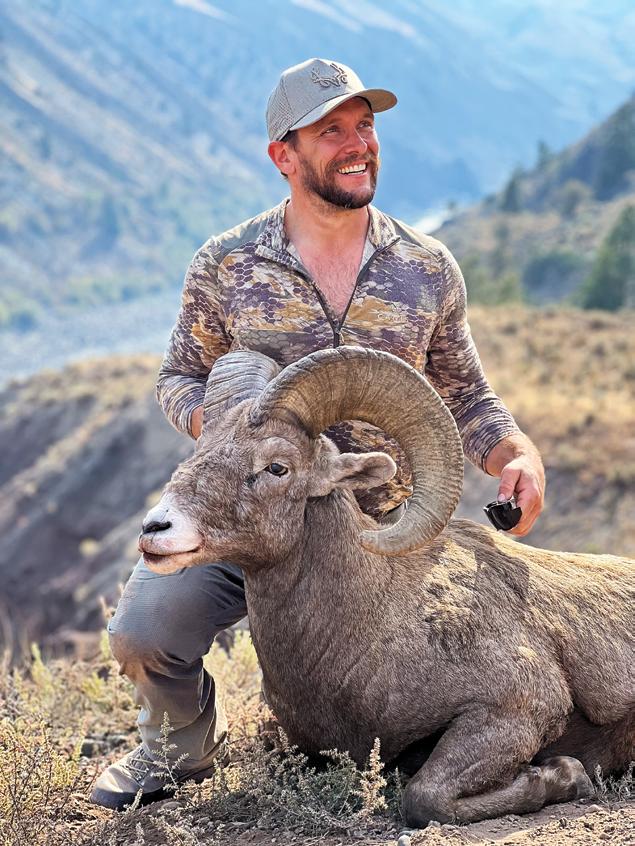
dane yet crucial aspect of intrinsic foot muscle control. The exercises provided serve as practical steps towards achieving better mind-muscle coordination, a foundational element for activities like lifting, jumping, hiking, and running.
This is a reminder, as consistent as the rhythmic stride during a hike, to foam roll regularly. The calves, shins, and quads demand attention, and the provided techniques offer a roadmap for effective self-care. This routine, though often reiterated, is a cornerstone for improving flexibility, reducing muscle tightness, and enhancing overall lower-leg health.
For those ready to take an extra step, the recommendation to wear toe spacers adds a layer of subtlety. A simple act like allowing your toes to splay naturally contributes to improved forefoot flexibility and facilitates a smoother push-off during walking or hiking. An investment of time in this seemingly small practice can yield significant benefits in the long run.
Conclusion
As we unravel the complexities of foot health, it becomes evident that there’s always more to explore. While we’ve covered substantial terrain, there are myriad nuances waiting to be addressed in future discussions. The message is clear – our feet are foundational to our adventures, and overlooking their wellbeing can have cascading effects. So, let this be a call to action. Review, engage, and get to work on your feet. Ensure they are not just supporting you but thriving, ready for the challenges that lie ahead. After all, a journey of a thousand miles begins with a solid step – make sure yours is up to the task.

www.westernhunter.net 88 WESTERN HUNTER
Don’t let the hunt of a lifetime be compromised by not prioritizing foot health.

NEW YEAR NEW YOU
MAKE THE CHANGES, JUST NOT ALL AT ONCE
Every January as the new year rolls around, we see the mantra: “New year, new you.” I don’t love this mantra. It often portrays a fresh start where you will magically, suddenly have the skills, habits, and willpower to begin taking care of your health when one day before, you couldn’t seem to make those changes. It is as if the simple switch of the calendar year was the key. This is not realistic nor sustainable, which is why most New Year’s resolutions fizzle out by the end of January.
It is easy to start with gusto thanks to the excitement of the magic of January 1st, but when that wears off, our habits, discipline, and mindset don’t actually change. This is an all-or-nothing approach. It’s the idea that we have to make a monumental
There are four main keys to health and each one is vital in its own way. Instead of changing everything at once, you systematically change just one thing at a time in each of those areas over the course of the new year. This can provide an incredible benefit to your overall health while also being manageable, realistic, and sustainable. It is a slow, methodical change of your habits and mindset, and these are the kinds of changes that last long after January ends. These changes can stick with you for the rest of your life so that next January you are not relying on non-existent magic for the outcome of your health. Let’s look at those four keys and what they entail.
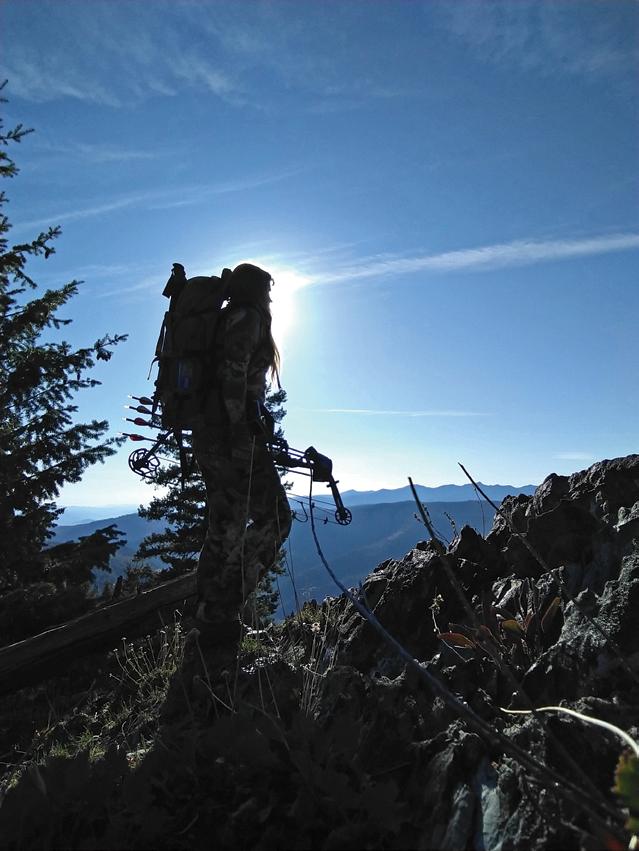
Everyone knows that fitness is an important piece of overall health. The fact that exercise is good for you is not a surprise to anyone. We know that exercise increases your life expectancy, helps regulate blood sugar and blood pressure, decreases overall body fat, and strengthens bones. These all lead to substantially reduced risk of osteoarthritis, hip fractures, coronary heart disease, stroke, and some forms of cancer. Fitness can also improve mood, confidence, sleep, energy, and stress levels.
With so many potential positive impacts on our overall health, it is no surprise that your fitness level is one of the four keys to health. When it comes to making changes to your fitness level, these changes will look different for everyone. It could simply be that you need to increase your overall movement throughout the day. You could try to reach a specific step goal or add in a 30-min ute daily walk to your routine.
Many people who make New Year’s resolutions take it to an extreme level. They may vow to exer cise every day for hours or try tackling a program like the 75 Hard Challenge. While the intention is good, the result is often subpar simply due to the lack of ability to follow through and an unrealistic amount of change in a short time. You did not build the habits and lifestyle you currently have over night, and you won’t be able to completely change
Imagine the difference in the impact on your overall health between adding a 30-minute walk into your daily routine and being able to sustain
LINDSAY PERSICO HEALTH & FITNESS EDITOR

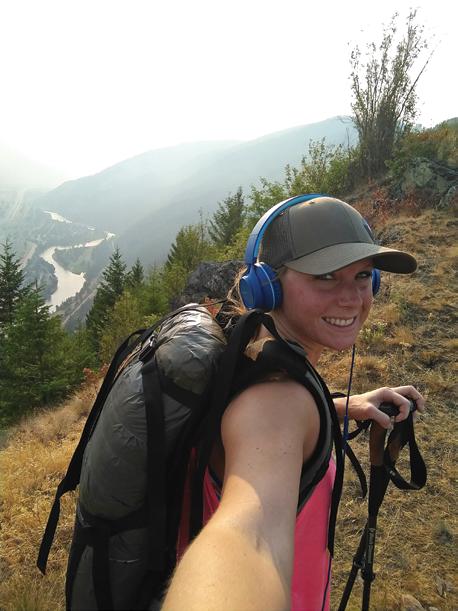
working out again for the rest of the year. Not only
www.westernhunter.net 90 WESTERN HUNTER
HEALTH & FITNESS
Change takes time. You don’t become fluent in anything overnight, and when you are revamping your entire lifestyle for the purpose of health, it is better to take it one step at a time.
Rucking outside gives double rewards. It not only increases fitness but also allows you time in the outdoors which boosts mental health.
Adding weight training into your week one day at a time can help build it as a habit and maintain it as opposed to adding in five sessions at once and quitting because your lifestyle has not shifted to support it.
HEALTH

Making one change in the area of fitness at the beginning of the year that you know you can stick with and maintain, even during crazy weeks or months, will lead to great results at the end of the year. Here is a list of possible changes you could choose from, depending on your current level of fitness and what is realistic for you. This list is in no way exhaustive, so feel free to get creative and come up with a change on your own that you would enjoy.
• Increase your daily step or movement goal.
• Join a sports league.
• Join a fitness class.
• Plan a physical event for the year that you will be motivated to train for.
• Bike to work.
• Add in a strength training workout twice a week.
• Start taking your dog for daily walks.
• Walk around the block over your lunch hour.
• Plan a 30-minute outside game with your kids after dinner every night.
• When you run errands, park as far away from the door as possible.
It does not have to be a huge change to see health benefits, so pick something you know you can complete. Once that feels like a habit for you and it is easy to accomplish, then pick something else to implement or add another day to your work outs each week. Make your changes small, calcu lated, and sustainable.
Nutrition
The second key to health is nutrition. What we eat impacts all aspects of our health down to a mi croscopic level. It impacts the progress we see in the gym, our digestion, our energy, our bones and organs, our minds, and everything in between. It can be difficult to know how to best support our bodies nutritionally with all the noise on the inter net telling us what to eat and what not to eat.

A few things are undeniable: You need to eat enough food to support a strong metabolism and consistent energy levels; your fuel needs to be nutrient-dense to provide you with the vitamins and minerals you need to function well; you need protein, carbohydrates and healthy fats to support all of your bodily functions; and you need adequate water to stay hydrated and keep your skin, lymphatic system, and digestion functioning well.
There are a few simple things you can do to dramatically and positively impact your health when it comes to your nutrition. This list is not exhaustive and you can make many different changes to your diet, but whatever you choose, make it

something you can stick with and be consistent on, then slowly build on that change over time.
• Eat breakfast, lunch, and dinner.
• Have protein, carbohydrates, and healthy fats with each meal.
• Eat 25 grams (women) or 35 grams (men) of fiber daily.
• Drink 80-100 oz of water daily.
• Switch out your canola or vegetable oils for olive or avocado oil.
• Track your food on an app like MyFitnessPal to better understand your intake.
• Plan your meals ahead either for the day or for the week.
• Limit your intake of processed or fast food.
• Try a new fruit or vegetable each week.
• Reduce or cease your alcohol consumption.


Reducing processed foods and making more things at home will help to ensure you are eating nutrient-dense foods full of the vitamins and minerals your body needs. It also cuts down on ingredients that are detrimental to your overall health.
info@westernhunter.net 91 WESTERN HUNTER
Finding activities you enjoy can make adding in exercise easier and make it enjoyable. It also helps to fill your cup, reduce stress, and refresh your mind.
Eating breakfast, lunch, and dinner helps keep energy levels steady, metabolism strong, and minimizes cravings and binge eating habits.
Incorporating protein, carbs, and healthy fats daily into each meal will help support a strong metabolism.
Protein is an important part of each meal. It provides needed building blocks for muscle, helps to balance blood sugar levels, increases overall metabolism, and much more.
HEALTH & FITNESS

Lifestyle
Your lifestyle has a huge impact on your overall health and is the third key to health. The simple habits you have and the way you go about your day can make or break your health. It is difficult to create healthy habits in a chaotic environment. That is not to say that you have to be regimented and not allow for spontaneity, but having a bit of organization and routine in your life can go a long way in helping you establish the habits needed to support a healthy life. If you find that your sleep is horrible, interrupted, and sporadic, you are always rushing and regularly have to abandon plans for a healthy homemade meal or a workout. If you are stressed to the max and struggling to decompress and relax, then you may need to make some small, calculated changes to your lifestyle to improve your health.
Simple things like having a morning and evening routine, getting good sleep, managing your stress, or learning how to say “no” and create space can all make a huge difference in your health. Here is a non-exhaustive list of ideas to start making progress on improving your lifestyle for your overall health. Assessing the things that make it difficult for you to do what you want for your health will help you know where to focus on implementing change.
• Get 7-8 hours of good sleep daily.
• Identify stressors and ways to mitigate them.
• Say no to added events or expectations when your schedule is packed.
• Spend less time watching television or scrolling on your phone.
• Create a morning routine that sets you up for success. It could include:
• Drinking 20 oz of water before you eat or drink anything else.
• Journaling for a few minutes about your goals for the day and the year.
• Getting a little movement in to get your mind and body going.
• Taking your vitamins.
• Create an evening routine that sets you up for success. It could include:
• Giving yourself an hour break from screen time before bed.
• Journaling about your day to brain dump for better sleep.
• Reading a book.
• Setting out your workout clothes for the next morning.
• Putting your water by your bed for the next morning.
• Planning your food for the next day.

Mental Health
The last key to overall health, but probably the most important one, is your mental health. When you are struggling with mental health, it will impact your physical health. All the systems of the body are intertwined, and each one is impacted by the health of the others. Mental health can feel very abstract, and there are so many facets of it that it can be difficult to quantify and identify how we are doing sometimes. We may notice that we are feeling sad, introverted, or overwhelmed, or that we are feeling very scattered and high-energy.
There are many different ways we struggle with our mental health, but there are some basic things that we can do to support our minds. We need to always be willing to get professional help if our efforts are not sufficient. Often, when I am working with clients, it becomes apparent that all of the things we are focusing on physically would be quite easy if their mental health was good.
When your mental health is suffering, it becomes almost impossible to implement fitness, nutrition, and lifestyle changes. When your mind is well, these things become so much easier. Some ideas you can try this year include:
• Find the things you enjoy doing that fill your cup and make time for those regularly.
• Start a regular meditation practice.
• Get outside and spend time in the fresh air and enjoy nature.
• Journal.
• Connect with people around you who positively impact your mindset.
• Get sufficient rest.
• Get physical activity every day.
• Practice positive self-talk.

www.westernhunter.net 92 WESTERN HUNTER
Time spent in activities with family and those who bring you joy will increase your fitness and benefit your mental health. Not only will you benefit, but your friends and family, as well.
Working outside in the dirt helps ground us and gives us fresh air and exercise. All three of these positively impact mental health.
Outside activities with your kids is incredibly good exercise. You will experience a boost in your mental health, and the memories made are priceless.
HEALTH & FITNESS

• Assess the things you read, listen to, and watch and choose things that positively impact you.
• Seek professional help for lingering issues.
Your health is the catalyst to an incredible life. We can enjoy so much when we are strong and well. Change takes time, and trying to rush it can end up keeping us stuck in old patterns and habits. Approaching it with a lifetime in mind will bring you
lasting success and keep you from ending up in the same place next December. Changing one thing at a time in each of these areas can help you focus and keep you progressing. When the changes you have made begin to feel natural and you don’t have to think so much about making them happen, then you are ready to introduce another change. May your new year be full of health, vitality, and progress in your goals.


Mindfulness practices such as meditation help us to regulate our nervous systems and decrease overall stress.
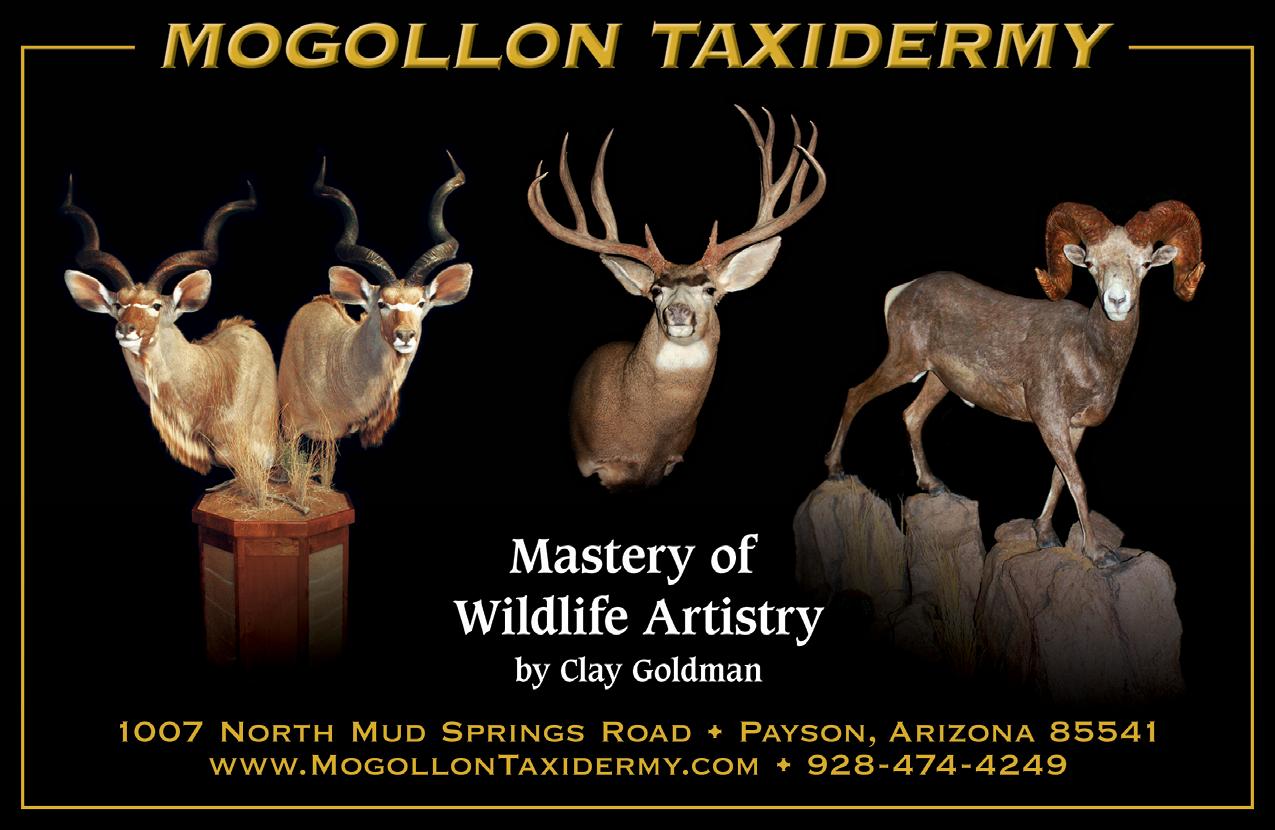
info@westernhunter.net 93 WESTERN HUNTER
Finding things that bring you joy and fill your cup will help support mental health. Time away from the hustle and bustle of daily life can be a great reset.
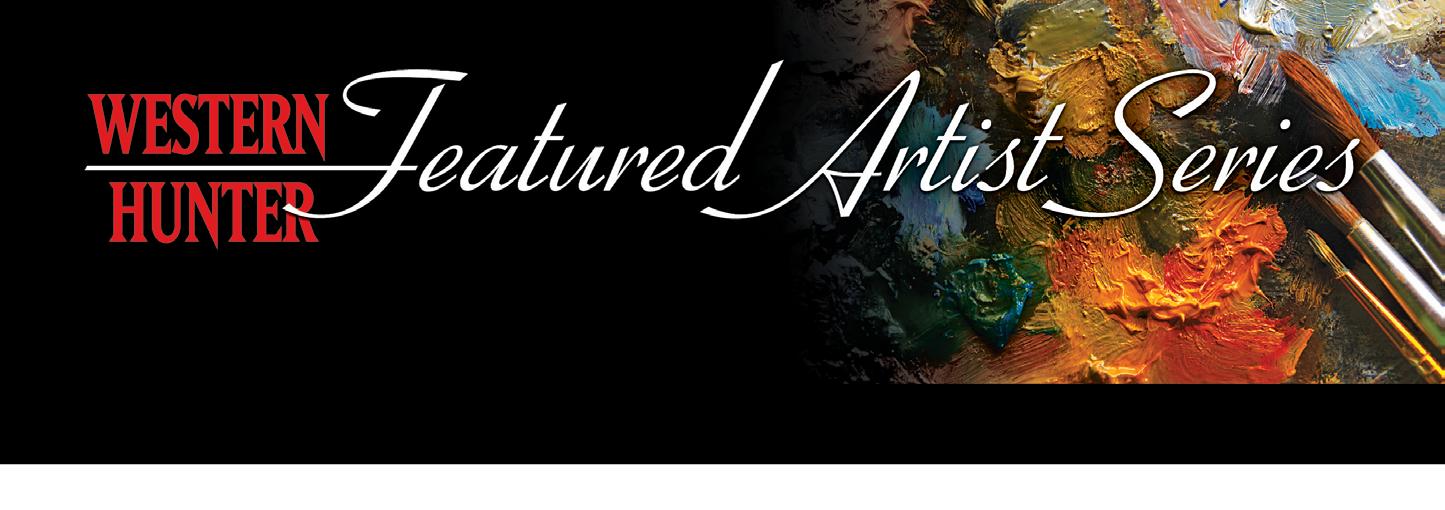 PEDRAM PARVIN FIELD EDITOR
PEDRAM PARVIN FIELD EDITOR
Kelsey Rae Morris
Wseries which aims to appreciate the talents of some incredible Western artists! We are excited to announce that our second artist in the Western Hunter Featured Artist Series is Kelsey Rae Morris. We had the opportunity to ask Kelsey some questions regarding her background, inspiration, and favorite hunting memories. We hope you like getting to know more about Kelsey and her amazing artwork!
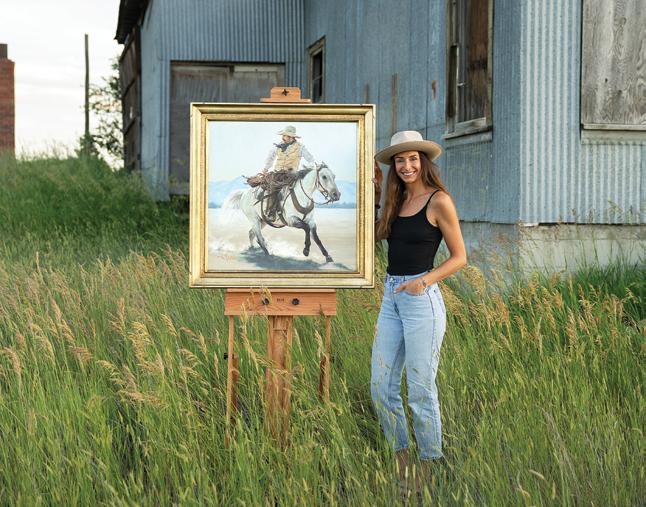
WHM: Give a bit of info about you – where you grew up, where you live now, and how you got started with your art.
KELSEY: I was born and raised in Pittsburgh, Pennsylvania by a family fueled by muscle cars and rock ‘n’ roll. I was a bit of an adventurous odd-duck; more interested in horses, hiking, and being outside. Eventually, I made my way out west in search of more of those experiences. I slowly but surely grew disillusioned with my corporate career and the scales began to tip in favor of my true passion; drawing and painting.
Beginning in 2018, I formed a legitimate business selling my original art and taking commissions. In August of 2021, I went all-in as a full-time artist. Today I call Three Forks, Montana home where I live with my husband and work out of my public studio and gallery.
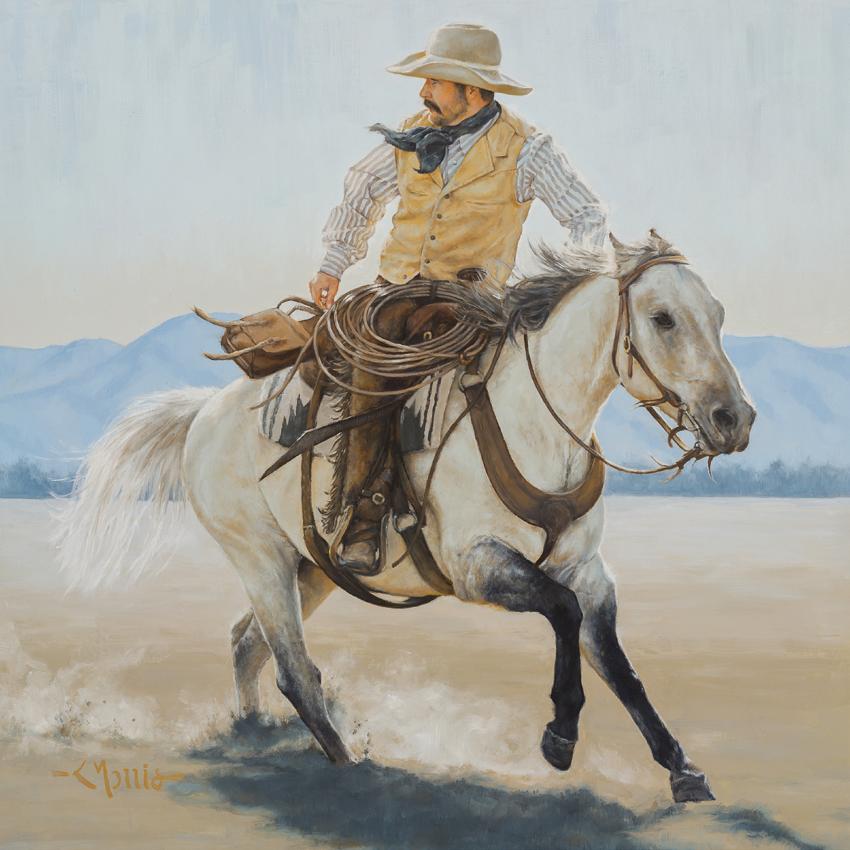
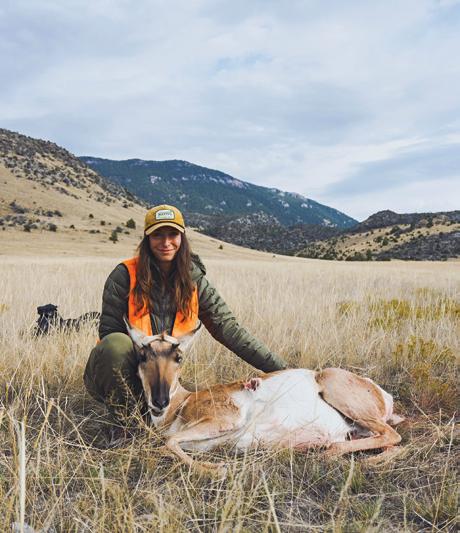
WHM: How has hunting influenced your artwork?
KELSEY: The short answer is I love the outdoors, and hunting is a primary way I access and enjoy wild places. While the act of making art is done in my studio, all my best ideas and inspiration are found outside. I am intensely influenced by all the factors you face while hunting. The elements, land, wildlife, people, physical exertion, emotions: it all adds up to a formative experience that I find inspiring and refreshing.
www.westernhunter.net 94 WESTERN HUNTER
Make Haste

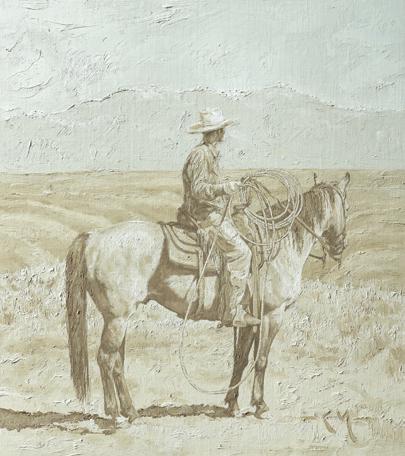
Sweetgrass County
WHM: What makes your art unique?
KELSEY: I think the evolution of my artwork is quite unique to my personal story. I began as a portrait illustrator and am now tackling large composition paintings. As a self-taught artist and generally curious person, my works symbolize my ongoing growth and skill development. Hopefully evident is a deep love for nature, from which all my inspiration is drawn. In the end, my works will serve as a unique storyline, outlining each chapter’s influences and interests.
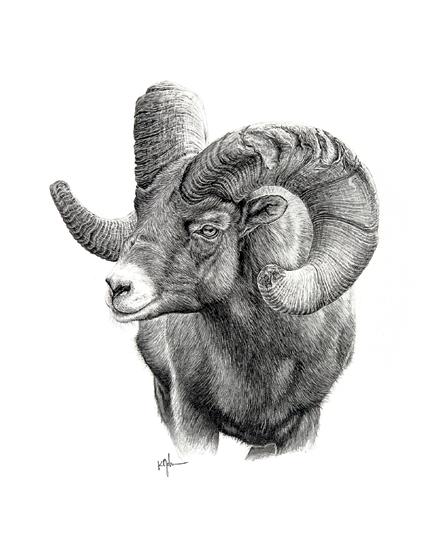
WHM: What is your favorite piece you’ve done?
Sanctum Lost
WHM: What is your favorite hunting memory?
KELSEY: Immediately, my mind goes to a few years ago at turkey camp which we shared with a big group including some friends and my brother. We were not raised hunting, and this was my first hunt with any family member. Everything was great; the perfect mix of crappy, humbling weather and inclement conditions, great company, my favorite landscape, and two tags filled for my husband, brother, and I. Throughout the weekend we also had some awesome wildlife encounters, including calling in a couple of coyotes to very close range and having an entire elk herd feed right past us as we sat through a calling scenario. It was just allaround a great memory.
KELSEY: My current favorite is “Sanctum Lost” which is available this year through the C.M. Russell Museum. In many ways, this piece was a milestone and embodies my ideal tone and subject matter. I specifically enjoy the reflective mood I was able to achieve with the color palette and balanced, focused composition.
To learn more about Kelsey and her artwork, visit kraeartworks.com or scan this QR code. p


Western Hunter Subscribers – Featured Artist Giveaway
We want to turn you into an art collector! One lucky subscriber will receive “While You Were Waking” and “The Whitetail” framed prints by Kelsey Rae Morris. All you have to do is subscribe to Western Hunter to be entered into our next drawing. Visit westernhunter.net to subscribe, renew, or give a gift subscription to a friend.

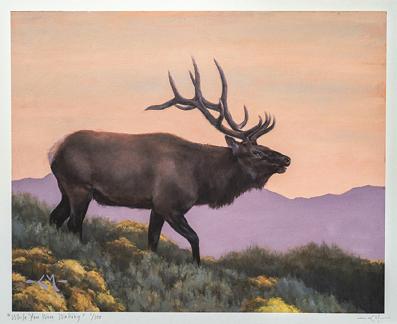

95 WESTERN HUNTER

THE WILD KITCHEN p Venison Spaghetti Sauce
By Lindsay Persico, Health & Fitness Editor

One of the great, go-to recipes in almost every home is spaghetti. I love making mine with our veni son as it tastes good but also increases the protein in this already surprisingly balanced meal. Using venison also cuts down on saturated fats, and I replace those fats in my sauce with olive oil, an ex cellent source of omega-3 fats. This venison spaghetti sauce is not only delicious but also quite healthy. I use regular ground venison in this recipe, but if you have venison Italian sausage, you could also use that. If you are using an already seasoned sausage for your sauce, you will want to cut your herbs and olive oil in half in this recipe. I add extra olive oil and herbs to the meat as I cook it because I am not using Italian sausage.
Ingredients
• 1 lb Venison Burger
• 1 28-oz can of Crushed Tomatoes
• 1 15-oz can of Tomato Sauce
• 1 Medium Onion – Diced
• 4 Tablespoons Olive Oil
• 1 Tablespoon Crushed Rosemary
• 1 Tablespoon Oregano
• 1 Tablespoon Basil
• 1 Tablespoon Crushed Fennel Seed
• 2 Teaspoons Thyme
• 2 Bay Leaves
• 1 Tablespoon Minced Garlic
• 2 Tablespoons Molasses (can be substituted with sugar)
• Salt and Pepper to taste
Instructions
In a large saucepan, heat olive oil over medium heat and sauté onion until translucent. Add garlic and sauté until fragrant. Add venison and half of the herbs except for the bay leaves. Cook until brown, stirring often. Add remaining ingredients and reduce heat to low. Cook on low, stirring occasionally, for two hours.
You can serve this sauce over conventional spaghetti noodles or over a protein-dense pasta alternative like red lentil pasta to increase the protein content. I like to serve this with broiled Italian bread topped with butter, granulated garlic, and Italian herbed sea salt.



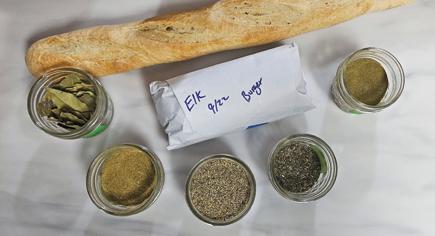


www.westernhunter.net 96 WESTERN HUNTER WESTERN HUNTER MAGAZINE
1 2 3
Heat olive oil and sauté onion until translucent. Add garlic and sauté until fragrant.
Add venison and half of the herbs except for the bay leaves.
Cook until venison is brown, stirring often.



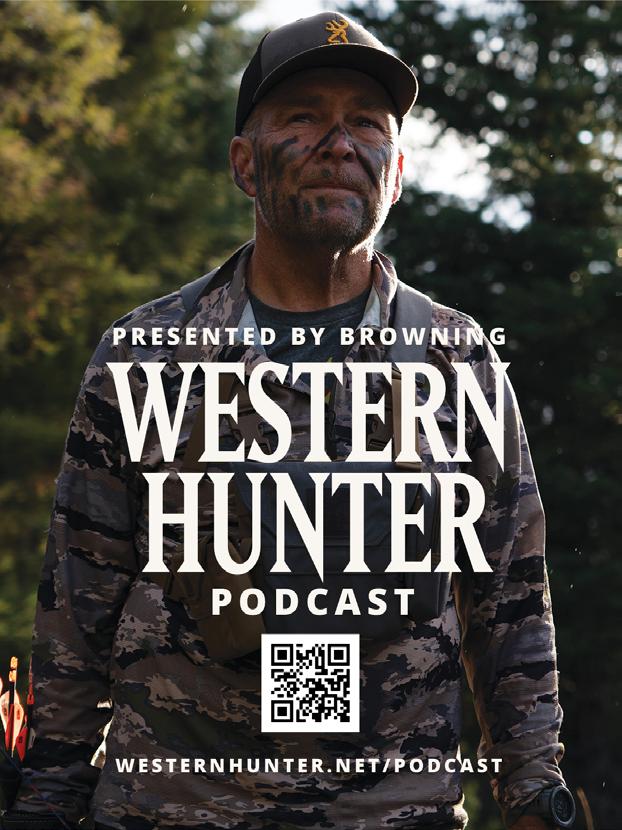

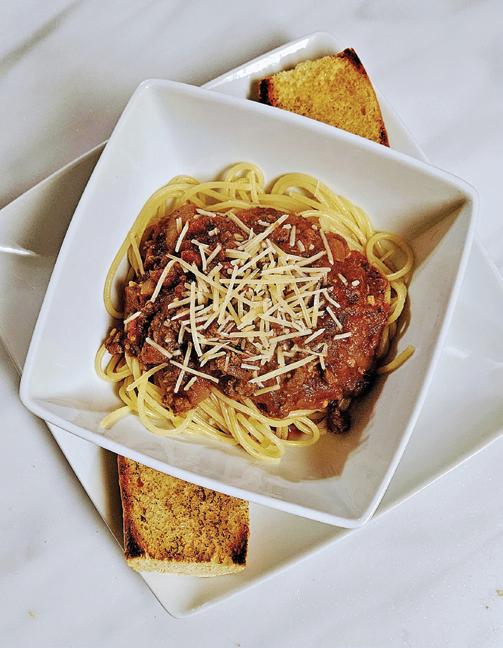
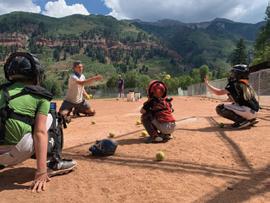



info@westernhunter.net 97 WESTERN HUNTER THE WILD KITCHEN p SWWBC Mountain Classic Tournament Age Groups 9u-18u, July 25-28, 2024 THE ULTIMATE OUTDOOR FAMILY BASEBALL VACATION! Baseball & Girls Softball Camps (ages 5-18) July 22-25, 2024 602-694-0976 TELLURIDEBASEBALLFESTIVAL.COM 4 Add the remaining ingredients and cook on low, stirring occasionally, for two hours. A protein-dense alternative like red lentil pasta is an easy way to increase the protein content. Enjoy! Spaghetti with venison sauce is not only delicious but also quite healthy.
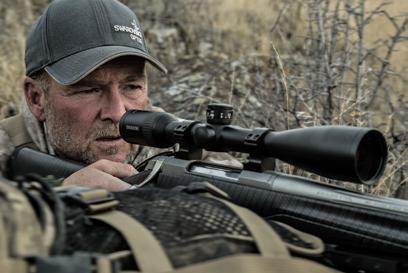
DIALING IT BACK
CHRIS DENHAM PUBLISHER
Boone and Crockett Club: FWS Announcement Moves Closer to a Solution on the Gray Wolf
The reintroduction of wolves and their expan sion across the western states is a controver sial topic among hunters, game departments, anti-hunters, and politicians. There is one enor mous user group that is left out of that list, and that is “non-hunters.” I am referring to the 80% of peo ple who all have a vote, but not a voice in the deci sion-making process. We hunters/conservationists do not have a majority, and if we ever hope to pre serve our hunting heritage, we need the support of this uninformed or ill-informed block of voters.
I decided to print this press release from The Boone and Crockett Club because it succinctly de fines the history of the Endangered Species Act (ESA) and the status of wolves in relation to those statutes. This is an excellent blueprint for a factbased conversation with non-hunters who are open to a non-emotional debate regarding wolf recovery.
For the record, I am not in favor of any expan sion of wolves outside the greater Yellowstone area, but that dream was long ago shattered. Our best hope is that future management decisions will be based on science, not emotions and politics. But when wildlife management does enter the political arena, we need the votes to prevail.

those who oppose delisting. Meanwhile, it has become increasingly clear that the growing wolf population cannot be managed effectively under ESA rules. Frustrated by this, others have initiated their own political and legal efforts in the opposite direction, proposing dramatic and unrealistic reductions in the number of wolves.
“The wolf has gone repeatedly back and forth from federal control under the ESA to state management under state laws,” Cummins continued. “This is no way to solve the problem and it’s a sure way to make the problem more difficult to solve.”
The Boone and Crockett Club will continue to support federal enforcement of the Endangered Species Act where population recovery is the goal and will continue to support excellence in state wildlife management where population sustainability is the goal.
As always, I would welcome and appreciate any comments.
Chris Denham, Publisher chris@westernhunter.net
MISSOULA, Mont. (February 5, 2024)
The Boone and Crockett Club applauds the U.S. Fish and Wildlife Service’s (FWS) announcement on Friday afternoon reaffirming its previous finding that the gray wolf in the Northern Rocky Mountains region faces no threat of extinction.
“The Fish and Wildlife Service got the right answer, again – as they have done repeatedly for the last 20 years,” said James L. Cummins, president of the Boone and Crockett Club, and a wildlife biologist by training.“The gray wolf population has met FWS recovery goals since 2003 and has not been at risk of extinction since before that time.”
Alongside the announcement on the gray wolves in the Northern Rocky Mountains region, the FWS announced the beginning of a new recovery plan for gray wolves throughout the lower 48 states. “It’s hard to understand why FWS has proposed a new recovery plan,” said Cummins. “The issue we face is not that the gray wolf may disappear, but that people disagree on how many wolves should roam the country – and where. The question is how best to manage sustainable wolf populations, not how to recover a species threatened with extinction. The Club supports a national consensus that would sustain the wolf population and manage their effect on other wildlife, and their risk to livestock and people. To accomplish this goal, each state must regain the authority to carry out its own management plan.”
Over the last 20 years, the FWS has repeatedly found that the gray wolf no longer needs the protection of the Endangered Species Act (ESA). Yet nearly all those science-based decisions have been undermined by the political and legal efforts of
“Citizens, states, the FWS, and Congress must all respect differing viewpoints,” said Cummins, “but it is time for scientific management to prevail over legal and tactical maneuvering. Our duty to find a science-based solution is more important than allowing a small group of others to prolong controversy by ignoring wildlife science for fundraising purposes and litigating at taxpayer expense. With this decision, we hope that all who want to have wolves on the land in a way that can be supported by all members of the community now will work constructively for the greater good.”
Cummins concluded,“The threat of extinction was the founding topic raised by Theodore Roosevelt at the first meeting of the Boone and Crockett Club, in 1887. Our early efforts restored the endangered species of that time to their abundance today. Our members later played central roles in developing and enacting the Endangered Species Act in the 1970s and more recently in creating incentivebased mechanisms to restore and protect their habitat. Our commitment has succeeded because we cherish all wildlife as American treasures, we prize the ability of Americans to do the work of sustaining our wildlife populations, and we base our work on science, not litigation.” p
www.westernhunter.net 98 WESTERN HUNTER



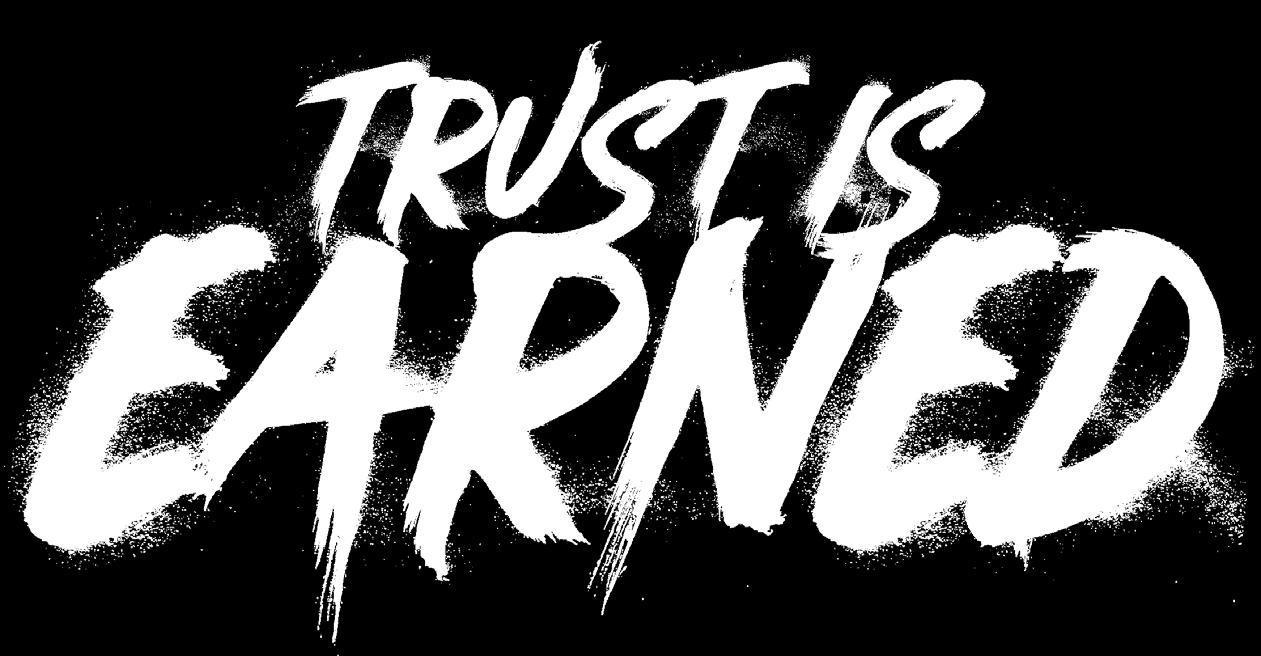
The VX-6HD 3-18 x 44 is built to outlast and outperform. While others warranty failure, we guarantee unmatched optical clarity and rugged reliability for life. Because at Leupold, failure is not an option.

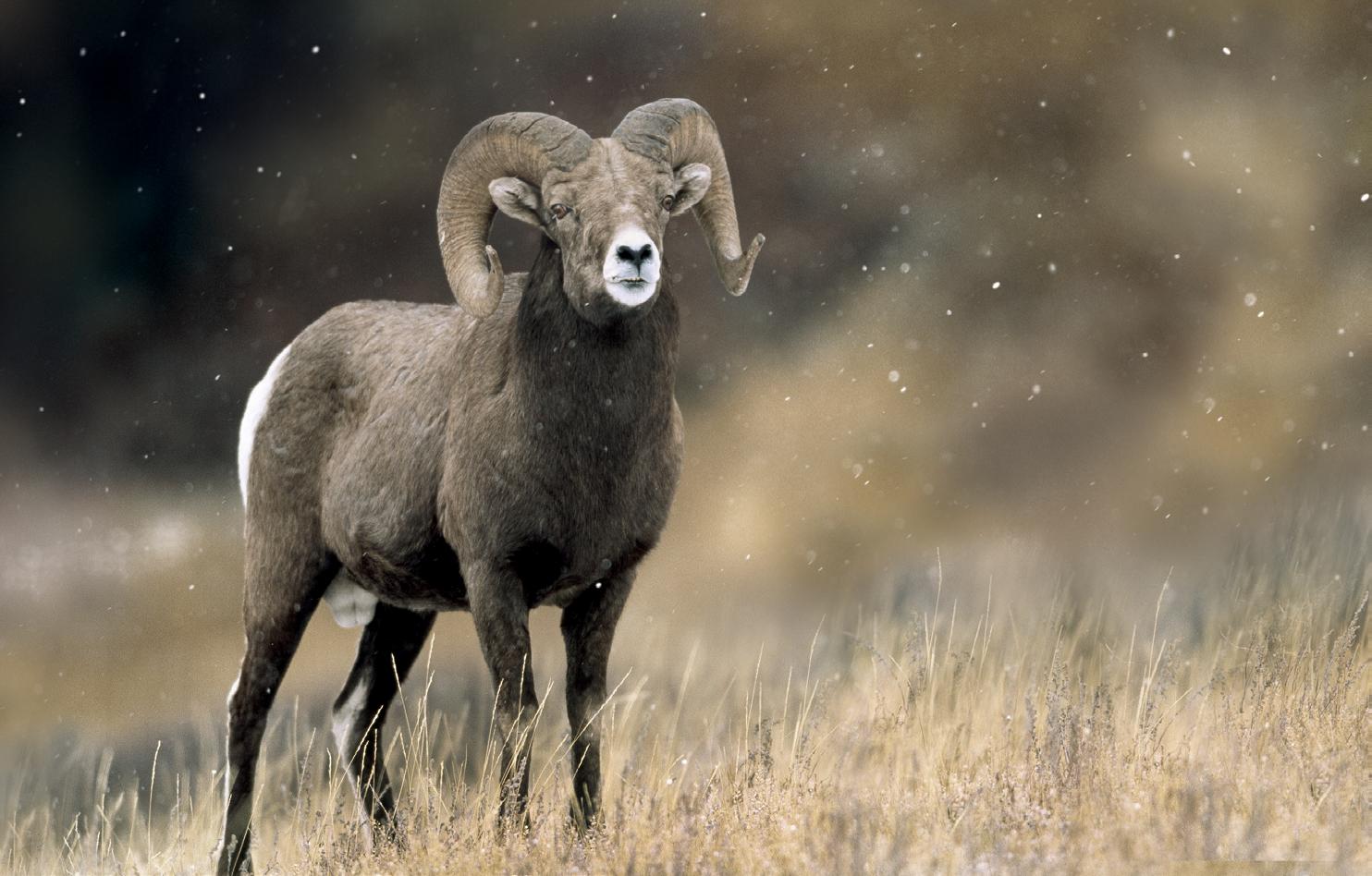



SEE THE UNSEEN
ADVENTURE AWAITS































 The backcountry float hunt of a lifetime
The backcountry float hunt of a lifetime


















 n After finding the buck she wanted, Kaysha made a great stalk and arrowed this great buck.
n After finding the buck she wanted, Kaysha made a great stalk and arrowed this great buck.























































































 HAVAK SLAM RIFLE
HAVAK SLAM RIFLE




















 BAGNOLI HUNTING & SHOOTING EDITOR
BAGNOLI HUNTING & SHOOTING EDITOR



























 MIKE DUPLAN HUNTING EDITOR
MIKE DUPLAN HUNTING EDITOR

































































































 FRED EICHLER HUNTING EDITOR
FRED EICHLER HUNTING EDITOR




























 PEDRAM PARVIN FIELD EDITOR
PEDRAM PARVIN FIELD EDITOR




































